The Relationship between Leadership Styles and Employee Performance
VerifiedAdded on 2019/12/04
|61
|22126
|44
Essay
AI Summary
The provided content includes a range of research articles, books, and online resources related to qualitative research, leadership styles, and project management. The texts discuss various topics such as the relationship between leadership styles and employee performance, matching project managers' leadership styles to project types, attitudes and leadership competencies for project success, and the impact of transformational leadership style on affective employees' commitment.
Contribute Materials
Your contribution can guide someone’s learning journey. Share your
documents today.

Dissertation - Modification
1
1
Secure Best Marks with AI Grader
Need help grading? Try our AI Grader for instant feedback on your assignments.
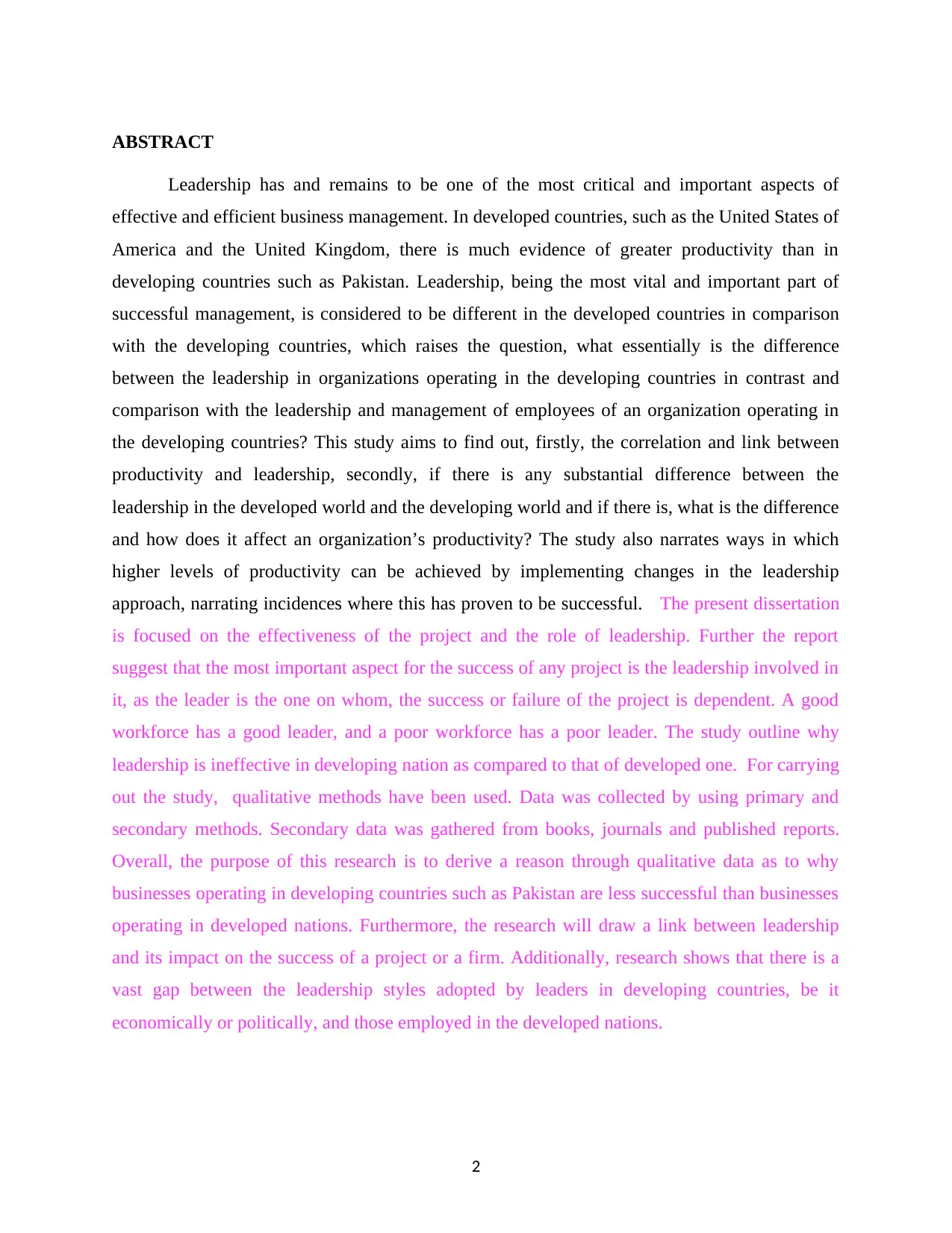
ABSTRACT
Leadership has and remains to be one of the most critical and important aspects of
effective and efficient business management. In developed countries, such as the United States of
America and the United Kingdom, there is much evidence of greater productivity than in
developing countries such as Pakistan. Leadership, being the most vital and important part of
successful management, is considered to be different in the developed countries in comparison
with the developing countries, which raises the question, what essentially is the difference
between the leadership in organizations operating in the developing countries in contrast and
comparison with the leadership and management of employees of an organization operating in
the developing countries? This study aims to find out, firstly, the correlation and link between
productivity and leadership, secondly, if there is any substantial difference between the
leadership in the developed world and the developing world and if there is, what is the difference
and how does it affect an organization’s productivity? The study also narrates ways in which
higher levels of productivity can be achieved by implementing changes in the leadership
approach, narrating incidences where this has proven to be successful. The present dissertation
is focused on the effectiveness of the project and the role of leadership. Further the report
suggest that the most important aspect for the success of any project is the leadership involved in
it, as the leader is the one on whom, the success or failure of the project is dependent. A good
workforce has a good leader, and a poor workforce has a poor leader. The study outline why
leadership is ineffective in developing nation as compared to that of developed one. For carrying
out the study, qualitative methods have been used. Data was collected by using primary and
secondary methods. Secondary data was gathered from books, journals and published reports.
Overall, the purpose of this research is to derive a reason through qualitative data as to why
businesses operating in developing countries such as Pakistan are less successful than businesses
operating in developed nations. Furthermore, the research will draw a link between leadership
and its impact on the success of a project or a firm. Additionally, research shows that there is a
vast gap between the leadership styles adopted by leaders in developing countries, be it
economically or politically, and those employed in the developed nations.
2
Leadership has and remains to be one of the most critical and important aspects of
effective and efficient business management. In developed countries, such as the United States of
America and the United Kingdom, there is much evidence of greater productivity than in
developing countries such as Pakistan. Leadership, being the most vital and important part of
successful management, is considered to be different in the developed countries in comparison
with the developing countries, which raises the question, what essentially is the difference
between the leadership in organizations operating in the developing countries in contrast and
comparison with the leadership and management of employees of an organization operating in
the developing countries? This study aims to find out, firstly, the correlation and link between
productivity and leadership, secondly, if there is any substantial difference between the
leadership in the developed world and the developing world and if there is, what is the difference
and how does it affect an organization’s productivity? The study also narrates ways in which
higher levels of productivity can be achieved by implementing changes in the leadership
approach, narrating incidences where this has proven to be successful. The present dissertation
is focused on the effectiveness of the project and the role of leadership. Further the report
suggest that the most important aspect for the success of any project is the leadership involved in
it, as the leader is the one on whom, the success or failure of the project is dependent. A good
workforce has a good leader, and a poor workforce has a poor leader. The study outline why
leadership is ineffective in developing nation as compared to that of developed one. For carrying
out the study, qualitative methods have been used. Data was collected by using primary and
secondary methods. Secondary data was gathered from books, journals and published reports.
Overall, the purpose of this research is to derive a reason through qualitative data as to why
businesses operating in developing countries such as Pakistan are less successful than businesses
operating in developed nations. Furthermore, the research will draw a link between leadership
and its impact on the success of a project or a firm. Additionally, research shows that there is a
vast gap between the leadership styles adopted by leaders in developing countries, be it
economically or politically, and those employed in the developed nations.
2
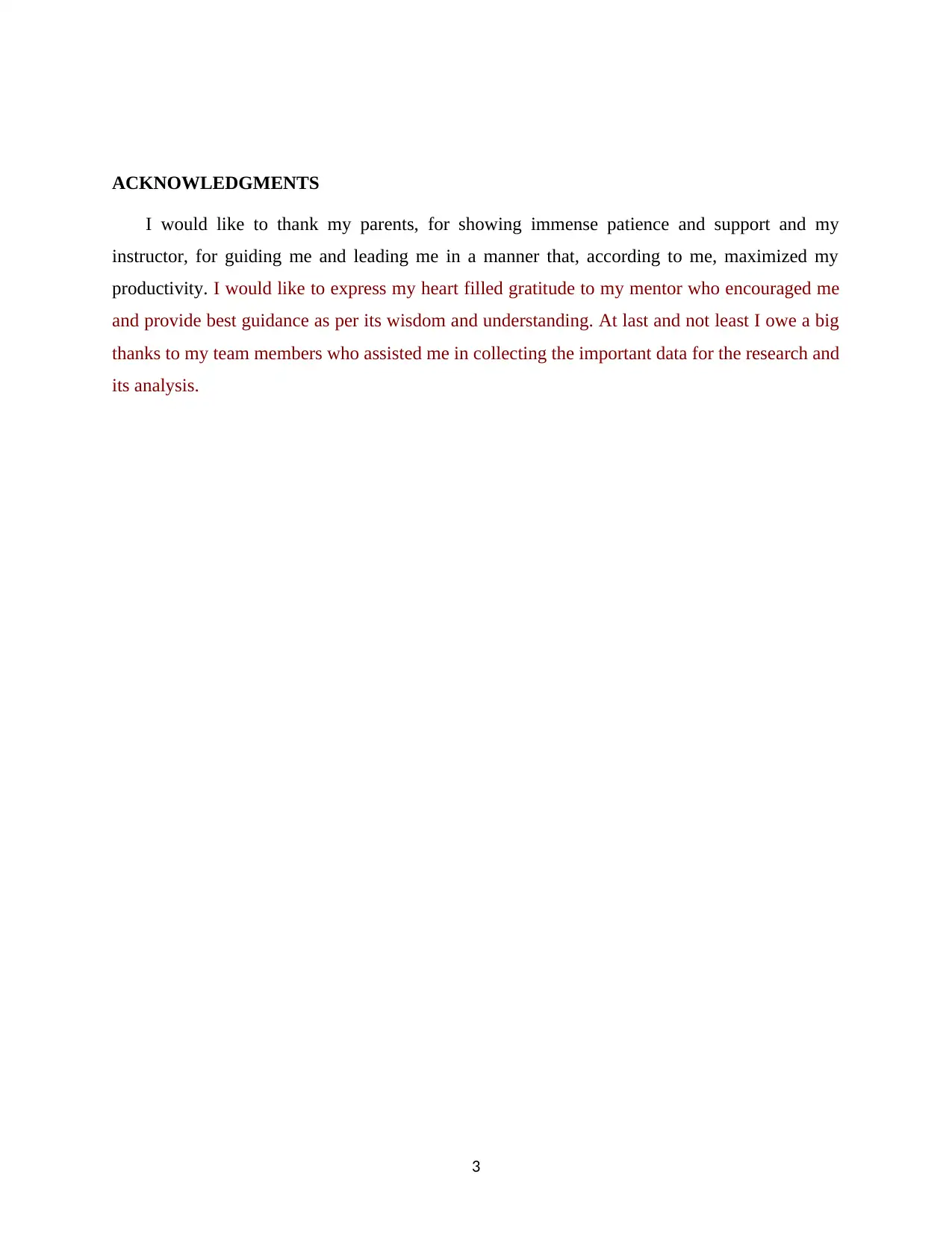
ACKNOWLEDGMENTS
I would like to thank my parents, for showing immense patience and support and my
instructor, for guiding me and leading me in a manner that, according to me, maximized my
productivity. I would like to express my heart filled gratitude to my mentor who encouraged me
and provide best guidance as per its wisdom and understanding. At last and not least I owe a big
thanks to my team members who assisted me in collecting the important data for the research and
its analysis.
3
I would like to thank my parents, for showing immense patience and support and my
instructor, for guiding me and leading me in a manner that, according to me, maximized my
productivity. I would like to express my heart filled gratitude to my mentor who encouraged me
and provide best guidance as per its wisdom and understanding. At last and not least I owe a big
thanks to my team members who assisted me in collecting the important data for the research and
its analysis.
3
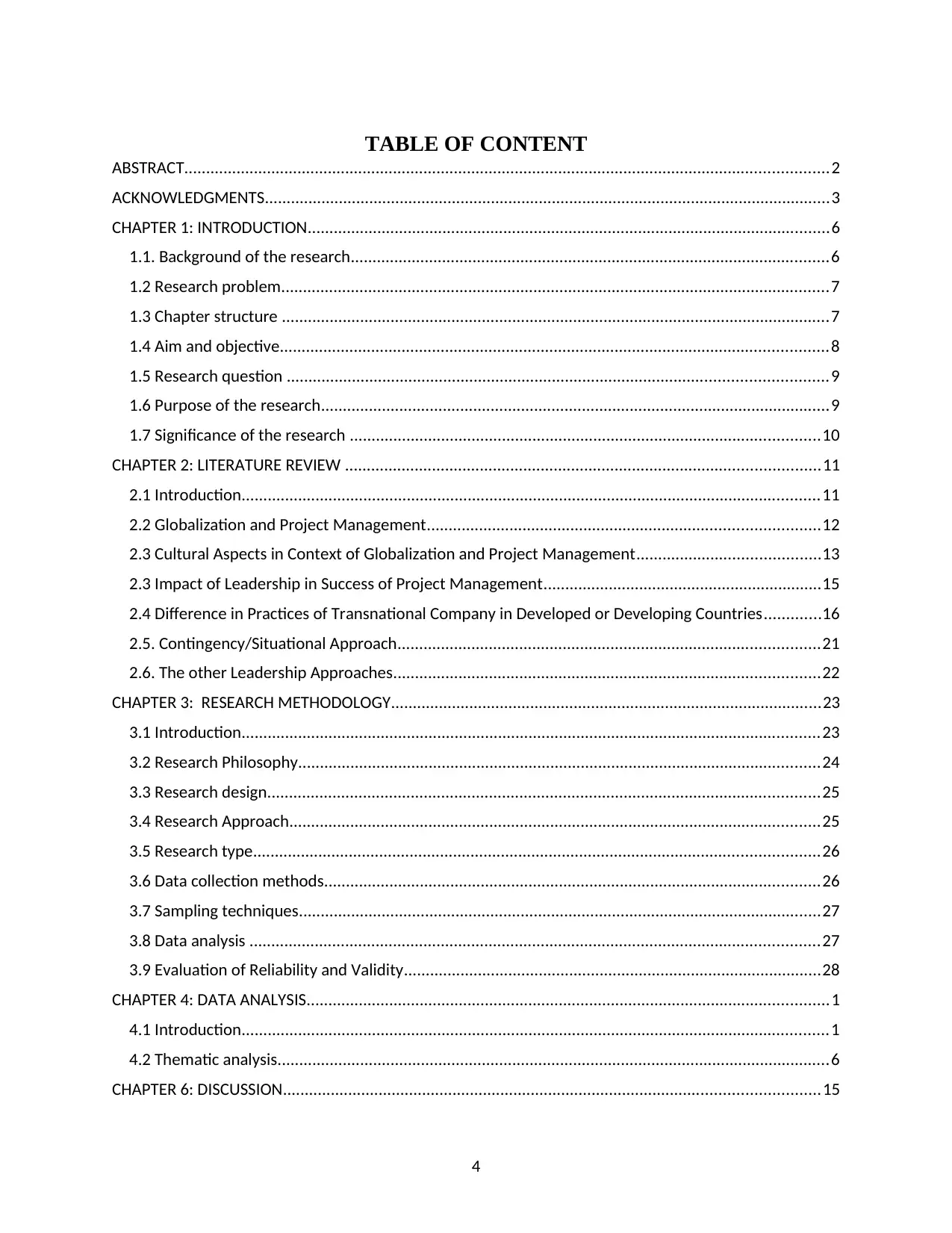
TABLE OF CONTENT
ABSTRACT....................................................................................................................................................2
ACKNOWLEDGMENTS..................................................................................................................................3
CHAPTER 1: INTRODUCTION........................................................................................................................6
1.1. Background of the research..............................................................................................................6
1.2 Research problem..............................................................................................................................7
1.3 Chapter structure ..............................................................................................................................7
1.4 Aim and objective..............................................................................................................................8
1.5 Research question ............................................................................................................................9
1.6 Purpose of the research.....................................................................................................................9
1.7 Significance of the research ............................................................................................................10
CHAPTER 2: LITERATURE REVIEW .............................................................................................................11
2.1 Introduction.....................................................................................................................................11
2.2 Globalization and Project Management..........................................................................................12
2.3 Cultural Aspects in Context of Globalization and Project Management..........................................13
2.3 Impact of Leadership in Success of Project Management................................................................15
2.4 Difference in Practices of Transnational Company in Developed or Developing Countries.............16
2.5. Contingency/Situational Approach.................................................................................................21
2.6. The other Leadership Approaches..................................................................................................22
CHAPTER 3: RESEARCH METHODOLOGY...................................................................................................23
3.1 Introduction.....................................................................................................................................23
3.2 Research Philosophy........................................................................................................................24
3.3 Research design...............................................................................................................................25
3.4 Research Approach..........................................................................................................................25
3.5 Research type..................................................................................................................................26
3.6 Data collection methods..................................................................................................................26
3.7 Sampling techniques........................................................................................................................27
3.8 Data analysis ...................................................................................................................................27
3.9 Evaluation of Reliability and Validity................................................................................................28
CHAPTER 4: DATA ANALYSIS........................................................................................................................1
4.1 Introduction.......................................................................................................................................1
4.2 Thematic analysis...............................................................................................................................6
CHAPTER 6: DISCUSSION...........................................................................................................................15
4
ABSTRACT....................................................................................................................................................2
ACKNOWLEDGMENTS..................................................................................................................................3
CHAPTER 1: INTRODUCTION........................................................................................................................6
1.1. Background of the research..............................................................................................................6
1.2 Research problem..............................................................................................................................7
1.3 Chapter structure ..............................................................................................................................7
1.4 Aim and objective..............................................................................................................................8
1.5 Research question ............................................................................................................................9
1.6 Purpose of the research.....................................................................................................................9
1.7 Significance of the research ............................................................................................................10
CHAPTER 2: LITERATURE REVIEW .............................................................................................................11
2.1 Introduction.....................................................................................................................................11
2.2 Globalization and Project Management..........................................................................................12
2.3 Cultural Aspects in Context of Globalization and Project Management..........................................13
2.3 Impact of Leadership in Success of Project Management................................................................15
2.4 Difference in Practices of Transnational Company in Developed or Developing Countries.............16
2.5. Contingency/Situational Approach.................................................................................................21
2.6. The other Leadership Approaches..................................................................................................22
CHAPTER 3: RESEARCH METHODOLOGY...................................................................................................23
3.1 Introduction.....................................................................................................................................23
3.2 Research Philosophy........................................................................................................................24
3.3 Research design...............................................................................................................................25
3.4 Research Approach..........................................................................................................................25
3.5 Research type..................................................................................................................................26
3.6 Data collection methods..................................................................................................................26
3.7 Sampling techniques........................................................................................................................27
3.8 Data analysis ...................................................................................................................................27
3.9 Evaluation of Reliability and Validity................................................................................................28
CHAPTER 4: DATA ANALYSIS........................................................................................................................1
4.1 Introduction.......................................................................................................................................1
4.2 Thematic analysis...............................................................................................................................6
CHAPTER 6: DISCUSSION...........................................................................................................................15
4
Paraphrase This Document
Need a fresh take? Get an instant paraphrase of this document with our AI Paraphraser

CHAPTER 7: CONCLUSION AND RECOMMENDATIONS..............................................................................18
5.1 Introduction.....................................................................................................................................18
5.2 Conclusion.......................................................................................................................................18
5.3 Recommendation............................................................................................................................21
CHAPTER 8: REFLECTIVE CHAPTER.............................................................................................................23
6.1. Introduction....................................................................................................................................23
6.2. The Concept of Project Leadership.................................................................................................23
6.3. Project Leadership Skills (Analysis of Leadership styles and theories adopted by Pakistani Leaders)
...............................................................................................................................................................25
6.4. Leadership Theory..........................................................................................................................27
6.4.1. Trait Approach.............................................................................................................................28
6.4.2. Behavioral Approach....................................................................................................................28
6.4.3. Situational Approaches to Leadership.........................................................................................28
5
5.1 Introduction.....................................................................................................................................18
5.2 Conclusion.......................................................................................................................................18
5.3 Recommendation............................................................................................................................21
CHAPTER 8: REFLECTIVE CHAPTER.............................................................................................................23
6.1. Introduction....................................................................................................................................23
6.2. The Concept of Project Leadership.................................................................................................23
6.3. Project Leadership Skills (Analysis of Leadership styles and theories adopted by Pakistani Leaders)
...............................................................................................................................................................25
6.4. Leadership Theory..........................................................................................................................27
6.4.1. Trait Approach.............................................................................................................................28
6.4.2. Behavioral Approach....................................................................................................................28
6.4.3. Situational Approaches to Leadership.........................................................................................28
5
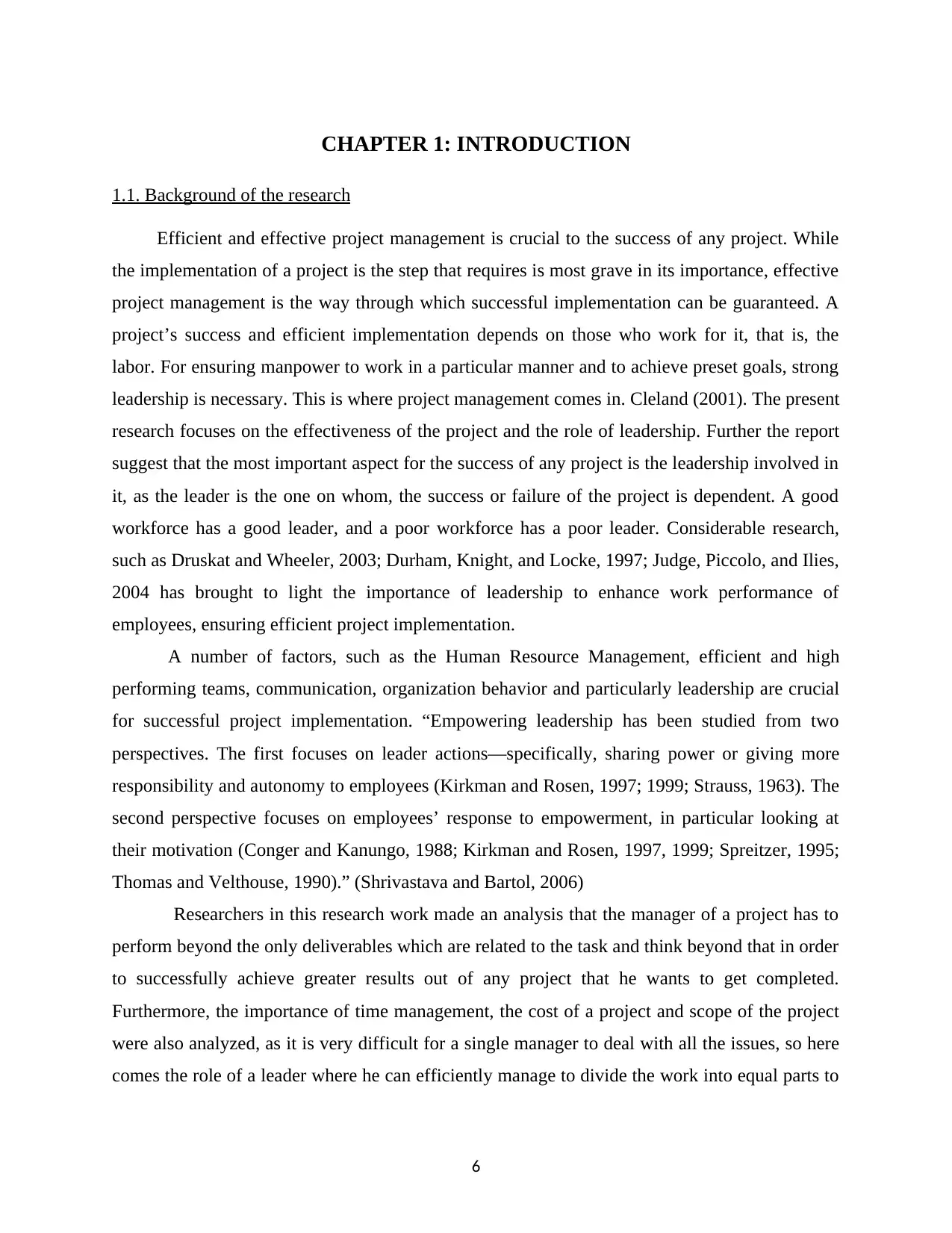
CHAPTER 1: INTRODUCTION
1.1. Background of the research
Efficient and effective project management is crucial to the success of any project. While
the implementation of a project is the step that requires is most grave in its importance, effective
project management is the way through which successful implementation can be guaranteed. A
project’s success and efficient implementation depends on those who work for it, that is, the
labor. For ensuring manpower to work in a particular manner and to achieve preset goals, strong
leadership is necessary. This is where project management comes in. Cleland (2001). The present
research focuses on the effectiveness of the project and the role of leadership. Further the report
suggest that the most important aspect for the success of any project is the leadership involved in
it, as the leader is the one on whom, the success or failure of the project is dependent. A good
workforce has a good leader, and a poor workforce has a poor leader. Considerable research,
such as Druskat and Wheeler, 2003; Durham, Knight, and Locke, 1997; Judge, Piccolo, and Ilies,
2004 has brought to light the importance of leadership to enhance work performance of
employees, ensuring efficient project implementation.
A number of factors, such as the Human Resource Management, efficient and high
performing teams, communication, organization behavior and particularly leadership are crucial
for successful project implementation. “Empowering leadership has been studied from two
perspectives. The first focuses on leader actions—specifically, sharing power or giving more
responsibility and autonomy to employees (Kirkman and Rosen, 1997; 1999; Strauss, 1963). The
second perspective focuses on employees’ response to empowerment, in particular looking at
their motivation (Conger and Kanungo, 1988; Kirkman and Rosen, 1997, 1999; Spreitzer, 1995;
Thomas and Velthouse, 1990).” (Shrivastava and Bartol, 2006)
Researchers in this research work made an analysis that the manager of a project has to
perform beyond the only deliverables which are related to the task and think beyond that in order
to successfully achieve greater results out of any project that he wants to get completed.
Furthermore, the importance of time management, the cost of a project and scope of the project
were also analyzed, as it is very difficult for a single manager to deal with all the issues, so here
comes the role of a leader where he can efficiently manage to divide the work into equal parts to
6
1.1. Background of the research
Efficient and effective project management is crucial to the success of any project. While
the implementation of a project is the step that requires is most grave in its importance, effective
project management is the way through which successful implementation can be guaranteed. A
project’s success and efficient implementation depends on those who work for it, that is, the
labor. For ensuring manpower to work in a particular manner and to achieve preset goals, strong
leadership is necessary. This is where project management comes in. Cleland (2001). The present
research focuses on the effectiveness of the project and the role of leadership. Further the report
suggest that the most important aspect for the success of any project is the leadership involved in
it, as the leader is the one on whom, the success or failure of the project is dependent. A good
workforce has a good leader, and a poor workforce has a poor leader. Considerable research,
such as Druskat and Wheeler, 2003; Durham, Knight, and Locke, 1997; Judge, Piccolo, and Ilies,
2004 has brought to light the importance of leadership to enhance work performance of
employees, ensuring efficient project implementation.
A number of factors, such as the Human Resource Management, efficient and high
performing teams, communication, organization behavior and particularly leadership are crucial
for successful project implementation. “Empowering leadership has been studied from two
perspectives. The first focuses on leader actions—specifically, sharing power or giving more
responsibility and autonomy to employees (Kirkman and Rosen, 1997; 1999; Strauss, 1963). The
second perspective focuses on employees’ response to empowerment, in particular looking at
their motivation (Conger and Kanungo, 1988; Kirkman and Rosen, 1997, 1999; Spreitzer, 1995;
Thomas and Velthouse, 1990).” (Shrivastava and Bartol, 2006)
Researchers in this research work made an analysis that the manager of a project has to
perform beyond the only deliverables which are related to the task and think beyond that in order
to successfully achieve greater results out of any project that he wants to get completed.
Furthermore, the importance of time management, the cost of a project and scope of the project
were also analyzed, as it is very difficult for a single manager to deal with all the issues, so here
comes the role of a leader where he can efficiently manage to divide the work into equal parts to
6
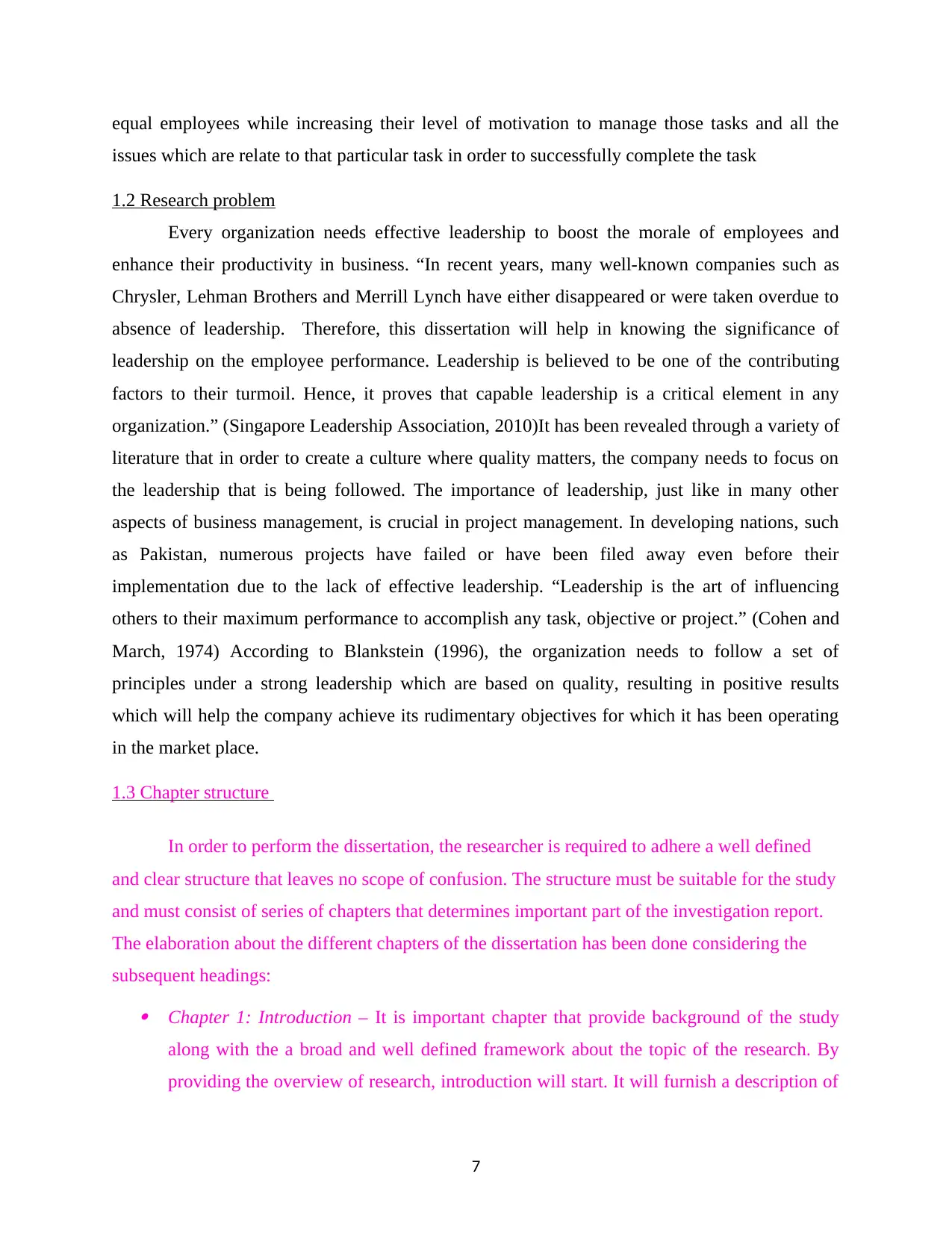
equal employees while increasing their level of motivation to manage those tasks and all the
issues which are relate to that particular task in order to successfully complete the task
1.2 Research problem
Every organization needs effective leadership to boost the morale of employees and
enhance their productivity in business. “In recent years, many well-known companies such as
Chrysler, Lehman Brothers and Merrill Lynch have either disappeared or were taken overdue to
absence of leadership. Therefore, this dissertation will help in knowing the significance of
leadership on the employee performance. Leadership is believed to be one of the contributing
factors to their turmoil. Hence, it proves that capable leadership is a critical element in any
organization.” (Singapore Leadership Association, 2010)It has been revealed through a variety of
literature that in order to create a culture where quality matters, the company needs to focus on
the leadership that is being followed. The importance of leadership, just like in many other
aspects of business management, is crucial in project management. In developing nations, such
as Pakistan, numerous projects have failed or have been filed away even before their
implementation due to the lack of effective leadership. “Leadership is the art of influencing
others to their maximum performance to accomplish any task, objective or project.” (Cohen and
March, 1974) According to Blankstein (1996), the organization needs to follow a set of
principles under a strong leadership which are based on quality, resulting in positive results
which will help the company achieve its rudimentary objectives for which it has been operating
in the market place.
1.3 Chapter structure
In order to perform the dissertation, the researcher is required to adhere a well defined
and clear structure that leaves no scope of confusion. The structure must be suitable for the study
and must consist of series of chapters that determines important part of the investigation report.
The elaboration about the different chapters of the dissertation has been done considering the
subsequent headings: Chapter 1: Introduction – It is important chapter that provide background of the study
along with the a broad and well defined framework about the topic of the research. By
providing the overview of research, introduction will start. It will furnish a description of
7
issues which are relate to that particular task in order to successfully complete the task
1.2 Research problem
Every organization needs effective leadership to boost the morale of employees and
enhance their productivity in business. “In recent years, many well-known companies such as
Chrysler, Lehman Brothers and Merrill Lynch have either disappeared or were taken overdue to
absence of leadership. Therefore, this dissertation will help in knowing the significance of
leadership on the employee performance. Leadership is believed to be one of the contributing
factors to their turmoil. Hence, it proves that capable leadership is a critical element in any
organization.” (Singapore Leadership Association, 2010)It has been revealed through a variety of
literature that in order to create a culture where quality matters, the company needs to focus on
the leadership that is being followed. The importance of leadership, just like in many other
aspects of business management, is crucial in project management. In developing nations, such
as Pakistan, numerous projects have failed or have been filed away even before their
implementation due to the lack of effective leadership. “Leadership is the art of influencing
others to their maximum performance to accomplish any task, objective or project.” (Cohen and
March, 1974) According to Blankstein (1996), the organization needs to follow a set of
principles under a strong leadership which are based on quality, resulting in positive results
which will help the company achieve its rudimentary objectives for which it has been operating
in the market place.
1.3 Chapter structure
In order to perform the dissertation, the researcher is required to adhere a well defined
and clear structure that leaves no scope of confusion. The structure must be suitable for the study
and must consist of series of chapters that determines important part of the investigation report.
The elaboration about the different chapters of the dissertation has been done considering the
subsequent headings: Chapter 1: Introduction – It is important chapter that provide background of the study
along with the a broad and well defined framework about the topic of the research. By
providing the overview of research, introduction will start. It will furnish a description of
7
Secure Best Marks with AI Grader
Need help grading? Try our AI Grader for instant feedback on your assignments.
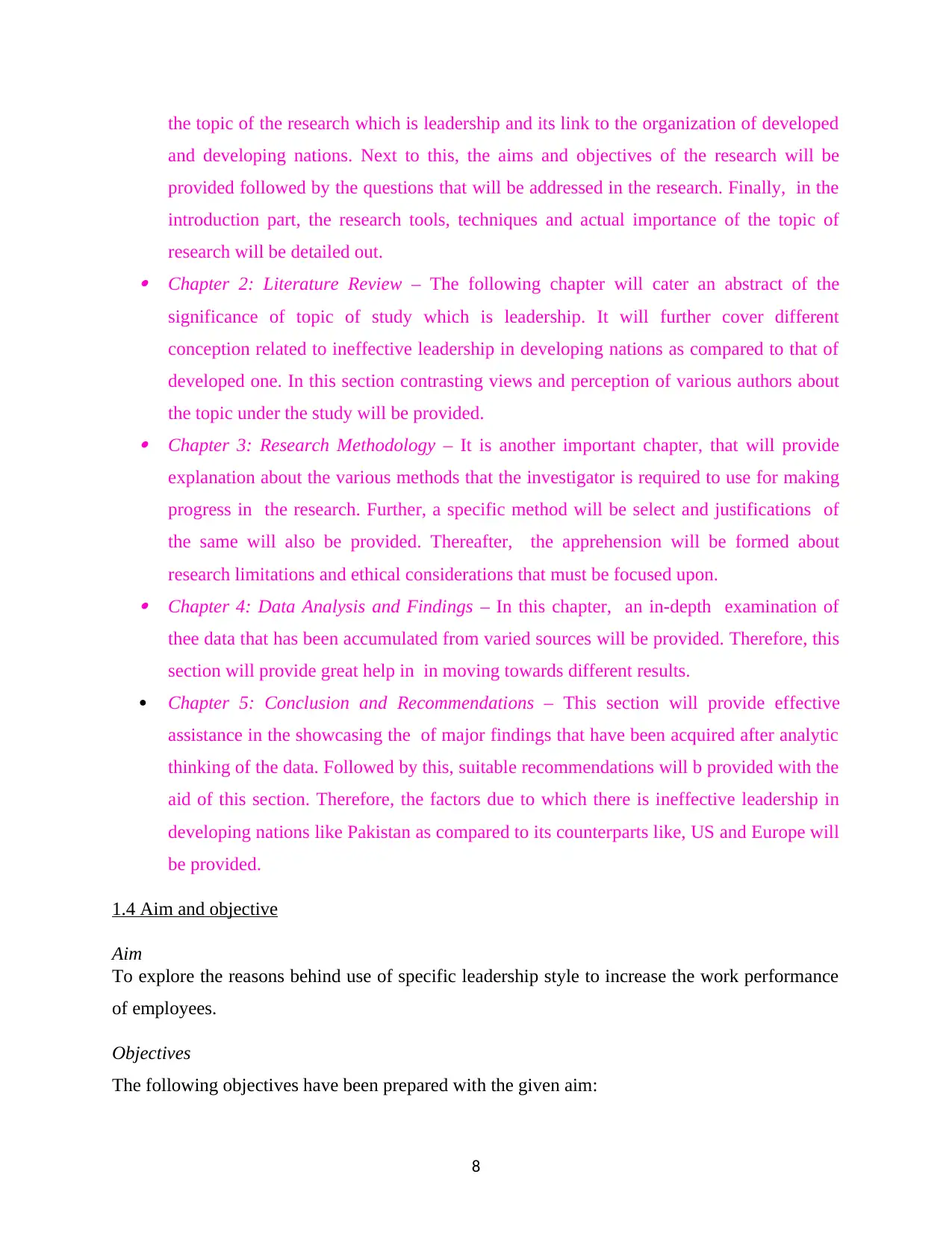
the topic of the research which is leadership and its link to the organization of developed
and developing nations. Next to this, the aims and objectives of the research will be
provided followed by the questions that will be addressed in the research. Finally, in the
introduction part, the research tools, techniques and actual importance of the topic of
research will be detailed out. Chapter 2: Literature Review – The following chapter will cater an abstract of the
significance of topic of study which is leadership. It will further cover different
conception related to ineffective leadership in developing nations as compared to that of
developed one. In this section contrasting views and perception of various authors about
the topic under the study will be provided. Chapter 3: Research Methodology – It is another important chapter, that will provide
explanation about the various methods that the investigator is required to use for making
progress in the research. Further, a specific method will be select and justifications of
the same will also be provided. Thereafter, the apprehension will be formed about
research limitations and ethical considerations that must be focused upon. Chapter 4: Data Analysis and Findings – In this chapter, an in-depth examination of
thee data that has been accumulated from varied sources will be provided. Therefore, this
section will provide great help in in moving towards different results.
Chapter 5: Conclusion and Recommendations – This section will provide effective
assistance in the showcasing the of major findings that have been acquired after analytic
thinking of the data. Followed by this, suitable recommendations will b provided with the
aid of this section. Therefore, the factors due to which there is ineffective leadership in
developing nations like Pakistan as compared to its counterparts like, US and Europe will
be provided.
1.4 Aim and objective
Aim
To explore the reasons behind use of specific leadership style to increase the work performance
of employees.
Objectives
The following objectives have been prepared with the given aim:
8
and developing nations. Next to this, the aims and objectives of the research will be
provided followed by the questions that will be addressed in the research. Finally, in the
introduction part, the research tools, techniques and actual importance of the topic of
research will be detailed out. Chapter 2: Literature Review – The following chapter will cater an abstract of the
significance of topic of study which is leadership. It will further cover different
conception related to ineffective leadership in developing nations as compared to that of
developed one. In this section contrasting views and perception of various authors about
the topic under the study will be provided. Chapter 3: Research Methodology – It is another important chapter, that will provide
explanation about the various methods that the investigator is required to use for making
progress in the research. Further, a specific method will be select and justifications of
the same will also be provided. Thereafter, the apprehension will be formed about
research limitations and ethical considerations that must be focused upon. Chapter 4: Data Analysis and Findings – In this chapter, an in-depth examination of
thee data that has been accumulated from varied sources will be provided. Therefore, this
section will provide great help in in moving towards different results.
Chapter 5: Conclusion and Recommendations – This section will provide effective
assistance in the showcasing the of major findings that have been acquired after analytic
thinking of the data. Followed by this, suitable recommendations will b provided with the
aid of this section. Therefore, the factors due to which there is ineffective leadership in
developing nations like Pakistan as compared to its counterparts like, US and Europe will
be provided.
1.4 Aim and objective
Aim
To explore the reasons behind use of specific leadership style to increase the work performance
of employees.
Objectives
The following objectives have been prepared with the given aim:
8
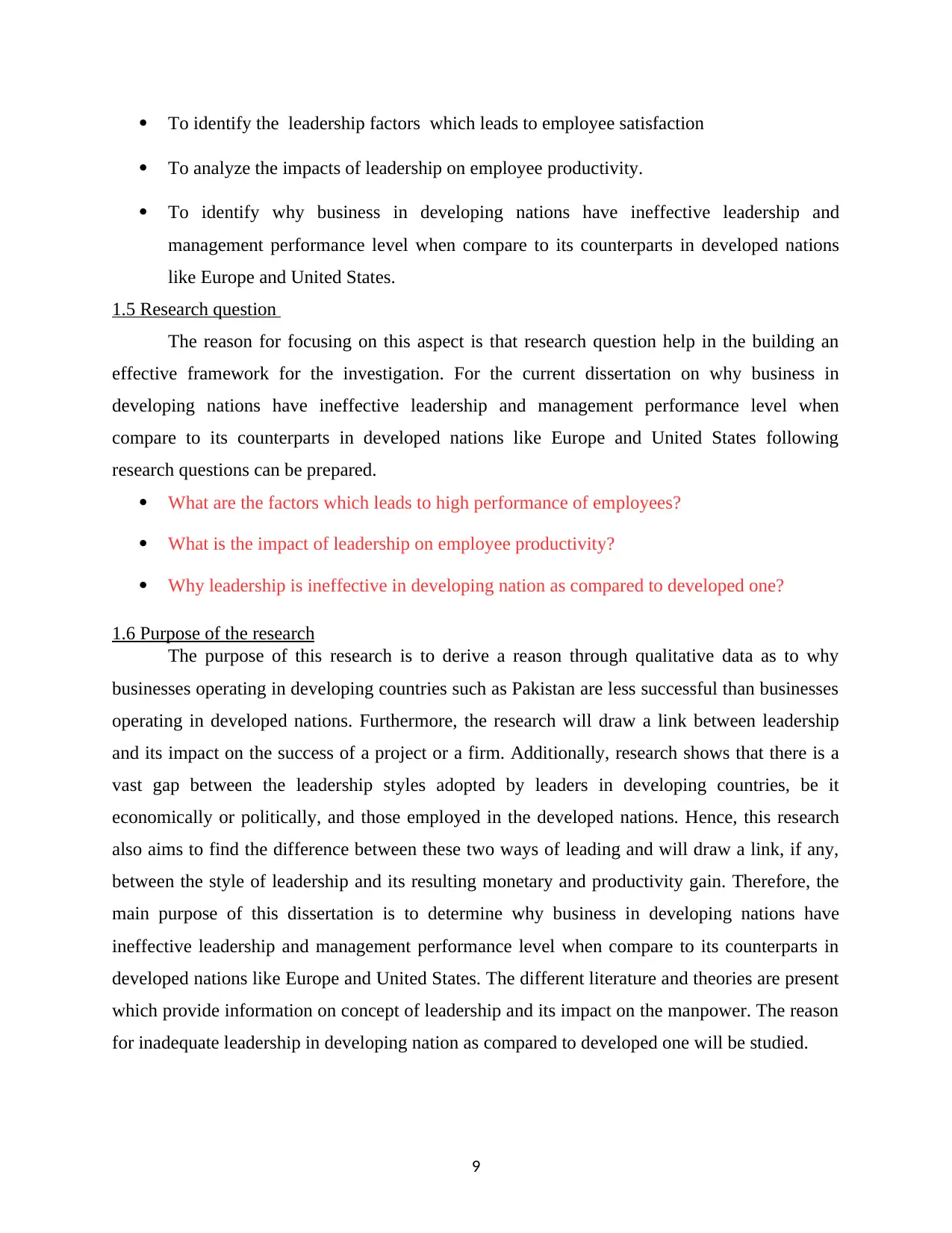
To identify the leadership factors which leads to employee satisfaction
To analyze the impacts of leadership on employee productivity.
To identify why business in developing nations have ineffective leadership and
management performance level when compare to its counterparts in developed nations
like Europe and United States.
1.5 Research question
The reason for focusing on this aspect is that research question help in the building an
effective framework for the investigation. For the current dissertation on why business in
developing nations have ineffective leadership and management performance level when
compare to its counterparts in developed nations like Europe and United States following
research questions can be prepared.
What are the factors which leads to high performance of employees?
What is the impact of leadership on employee productivity?
Why leadership is ineffective in developing nation as compared to developed one?
1.6 Purpose of the research
The purpose of this research is to derive a reason through qualitative data as to why
businesses operating in developing countries such as Pakistan are less successful than businesses
operating in developed nations. Furthermore, the research will draw a link between leadership
and its impact on the success of a project or a firm. Additionally, research shows that there is a
vast gap between the leadership styles adopted by leaders in developing countries, be it
economically or politically, and those employed in the developed nations. Hence, this research
also aims to find the difference between these two ways of leading and will draw a link, if any,
between the style of leadership and its resulting monetary and productivity gain. Therefore, the
main purpose of this dissertation is to determine why business in developing nations have
ineffective leadership and management performance level when compare to its counterparts in
developed nations like Europe and United States. The different literature and theories are present
which provide information on concept of leadership and its impact on the manpower. The reason
for inadequate leadership in developing nation as compared to developed one will be studied.
9
To analyze the impacts of leadership on employee productivity.
To identify why business in developing nations have ineffective leadership and
management performance level when compare to its counterparts in developed nations
like Europe and United States.
1.5 Research question
The reason for focusing on this aspect is that research question help in the building an
effective framework for the investigation. For the current dissertation on why business in
developing nations have ineffective leadership and management performance level when
compare to its counterparts in developed nations like Europe and United States following
research questions can be prepared.
What are the factors which leads to high performance of employees?
What is the impact of leadership on employee productivity?
Why leadership is ineffective in developing nation as compared to developed one?
1.6 Purpose of the research
The purpose of this research is to derive a reason through qualitative data as to why
businesses operating in developing countries such as Pakistan are less successful than businesses
operating in developed nations. Furthermore, the research will draw a link between leadership
and its impact on the success of a project or a firm. Additionally, research shows that there is a
vast gap between the leadership styles adopted by leaders in developing countries, be it
economically or politically, and those employed in the developed nations. Hence, this research
also aims to find the difference between these two ways of leading and will draw a link, if any,
between the style of leadership and its resulting monetary and productivity gain. Therefore, the
main purpose of this dissertation is to determine why business in developing nations have
ineffective leadership and management performance level when compare to its counterparts in
developed nations like Europe and United States. The different literature and theories are present
which provide information on concept of leadership and its impact on the manpower. The reason
for inadequate leadership in developing nation as compared to developed one will be studied.
9
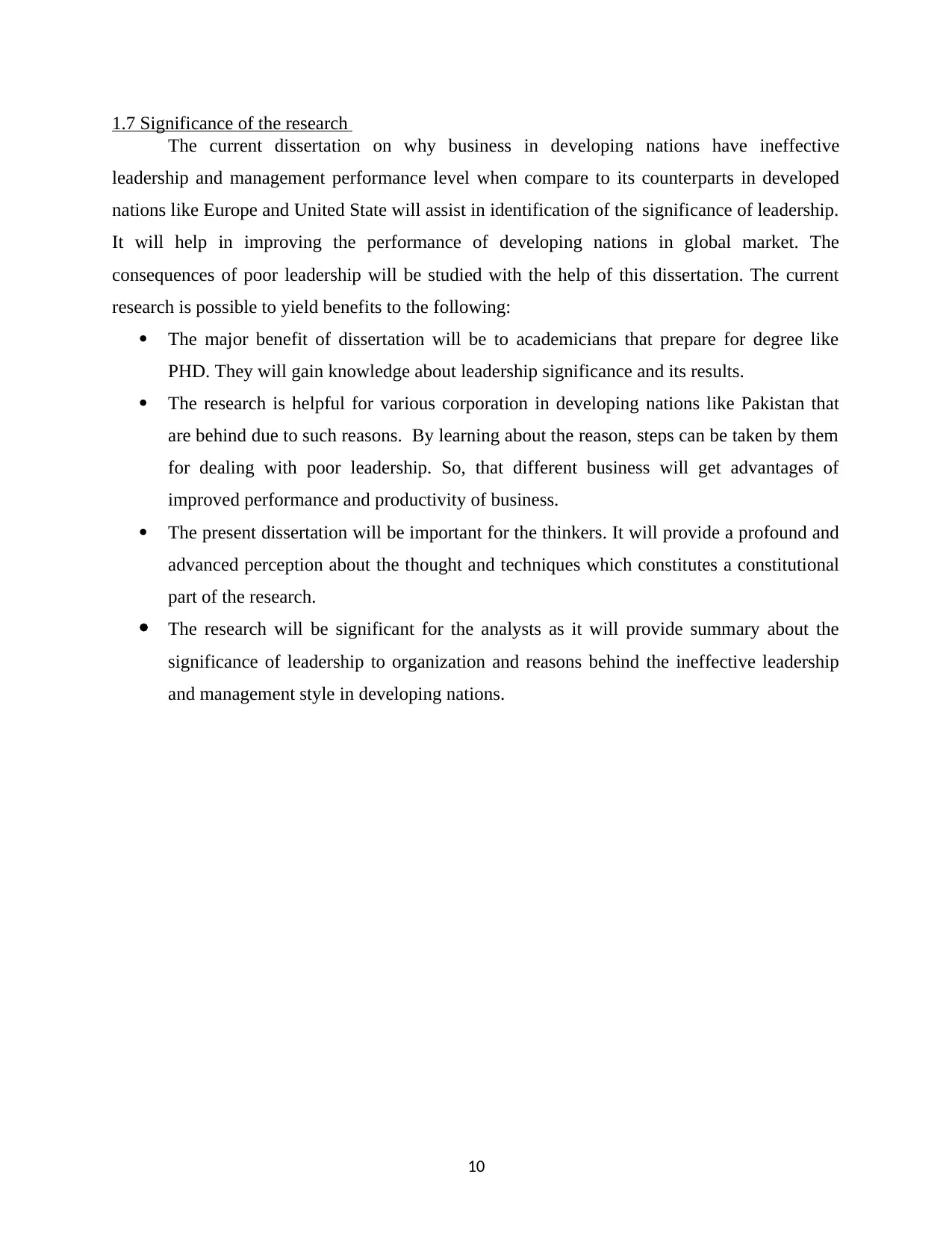
1.7 Significance of the research
The current dissertation on why business in developing nations have ineffective
leadership and management performance level when compare to its counterparts in developed
nations like Europe and United State will assist in identification of the significance of leadership.
It will help in improving the performance of developing nations in global market. The
consequences of poor leadership will be studied with the help of this dissertation. The current
research is possible to yield benefits to the following:
The major benefit of dissertation will be to academicians that prepare for degree like
PHD. They will gain knowledge about leadership significance and its results.
The research is helpful for various corporation in developing nations like Pakistan that
are behind due to such reasons. By learning about the reason, steps can be taken by them
for dealing with poor leadership. So, that different business will get advantages of
improved performance and productivity of business.
The present dissertation will be important for the thinkers. It will provide a profound and
advanced perception about the thought and techniques which constitutes a constitutional
part of the research.
The research will be significant for the analysts as it will provide summary about the
significance of leadership to organization and reasons behind the ineffective leadership
and management style in developing nations.
10
The current dissertation on why business in developing nations have ineffective
leadership and management performance level when compare to its counterparts in developed
nations like Europe and United State will assist in identification of the significance of leadership.
It will help in improving the performance of developing nations in global market. The
consequences of poor leadership will be studied with the help of this dissertation. The current
research is possible to yield benefits to the following:
The major benefit of dissertation will be to academicians that prepare for degree like
PHD. They will gain knowledge about leadership significance and its results.
The research is helpful for various corporation in developing nations like Pakistan that
are behind due to such reasons. By learning about the reason, steps can be taken by them
for dealing with poor leadership. So, that different business will get advantages of
improved performance and productivity of business.
The present dissertation will be important for the thinkers. It will provide a profound and
advanced perception about the thought and techniques which constitutes a constitutional
part of the research.
The research will be significant for the analysts as it will provide summary about the
significance of leadership to organization and reasons behind the ineffective leadership
and management style in developing nations.
10
Paraphrase This Document
Need a fresh take? Get an instant paraphrase of this document with our AI Paraphraser

CHAPTER 2: LITERATURE REVIEW
2.1 Introduction
After the introduction of the dissertation, the next chapter constitutes of literature review.
It forms a crucial section of the research. In this part, information which the investigator has
collected from a range of secondary sources is provided. Kotler (2004) defined project
management as the art through which the basic requirements of a project are met such as the
different tools and techniques, skills and the application of knowledge to meet the actual
requirements of a project. In case of traditional project management, there is more focus on the
capabilities of different participants involved rather than of the tasks that are to be completed.
Modern project management, on the other hand, deals with all the essentials which are required
to fulfilll the project requirement and to create new projects for the future perspective. A sway
away from the traditional project management into the modern project management and also the
emergence of virtual project management has been observed by Vaddavalli and Poosarla (2004),
according to them, there has been a change in the traditional project management which is that
the modern project management is focussed more upon on virtual reality; which is the
management of projects on a variety of sites while reducing the communication gaps with more
effective and efficient time frames. (Acedo, 2005).
Vaddavalli and Poosarla (2004) suggested three levels through which the project
management has been revolutionized. The three levels can also be categorised as three
generations. Out of these three the first generation is basically a traditional project
management.In this generation all the activities are analyzed or conducted on a single site.The
second generation includes virtual projects in which there is one main site and the other is an ‘off
site’, in which all the activities take place. The third and last generation includes multi-site
virtual projects under which there are a number of different sites depending on the level of
project management. The pyramid in which they explored and made an attempt to contemplate
these three generations was named as the ‘Reverse pyramid for evolution of project
management’ (Banerjee, 2001).
In any project, the main thing that is to be achieved, are without question, positive results.
To get those positive results the need of a good leadership is essential, this was observed by
Kevin (2007) in his research work that a good leadership can have a positive influence on the
results of any type of project and if the leadership is not as efficient, then the results of that
11
2.1 Introduction
After the introduction of the dissertation, the next chapter constitutes of literature review.
It forms a crucial section of the research. In this part, information which the investigator has
collected from a range of secondary sources is provided. Kotler (2004) defined project
management as the art through which the basic requirements of a project are met such as the
different tools and techniques, skills and the application of knowledge to meet the actual
requirements of a project. In case of traditional project management, there is more focus on the
capabilities of different participants involved rather than of the tasks that are to be completed.
Modern project management, on the other hand, deals with all the essentials which are required
to fulfilll the project requirement and to create new projects for the future perspective. A sway
away from the traditional project management into the modern project management and also the
emergence of virtual project management has been observed by Vaddavalli and Poosarla (2004),
according to them, there has been a change in the traditional project management which is that
the modern project management is focussed more upon on virtual reality; which is the
management of projects on a variety of sites while reducing the communication gaps with more
effective and efficient time frames. (Acedo, 2005).
Vaddavalli and Poosarla (2004) suggested three levels through which the project
management has been revolutionized. The three levels can also be categorised as three
generations. Out of these three the first generation is basically a traditional project
management.In this generation all the activities are analyzed or conducted on a single site.The
second generation includes virtual projects in which there is one main site and the other is an ‘off
site’, in which all the activities take place. The third and last generation includes multi-site
virtual projects under which there are a number of different sites depending on the level of
project management. The pyramid in which they explored and made an attempt to contemplate
these three generations was named as the ‘Reverse pyramid for evolution of project
management’ (Banerjee, 2001).
In any project, the main thing that is to be achieved, are without question, positive results.
To get those positive results the need of a good leadership is essential, this was observed by
Kevin (2007) in his research work that a good leadership can have a positive influence on the
results of any type of project and if the leadership is not as efficient, then the results of that
11
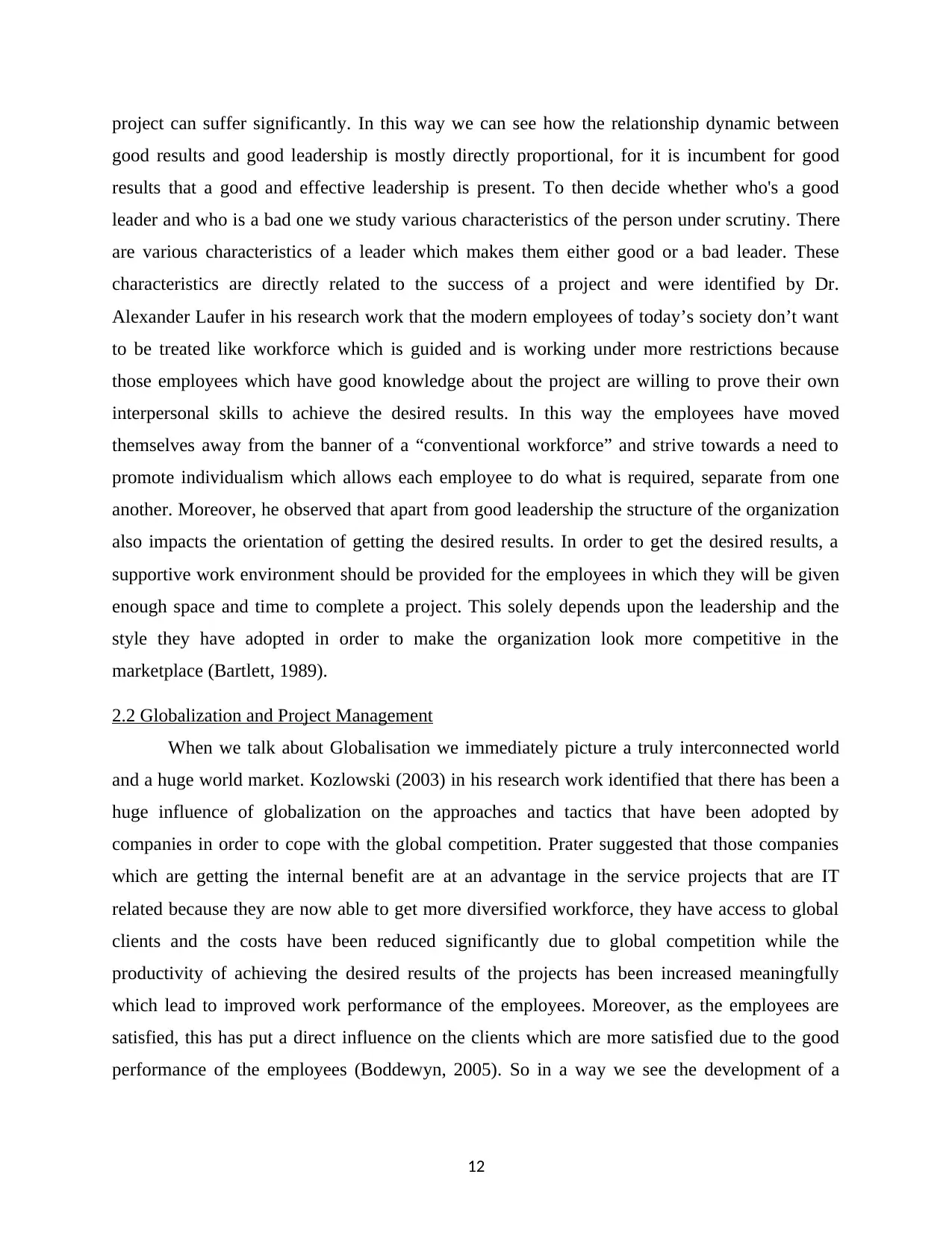
project can suffer significantly. In this way we can see how the relationship dynamic between
good results and good leadership is mostly directly proportional, for it is incumbent for good
results that a good and effective leadership is present. To then decide whether who's a good
leader and who is a bad one we study various characteristics of the person under scrutiny. There
are various characteristics of a leader which makes them either good or a bad leader. These
characteristics are directly related to the success of a project and were identified by Dr.
Alexander Laufer in his research work that the modern employees of today’s society don’t want
to be treated like workforce which is guided and is working under more restrictions because
those employees which have good knowledge about the project are willing to prove their own
interpersonal skills to achieve the desired results. In this way the employees have moved
themselves away from the banner of a “conventional workforce” and strive towards a need to
promote individualism which allows each employee to do what is required, separate from one
another. Moreover, he observed that apart from good leadership the structure of the organization
also impacts the orientation of getting the desired results. In order to get the desired results, a
supportive work environment should be provided for the employees in which they will be given
enough space and time to complete a project. This solely depends upon the leadership and the
style they have adopted in order to make the organization look more competitive in the
marketplace (Bartlett, 1989).
2.2 Globalization and Project Management
When we talk about Globalisation we immediately picture a truly interconnected world
and a huge world market. Kozlowski (2003) in his research work identified that there has been a
huge influence of globalization on the approaches and tactics that have been adopted by
companies in order to cope with the global competition. Prater suggested that those companies
which are getting the internal benefit are at an advantage in the service projects that are IT
related because they are now able to get more diversified workforce, they have access to global
clients and the costs have been reduced significantly due to global competition while the
productivity of achieving the desired results of the projects has been increased meaningfully
which lead to improved work performance of the employees. Moreover, as the employees are
satisfied, this has put a direct influence on the clients which are more satisfied due to the good
performance of the employees (Boddewyn, 2005). So in a way we see the development of a
12
good results and good leadership is mostly directly proportional, for it is incumbent for good
results that a good and effective leadership is present. To then decide whether who's a good
leader and who is a bad one we study various characteristics of the person under scrutiny. There
are various characteristics of a leader which makes them either good or a bad leader. These
characteristics are directly related to the success of a project and were identified by Dr.
Alexander Laufer in his research work that the modern employees of today’s society don’t want
to be treated like workforce which is guided and is working under more restrictions because
those employees which have good knowledge about the project are willing to prove their own
interpersonal skills to achieve the desired results. In this way the employees have moved
themselves away from the banner of a “conventional workforce” and strive towards a need to
promote individualism which allows each employee to do what is required, separate from one
another. Moreover, he observed that apart from good leadership the structure of the organization
also impacts the orientation of getting the desired results. In order to get the desired results, a
supportive work environment should be provided for the employees in which they will be given
enough space and time to complete a project. This solely depends upon the leadership and the
style they have adopted in order to make the organization look more competitive in the
marketplace (Bartlett, 1989).
2.2 Globalization and Project Management
When we talk about Globalisation we immediately picture a truly interconnected world
and a huge world market. Kozlowski (2003) in his research work identified that there has been a
huge influence of globalization on the approaches and tactics that have been adopted by
companies in order to cope with the global competition. Prater suggested that those companies
which are getting the internal benefit are at an advantage in the service projects that are IT
related because they are now able to get more diversified workforce, they have access to global
clients and the costs have been reduced significantly due to global competition while the
productivity of achieving the desired results of the projects has been increased meaningfully
which lead to improved work performance of the employees. Moreover, as the employees are
satisfied, this has put a direct influence on the clients which are more satisfied due to the good
performance of the employees (Boddewyn, 2005). So in a way we see the development of a
12
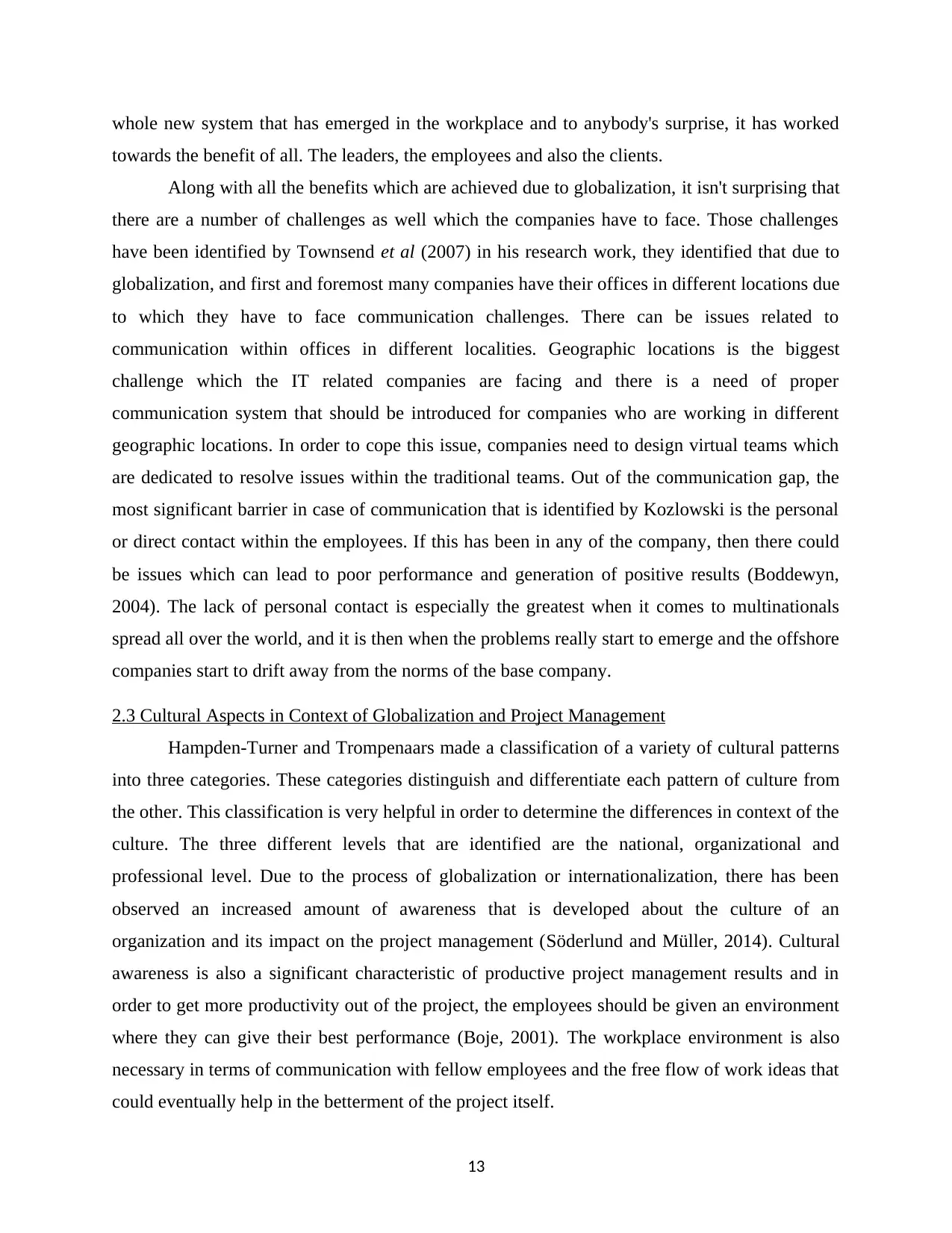
whole new system that has emerged in the workplace and to anybody's surprise, it has worked
towards the benefit of all. The leaders, the employees and also the clients.
Along with all the benefits which are achieved due to globalization, it isn't surprising that
there are a number of challenges as well which the companies have to face. Those challenges
have been identified by Townsend et al (2007) in his research work, they identified that due to
globalization, and first and foremost many companies have their offices in different locations due
to which they have to face communication challenges. There can be issues related to
communication within offices in different localities. Geographic locations is the biggest
challenge which the IT related companies are facing and there is a need of proper
communication system that should be introduced for companies who are working in different
geographic locations. In order to cope this issue, companies need to design virtual teams which
are dedicated to resolve issues within the traditional teams. Out of the communication gap, the
most significant barrier in case of communication that is identified by Kozlowski is the personal
or direct contact within the employees. If this has been in any of the company, then there could
be issues which can lead to poor performance and generation of positive results (Boddewyn,
2004). The lack of personal contact is especially the greatest when it comes to multinationals
spread all over the world, and it is then when the problems really start to emerge and the offshore
companies start to drift away from the norms of the base company.
2.3 Cultural Aspects in Context of Globalization and Project Management
Hampden-Turner and Trompenaars made a classification of a variety of cultural patterns
into three categories. These categories distinguish and differentiate each pattern of culture from
the other. This classification is very helpful in order to determine the differences in context of the
culture. The three different levels that are identified are the national, organizational and
professional level. Due to the process of globalization or internationalization, there has been
observed an increased amount of awareness that is developed about the culture of an
organization and its impact on the project management (Söderlund and Müller, 2014). Cultural
awareness is also a significant characteristic of productive project management results and in
order to get more productivity out of the project, the employees should be given an environment
where they can give their best performance (Boje, 2001). The workplace environment is also
necessary in terms of communication with fellow employees and the free flow of work ideas that
could eventually help in the betterment of the project itself.
13
towards the benefit of all. The leaders, the employees and also the clients.
Along with all the benefits which are achieved due to globalization, it isn't surprising that
there are a number of challenges as well which the companies have to face. Those challenges
have been identified by Townsend et al (2007) in his research work, they identified that due to
globalization, and first and foremost many companies have their offices in different locations due
to which they have to face communication challenges. There can be issues related to
communication within offices in different localities. Geographic locations is the biggest
challenge which the IT related companies are facing and there is a need of proper
communication system that should be introduced for companies who are working in different
geographic locations. In order to cope this issue, companies need to design virtual teams which
are dedicated to resolve issues within the traditional teams. Out of the communication gap, the
most significant barrier in case of communication that is identified by Kozlowski is the personal
or direct contact within the employees. If this has been in any of the company, then there could
be issues which can lead to poor performance and generation of positive results (Boddewyn,
2004). The lack of personal contact is especially the greatest when it comes to multinationals
spread all over the world, and it is then when the problems really start to emerge and the offshore
companies start to drift away from the norms of the base company.
2.3 Cultural Aspects in Context of Globalization and Project Management
Hampden-Turner and Trompenaars made a classification of a variety of cultural patterns
into three categories. These categories distinguish and differentiate each pattern of culture from
the other. This classification is very helpful in order to determine the differences in context of the
culture. The three different levels that are identified are the national, organizational and
professional level. Due to the process of globalization or internationalization, there has been
observed an increased amount of awareness that is developed about the culture of an
organization and its impact on the project management (Söderlund and Müller, 2014). Cultural
awareness is also a significant characteristic of productive project management results and in
order to get more productivity out of the project, the employees should be given an environment
where they can give their best performance (Boje, 2001). The workplace environment is also
necessary in terms of communication with fellow employees and the free flow of work ideas that
could eventually help in the betterment of the project itself.
13
Secure Best Marks with AI Grader
Need help grading? Try our AI Grader for instant feedback on your assignments.
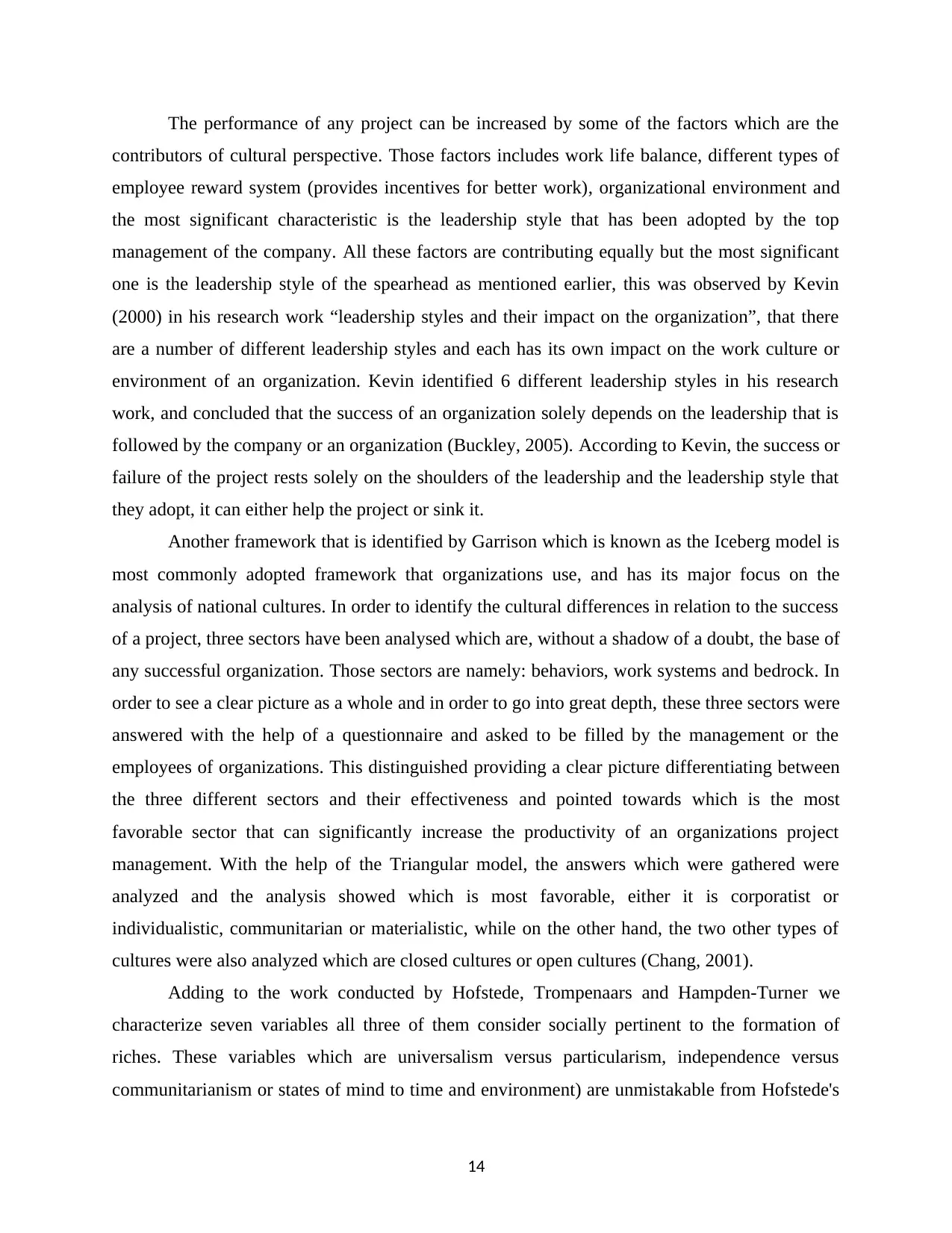
The performance of any project can be increased by some of the factors which are the
contributors of cultural perspective. Those factors includes work life balance, different types of
employee reward system (provides incentives for better work), organizational environment and
the most significant characteristic is the leadership style that has been adopted by the top
management of the company. All these factors are contributing equally but the most significant
one is the leadership style of the spearhead as mentioned earlier, this was observed by Kevin
(2000) in his research work “leadership styles and their impact on the organization”, that there
are a number of different leadership styles and each has its own impact on the work culture or
environment of an organization. Kevin identified 6 different leadership styles in his research
work, and concluded that the success of an organization solely depends on the leadership that is
followed by the company or an organization (Buckley, 2005). According to Kevin, the success or
failure of the project rests solely on the shoulders of the leadership and the leadership style that
they adopt, it can either help the project or sink it.
Another framework that is identified by Garrison which is known as the Iceberg model is
most commonly adopted framework that organizations use, and has its major focus on the
analysis of national cultures. In order to identify the cultural differences in relation to the success
of a project, three sectors have been analysed which are, without a shadow of a doubt, the base of
any successful organization. Those sectors are namely: behaviors, work systems and bedrock. In
order to see a clear picture as a whole and in order to go into great depth, these three sectors were
answered with the help of a questionnaire and asked to be filled by the management or the
employees of organizations. This distinguished providing a clear picture differentiating between
the three different sectors and their effectiveness and pointed towards which is the most
favorable sector that can significantly increase the productivity of an organizations project
management. With the help of the Triangular model, the answers which were gathered were
analyzed and the analysis showed which is most favorable, either it is corporatist or
individualistic, communitarian or materialistic, while on the other hand, the two other types of
cultures were also analyzed which are closed cultures or open cultures (Chang, 2001).
Adding to the work conducted by Hofstede, Trompenaars and Hampden-Turner we
characterize seven variables all three of them consider socially pertinent to the formation of
riches. These variables which are universalism versus particularism, independence versus
communitarianism or states of mind to time and environment) are unmistakable from Hofstede's
14
contributors of cultural perspective. Those factors includes work life balance, different types of
employee reward system (provides incentives for better work), organizational environment and
the most significant characteristic is the leadership style that has been adopted by the top
management of the company. All these factors are contributing equally but the most significant
one is the leadership style of the spearhead as mentioned earlier, this was observed by Kevin
(2000) in his research work “leadership styles and their impact on the organization”, that there
are a number of different leadership styles and each has its own impact on the work culture or
environment of an organization. Kevin identified 6 different leadership styles in his research
work, and concluded that the success of an organization solely depends on the leadership that is
followed by the company or an organization (Buckley, 2005). According to Kevin, the success or
failure of the project rests solely on the shoulders of the leadership and the leadership style that
they adopt, it can either help the project or sink it.
Another framework that is identified by Garrison which is known as the Iceberg model is
most commonly adopted framework that organizations use, and has its major focus on the
analysis of national cultures. In order to identify the cultural differences in relation to the success
of a project, three sectors have been analysed which are, without a shadow of a doubt, the base of
any successful organization. Those sectors are namely: behaviors, work systems and bedrock. In
order to see a clear picture as a whole and in order to go into great depth, these three sectors were
answered with the help of a questionnaire and asked to be filled by the management or the
employees of organizations. This distinguished providing a clear picture differentiating between
the three different sectors and their effectiveness and pointed towards which is the most
favorable sector that can significantly increase the productivity of an organizations project
management. With the help of the Triangular model, the answers which were gathered were
analyzed and the analysis showed which is most favorable, either it is corporatist or
individualistic, communitarian or materialistic, while on the other hand, the two other types of
cultures were also analyzed which are closed cultures or open cultures (Chang, 2001).
Adding to the work conducted by Hofstede, Trompenaars and Hampden-Turner we
characterize seven variables all three of them consider socially pertinent to the formation of
riches. These variables which are universalism versus particularism, independence versus
communitarianism or states of mind to time and environment) are unmistakable from Hofstede's
14
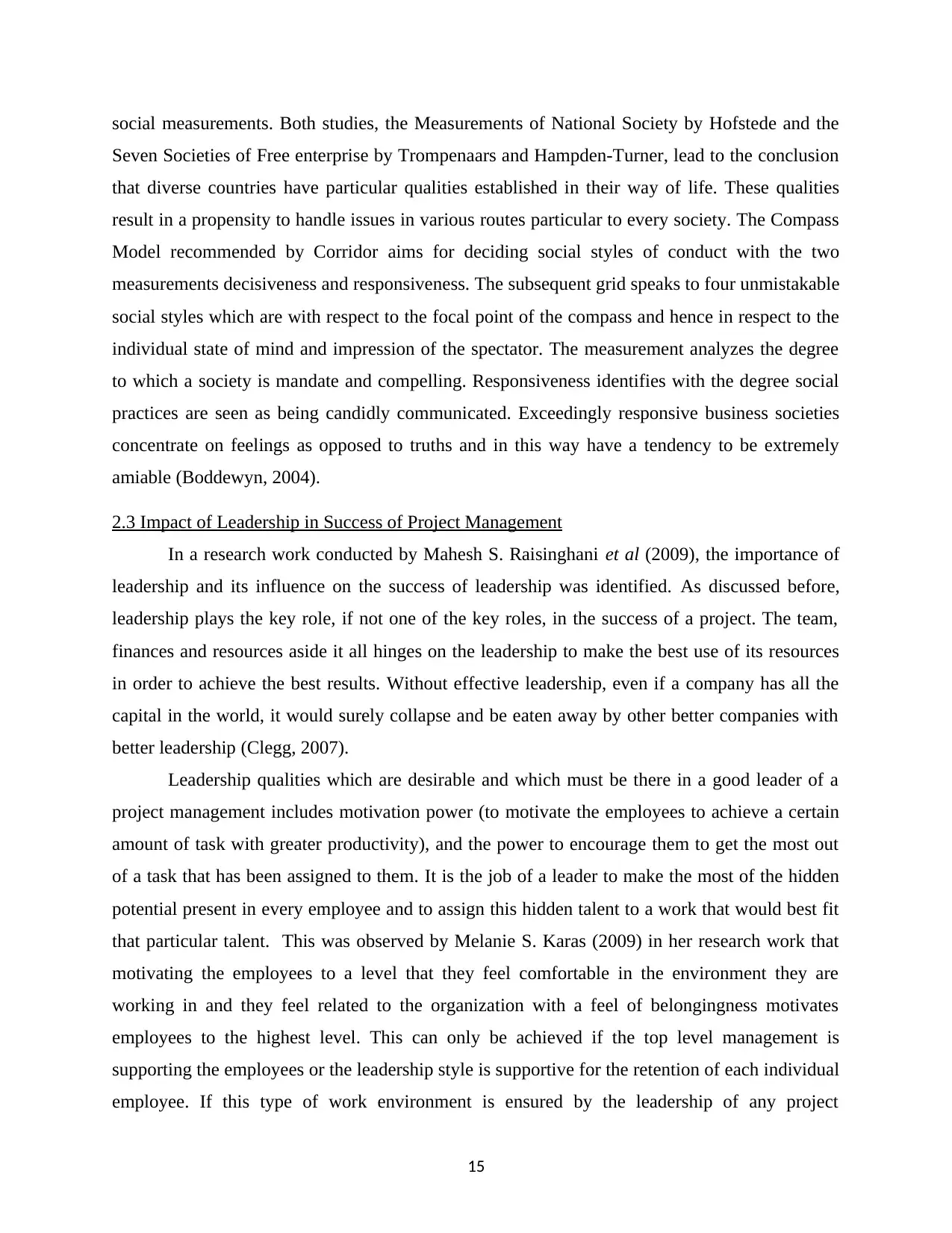
social measurements. Both studies, the Measurements of National Society by Hofstede and the
Seven Societies of Free enterprise by Trompenaars and Hampden-Turner, lead to the conclusion
that diverse countries have particular qualities established in their way of life. These qualities
result in a propensity to handle issues in various routes particular to every society. The Compass
Model recommended by Corridor aims for deciding social styles of conduct with the two
measurements decisiveness and responsiveness. The subsequent grid speaks to four unmistakable
social styles which are with respect to the focal point of the compass and hence in respect to the
individual state of mind and impression of the spectator. The measurement analyzes the degree
to which a society is mandate and compelling. Responsiveness identifies with the degree social
practices are seen as being candidly communicated. Exceedingly responsive business societies
concentrate on feelings as opposed to truths and in this way have a tendency to be extremely
amiable (Boddewyn, 2004).
2.3 Impact of Leadership in Success of Project Management
In a research work conducted by Mahesh S. Raisinghani et al (2009), the importance of
leadership and its influence on the success of leadership was identified. As discussed before,
leadership plays the key role, if not one of the key roles, in the success of a project. The team,
finances and resources aside it all hinges on the leadership to make the best use of its resources
in order to achieve the best results. Without effective leadership, even if a company has all the
capital in the world, it would surely collapse and be eaten away by other better companies with
better leadership (Clegg, 2007).
Leadership qualities which are desirable and which must be there in a good leader of a
project management includes motivation power (to motivate the employees to achieve a certain
amount of task with greater productivity), and the power to encourage them to get the most out
of a task that has been assigned to them. It is the job of a leader to make the most of the hidden
potential present in every employee and to assign this hidden talent to a work that would best fit
that particular talent. This was observed by Melanie S. Karas (2009) in her research work that
motivating the employees to a level that they feel comfortable in the environment they are
working in and they feel related to the organization with a feel of belongingness motivates
employees to the highest level. This can only be achieved if the top level management is
supporting the employees or the leadership style is supportive for the retention of each individual
employee. If this type of work environment is ensured by the leadership of any project
15
Seven Societies of Free enterprise by Trompenaars and Hampden-Turner, lead to the conclusion
that diverse countries have particular qualities established in their way of life. These qualities
result in a propensity to handle issues in various routes particular to every society. The Compass
Model recommended by Corridor aims for deciding social styles of conduct with the two
measurements decisiveness and responsiveness. The subsequent grid speaks to four unmistakable
social styles which are with respect to the focal point of the compass and hence in respect to the
individual state of mind and impression of the spectator. The measurement analyzes the degree
to which a society is mandate and compelling. Responsiveness identifies with the degree social
practices are seen as being candidly communicated. Exceedingly responsive business societies
concentrate on feelings as opposed to truths and in this way have a tendency to be extremely
amiable (Boddewyn, 2004).
2.3 Impact of Leadership in Success of Project Management
In a research work conducted by Mahesh S. Raisinghani et al (2009), the importance of
leadership and its influence on the success of leadership was identified. As discussed before,
leadership plays the key role, if not one of the key roles, in the success of a project. The team,
finances and resources aside it all hinges on the leadership to make the best use of its resources
in order to achieve the best results. Without effective leadership, even if a company has all the
capital in the world, it would surely collapse and be eaten away by other better companies with
better leadership (Clegg, 2007).
Leadership qualities which are desirable and which must be there in a good leader of a
project management includes motivation power (to motivate the employees to achieve a certain
amount of task with greater productivity), and the power to encourage them to get the most out
of a task that has been assigned to them. It is the job of a leader to make the most of the hidden
potential present in every employee and to assign this hidden talent to a work that would best fit
that particular talent. This was observed by Melanie S. Karas (2009) in her research work that
motivating the employees to a level that they feel comfortable in the environment they are
working in and they feel related to the organization with a feel of belongingness motivates
employees to the highest level. This can only be achieved if the top level management is
supporting the employees or the leadership style is supportive for the retention of each individual
employee. If this type of work environment is ensured by the leadership of any project
15

management, then a very positive work environment where each employee is dedicated towards
their work can be achieved (Dicken, 2009).
Another research work by Kerry S. Webb (2007) about the project management and role
of leadership, in his study, Kerry observed that if the top level management or the leadership is
supporting the employees in their needs, then this will significantly improve the level of job
satisfaction of the employees and increase the level of motivation of the staff members. Helpful
bosses almost always are loved by their employees. A good leader has the ability to break down
the metaphorical wall of respect between him and his employee in order to better acquaint with
him. This will increase the level of results of each individual employee and increase the level of
productivity while on the other hand, the main benefit will be observed by the company where
they are serving. As the productivity will be increased, this will directly influence the qualities
which are desirable in any project (Gemünden, 2015).
Bálint Blaskovics (2014) in his research work about the “Impact of leadership styles on
project success – The case of a multinational company”, made an analysis that according to
Project Management Institute (2010), to a very increased level, the understanding has been
emerged about the importance of project management by companies and different firms
(Blaskovics, 2014).
There are a variety of views about project management such as input and output
orientation of the view. In case of output oriented view, the success of any project is measured
through the success criteria of that particular project, the success criteria can be defined as the
values according to which the success of any project can be measured. On the other hand, the
input view interprets the project as to what are the factors which are responsible for the success
of any project whether they can be any factors, but the only aspect of an input view is that it must
provide success to the project. These factors can be termed as the critical success factors of any
project. Those factors which are the critical success factors must be aligned with the goals of the
project in order to successfully implement the change (Chang, 2001).
2.4 Difference in Practices of Transnational Company in Developed or Developing Countries
Görög (2008) in his research work observed a significant change in the management
practices of a transnational or international company which has its base office in one country and
some units or offices in other countries. The main aspect that Görög observed was that the
companies have adopted different management practices even the products they were offering
16
their work can be achieved (Dicken, 2009).
Another research work by Kerry S. Webb (2007) about the project management and role
of leadership, in his study, Kerry observed that if the top level management or the leadership is
supporting the employees in their needs, then this will significantly improve the level of job
satisfaction of the employees and increase the level of motivation of the staff members. Helpful
bosses almost always are loved by their employees. A good leader has the ability to break down
the metaphorical wall of respect between him and his employee in order to better acquaint with
him. This will increase the level of results of each individual employee and increase the level of
productivity while on the other hand, the main benefit will be observed by the company where
they are serving. As the productivity will be increased, this will directly influence the qualities
which are desirable in any project (Gemünden, 2015).
Bálint Blaskovics (2014) in his research work about the “Impact of leadership styles on
project success – The case of a multinational company”, made an analysis that according to
Project Management Institute (2010), to a very increased level, the understanding has been
emerged about the importance of project management by companies and different firms
(Blaskovics, 2014).
There are a variety of views about project management such as input and output
orientation of the view. In case of output oriented view, the success of any project is measured
through the success criteria of that particular project, the success criteria can be defined as the
values according to which the success of any project can be measured. On the other hand, the
input view interprets the project as to what are the factors which are responsible for the success
of any project whether they can be any factors, but the only aspect of an input view is that it must
provide success to the project. These factors can be termed as the critical success factors of any
project. Those factors which are the critical success factors must be aligned with the goals of the
project in order to successfully implement the change (Chang, 2001).
2.4 Difference in Practices of Transnational Company in Developed or Developing Countries
Görög (2008) in his research work observed a significant change in the management
practices of a transnational or international company which has its base office in one country and
some units or offices in other countries. The main aspect that Görög observed was that the
companies have adopted different management practices even the products they were offering
16
Paraphrase This Document
Need a fresh take? Get an instant paraphrase of this document with our AI Paraphraser
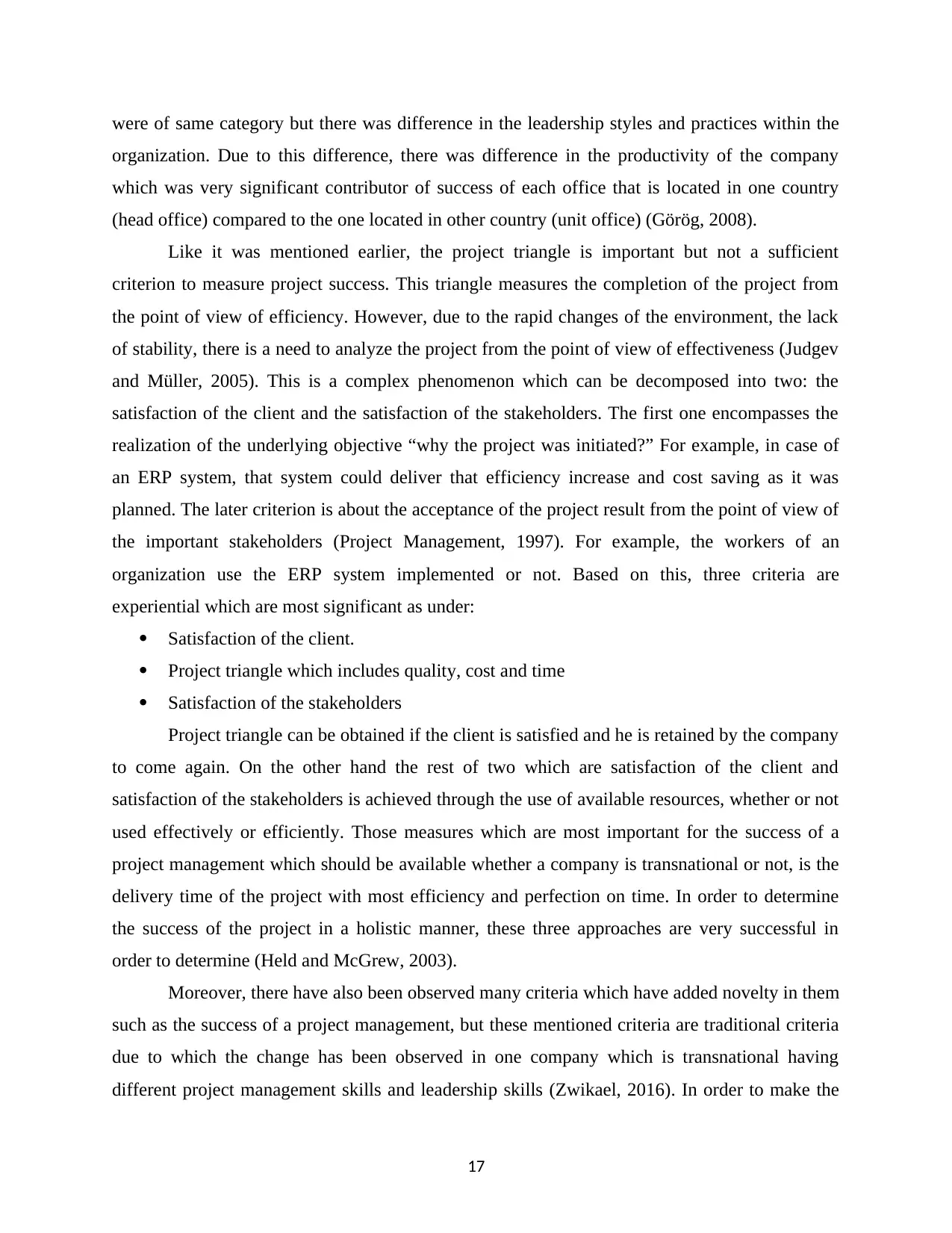
were of same category but there was difference in the leadership styles and practices within the
organization. Due to this difference, there was difference in the productivity of the company
which was very significant contributor of success of each office that is located in one country
(head office) compared to the one located in other country (unit office) (Görög, 2008).
Like it was mentioned earlier, the project triangle is important but not a sufficient
criterion to measure project success. This triangle measures the completion of the project from
the point of view of efficiency. However, due to the rapid changes of the environment, the lack
of stability, there is a need to analyze the project from the point of view of effectiveness (Judgev
and Müller, 2005). This is a complex phenomenon which can be decomposed into two: the
satisfaction of the client and the satisfaction of the stakeholders. The first one encompasses the
realization of the underlying objective “why the project was initiated?” For example, in case of
an ERP system, that system could deliver that efficiency increase and cost saving as it was
planned. The later criterion is about the acceptance of the project result from the point of view of
the important stakeholders (Project Management, 1997). For example, the workers of an
organization use the ERP system implemented or not. Based on this, three criteria are
experiential which are most significant as under:
Satisfaction of the client.
Project triangle which includes quality, cost and time
Satisfaction of the stakeholders
Project triangle can be obtained if the client is satisfied and he is retained by the company
to come again. On the other hand the rest of two which are satisfaction of the client and
satisfaction of the stakeholders is achieved through the use of available resources, whether or not
used effectively or efficiently. Those measures which are most important for the success of a
project management which should be available whether a company is transnational or not, is the
delivery time of the project with most efficiency and perfection on time. In order to determine
the success of the project in a holistic manner, these three approaches are very successful in
order to determine (Held and McGrew, 2003).
Moreover, there have also been observed many criteria which have added novelty in them
such as the success of a project management, but these mentioned criteria are traditional criteria
due to which the change has been observed in one company which is transnational having
different project management skills and leadership skills (Zwikael, 2016). In order to make the
17
organization. Due to this difference, there was difference in the productivity of the company
which was very significant contributor of success of each office that is located in one country
(head office) compared to the one located in other country (unit office) (Görög, 2008).
Like it was mentioned earlier, the project triangle is important but not a sufficient
criterion to measure project success. This triangle measures the completion of the project from
the point of view of efficiency. However, due to the rapid changes of the environment, the lack
of stability, there is a need to analyze the project from the point of view of effectiveness (Judgev
and Müller, 2005). This is a complex phenomenon which can be decomposed into two: the
satisfaction of the client and the satisfaction of the stakeholders. The first one encompasses the
realization of the underlying objective “why the project was initiated?” For example, in case of
an ERP system, that system could deliver that efficiency increase and cost saving as it was
planned. The later criterion is about the acceptance of the project result from the point of view of
the important stakeholders (Project Management, 1997). For example, the workers of an
organization use the ERP system implemented or not. Based on this, three criteria are
experiential which are most significant as under:
Satisfaction of the client.
Project triangle which includes quality, cost and time
Satisfaction of the stakeholders
Project triangle can be obtained if the client is satisfied and he is retained by the company
to come again. On the other hand the rest of two which are satisfaction of the client and
satisfaction of the stakeholders is achieved through the use of available resources, whether or not
used effectively or efficiently. Those measures which are most important for the success of a
project management which should be available whether a company is transnational or not, is the
delivery time of the project with most efficiency and perfection on time. In order to determine
the success of the project in a holistic manner, these three approaches are very successful in
order to determine (Held and McGrew, 2003).
Moreover, there have also been observed many criteria which have added novelty in them
such as the success of a project management, but these mentioned criteria are traditional criteria
due to which the change has been observed in one company which is transnational having
different project management skills and leadership skills (Zwikael, 2016). In order to make the
17
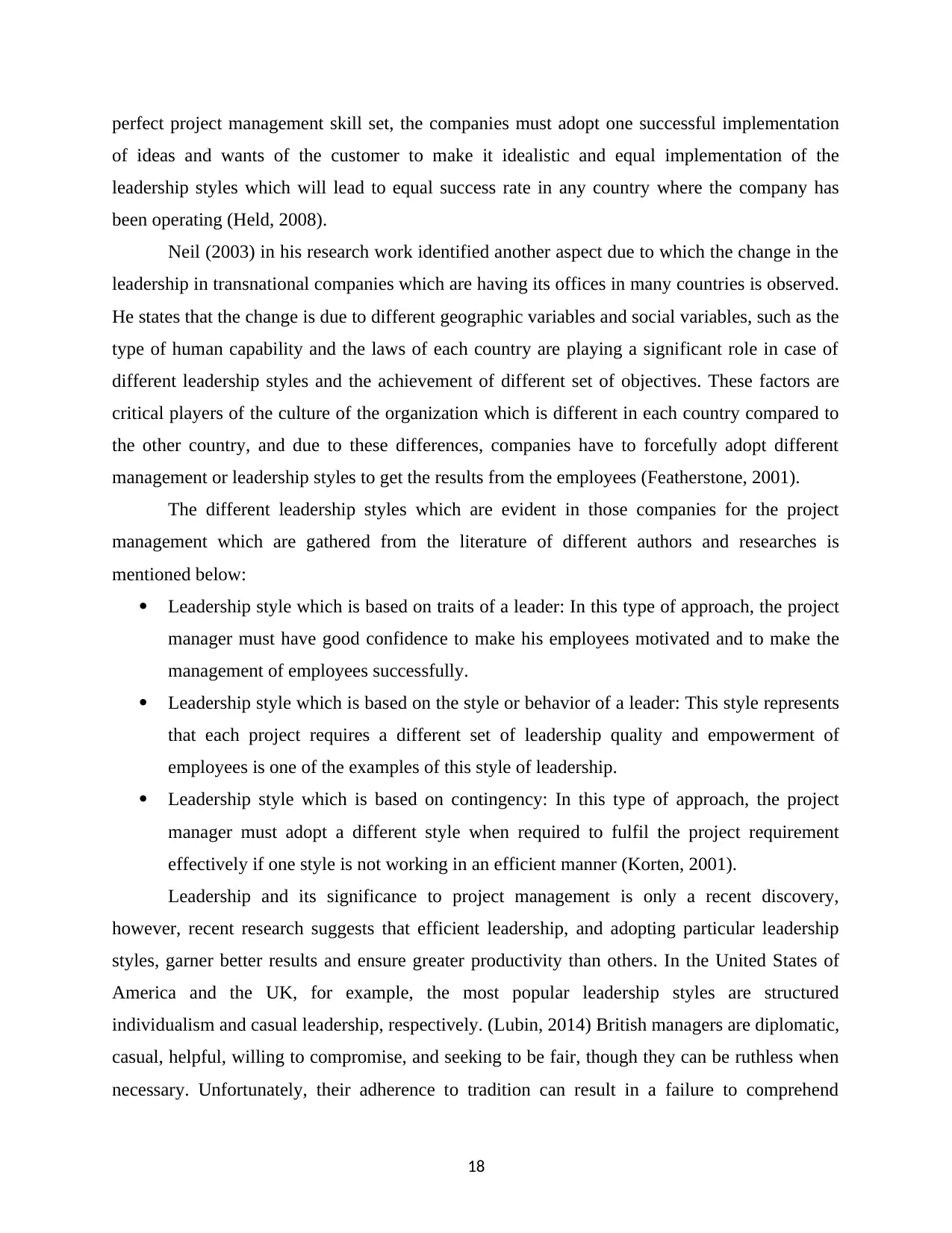
perfect project management skill set, the companies must adopt one successful implementation
of ideas and wants of the customer to make it idealistic and equal implementation of the
leadership styles which will lead to equal success rate in any country where the company has
been operating (Held, 2008).
Neil (2003) in his research work identified another aspect due to which the change in the
leadership in transnational companies which are having its offices in many countries is observed.
He states that the change is due to different geographic variables and social variables, such as the
type of human capability and the laws of each country are playing a significant role in case of
different leadership styles and the achievement of different set of objectives. These factors are
critical players of the culture of the organization which is different in each country compared to
the other country, and due to these differences, companies have to forcefully adopt different
management or leadership styles to get the results from the employees (Featherstone, 2001).
The different leadership styles which are evident in those companies for the project
management which are gathered from the literature of different authors and researches is
mentioned below:
Leadership style which is based on traits of a leader: In this type of approach, the project
manager must have good confidence to make his employees motivated and to make the
management of employees successfully.
Leadership style which is based on the style or behavior of a leader: This style represents
that each project requires a different set of leadership quality and empowerment of
employees is one of the examples of this style of leadership.
Leadership style which is based on contingency: In this type of approach, the project
manager must adopt a different style when required to fulfil the project requirement
effectively if one style is not working in an efficient manner (Korten, 2001).
Leadership and its significance to project management is only a recent discovery,
however, recent research suggests that efficient leadership, and adopting particular leadership
styles, garner better results and ensure greater productivity than others. In the United States of
America and the UK, for example, the most popular leadership styles are structured
individualism and casual leadership, respectively. (Lubin, 2014) British managers are diplomatic,
casual, helpful, willing to compromise, and seeking to be fair, though they can be ruthless when
necessary. Unfortunately, their adherence to tradition can result in a failure to comprehend
18
of ideas and wants of the customer to make it idealistic and equal implementation of the
leadership styles which will lead to equal success rate in any country where the company has
been operating (Held, 2008).
Neil (2003) in his research work identified another aspect due to which the change in the
leadership in transnational companies which are having its offices in many countries is observed.
He states that the change is due to different geographic variables and social variables, such as the
type of human capability and the laws of each country are playing a significant role in case of
different leadership styles and the achievement of different set of objectives. These factors are
critical players of the culture of the organization which is different in each country compared to
the other country, and due to these differences, companies have to forcefully adopt different
management or leadership styles to get the results from the employees (Featherstone, 2001).
The different leadership styles which are evident in those companies for the project
management which are gathered from the literature of different authors and researches is
mentioned below:
Leadership style which is based on traits of a leader: In this type of approach, the project
manager must have good confidence to make his employees motivated and to make the
management of employees successfully.
Leadership style which is based on the style or behavior of a leader: This style represents
that each project requires a different set of leadership quality and empowerment of
employees is one of the examples of this style of leadership.
Leadership style which is based on contingency: In this type of approach, the project
manager must adopt a different style when required to fulfil the project requirement
effectively if one style is not working in an efficient manner (Korten, 2001).
Leadership and its significance to project management is only a recent discovery,
however, recent research suggests that efficient leadership, and adopting particular leadership
styles, garner better results and ensure greater productivity than others. In the United States of
America and the UK, for example, the most popular leadership styles are structured
individualism and casual leadership, respectively. (Lubin, 2014) British managers are diplomatic,
casual, helpful, willing to compromise, and seeking to be fair, though they can be ruthless when
necessary. Unfortunately, their adherence to tradition can result in a failure to comprehend
18
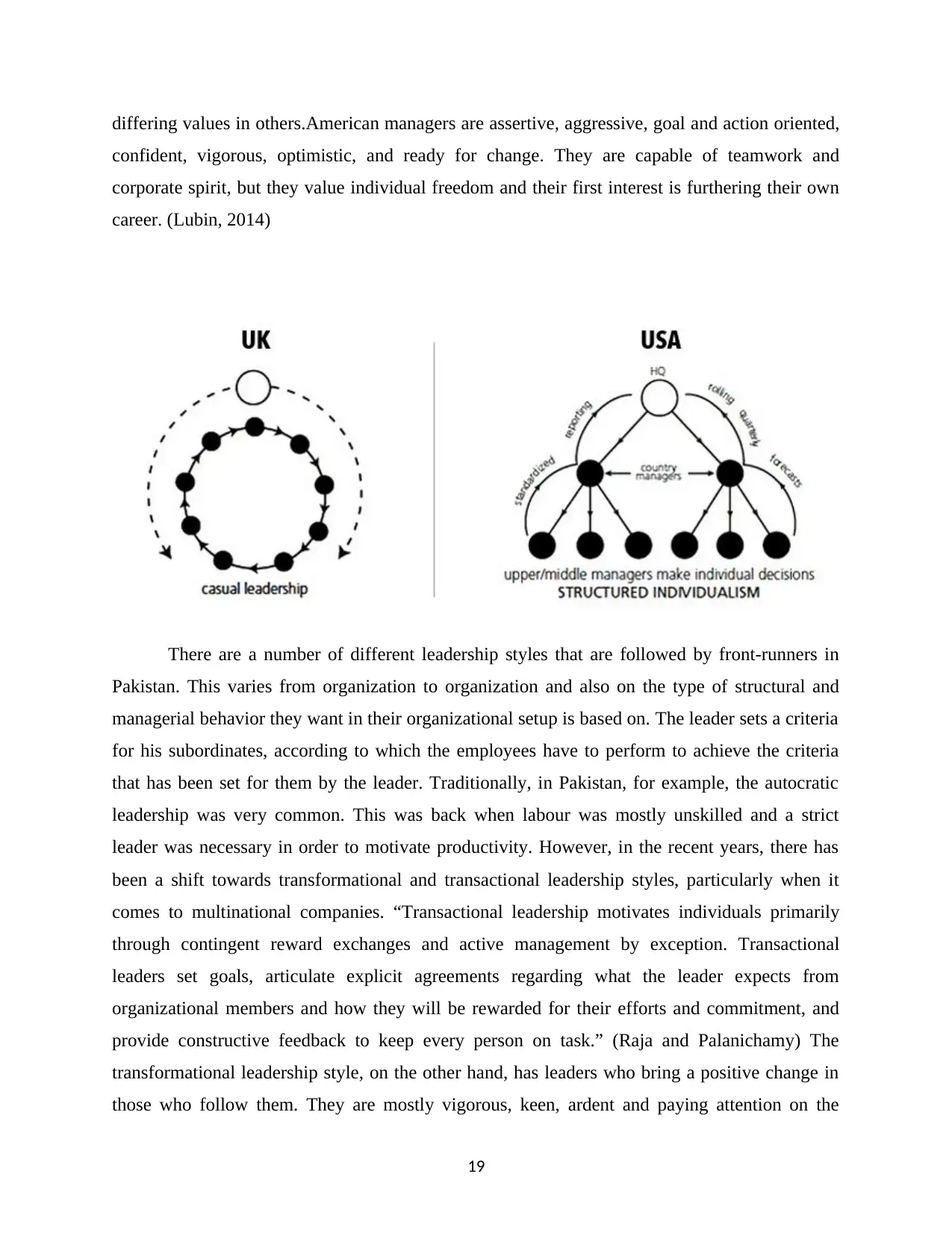
differing values in others.American managers are assertive, aggressive, goal and action oriented,
confident, vigorous, optimistic, and ready for change. They are capable of teamwork and
corporate spirit, but they value individual freedom and their first interest is furthering their own
career. (Lubin, 2014)
There are a number of different leadership styles that are followed by front-runners in
Pakistan. This varies from organization to organization and also on the type of structural and
managerial behavior they want in their organizational setup is based on. The leader sets a criteria
for his subordinates, according to which the employees have to perform to achieve the criteria
that has been set for them by the leader. Traditionally, in Pakistan, for example, the autocratic
leadership was very common. This was back when labour was mostly unskilled and a strict
leader was necessary in order to motivate productivity. However, in the recent years, there has
been a shift towards transformational and transactional leadership styles, particularly when it
comes to multinational companies. “Transactional leadership motivates individuals primarily
through contingent reward exchanges and active management by exception. Transactional
leaders set goals, articulate explicit agreements regarding what the leader expects from
organizational members and how they will be rewarded for their efforts and commitment, and
provide constructive feedback to keep every person on task.” (Raja and Palanichamy) The
transformational leadership style, on the other hand, has leaders who bring a positive change in
those who follow them. They are mostly vigorous, keen, ardent and paying attention on the
19
confident, vigorous, optimistic, and ready for change. They are capable of teamwork and
corporate spirit, but they value individual freedom and their first interest is furthering their own
career. (Lubin, 2014)
There are a number of different leadership styles that are followed by front-runners in
Pakistan. This varies from organization to organization and also on the type of structural and
managerial behavior they want in their organizational setup is based on. The leader sets a criteria
for his subordinates, according to which the employees have to perform to achieve the criteria
that has been set for them by the leader. Traditionally, in Pakistan, for example, the autocratic
leadership was very common. This was back when labour was mostly unskilled and a strict
leader was necessary in order to motivate productivity. However, in the recent years, there has
been a shift towards transformational and transactional leadership styles, particularly when it
comes to multinational companies. “Transactional leadership motivates individuals primarily
through contingent reward exchanges and active management by exception. Transactional
leaders set goals, articulate explicit agreements regarding what the leader expects from
organizational members and how they will be rewarded for their efforts and commitment, and
provide constructive feedback to keep every person on task.” (Raja and Palanichamy) The
transformational leadership style, on the other hand, has leaders who bring a positive change in
those who follow them. They are mostly vigorous, keen, ardent and paying attention on the
19
Secure Best Marks with AI Grader
Need help grading? Try our AI Grader for instant feedback on your assignments.
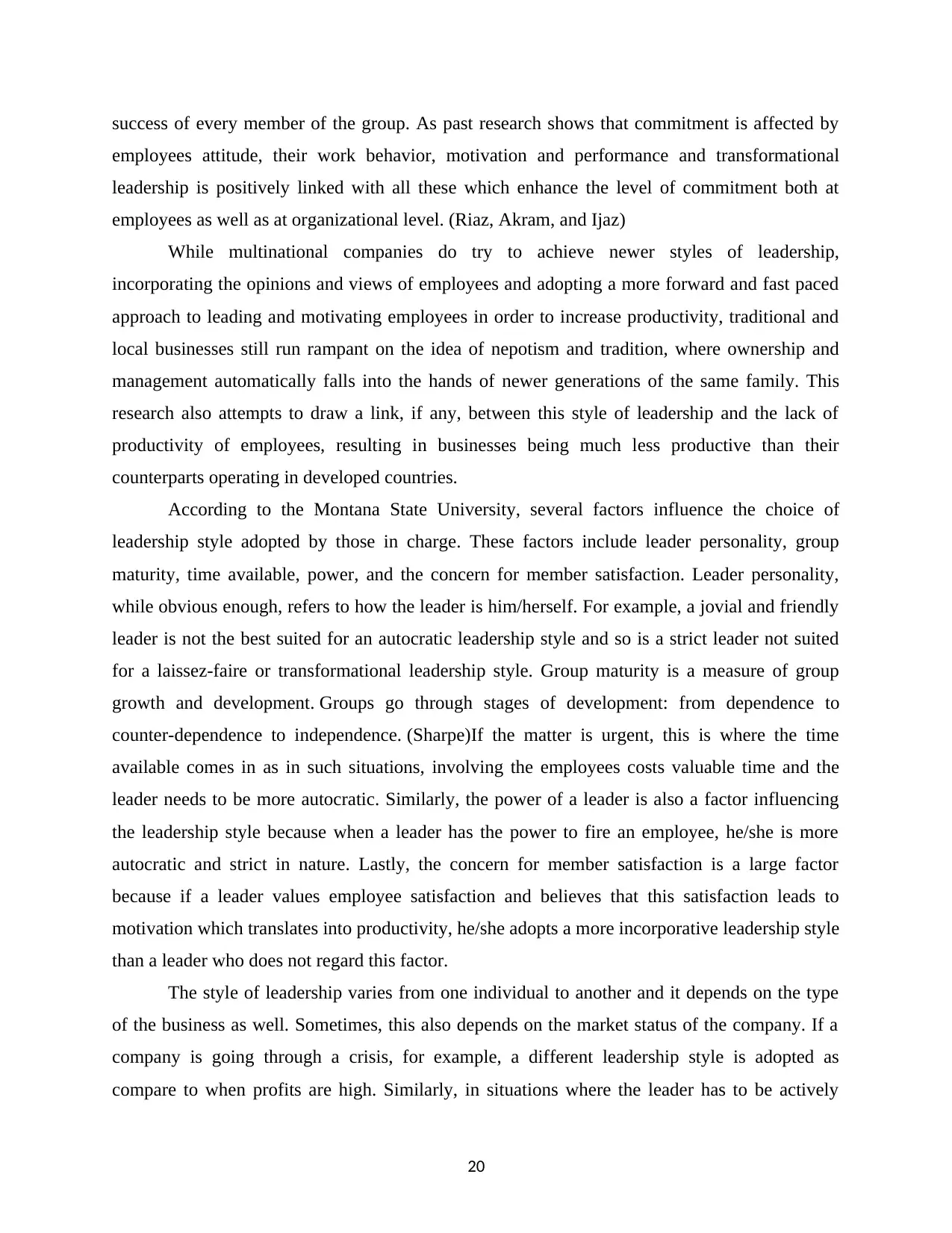
success of every member of the group. As past research shows that commitment is affected by
employees attitude, their work behavior, motivation and performance and transformational
leadership is positively linked with all these which enhance the level of commitment both at
employees as well as at organizational level. (Riaz, Akram, and Ijaz)
While multinational companies do try to achieve newer styles of leadership,
incorporating the opinions and views of employees and adopting a more forward and fast paced
approach to leading and motivating employees in order to increase productivity, traditional and
local businesses still run rampant on the idea of nepotism and tradition, where ownership and
management automatically falls into the hands of newer generations of the same family. This
research also attempts to draw a link, if any, between this style of leadership and the lack of
productivity of employees, resulting in businesses being much less productive than their
counterparts operating in developed countries.
According to the Montana State University, several factors influence the choice of
leadership style adopted by those in charge. These factors include leader personality, group
maturity, time available, power, and the concern for member satisfaction. Leader personality,
while obvious enough, refers to how the leader is him/herself. For example, a jovial and friendly
leader is not the best suited for an autocratic leadership style and so is a strict leader not suited
for a laissez-faire or transformational leadership style. Group maturity is a measure of group
growth and development. Groups go through stages of development: from dependence to
counter-dependence to independence. (Sharpe)If the matter is urgent, this is where the time
available comes in as in such situations, involving the employees costs valuable time and the
leader needs to be more autocratic. Similarly, the power of a leader is also a factor influencing
the leadership style because when a leader has the power to fire an employee, he/she is more
autocratic and strict in nature. Lastly, the concern for member satisfaction is a large factor
because if a leader values employee satisfaction and believes that this satisfaction leads to
motivation which translates into productivity, he/she adopts a more incorporative leadership style
than a leader who does not regard this factor.
The style of leadership varies from one individual to another and it depends on the type
of the business as well. Sometimes, this also depends on the market status of the company. If a
company is going through a crisis, for example, a different leadership style is adopted as
compare to when profits are high. Similarly, in situations where the leader has to be actively
20
employees attitude, their work behavior, motivation and performance and transformational
leadership is positively linked with all these which enhance the level of commitment both at
employees as well as at organizational level. (Riaz, Akram, and Ijaz)
While multinational companies do try to achieve newer styles of leadership,
incorporating the opinions and views of employees and adopting a more forward and fast paced
approach to leading and motivating employees in order to increase productivity, traditional and
local businesses still run rampant on the idea of nepotism and tradition, where ownership and
management automatically falls into the hands of newer generations of the same family. This
research also attempts to draw a link, if any, between this style of leadership and the lack of
productivity of employees, resulting in businesses being much less productive than their
counterparts operating in developed countries.
According to the Montana State University, several factors influence the choice of
leadership style adopted by those in charge. These factors include leader personality, group
maturity, time available, power, and the concern for member satisfaction. Leader personality,
while obvious enough, refers to how the leader is him/herself. For example, a jovial and friendly
leader is not the best suited for an autocratic leadership style and so is a strict leader not suited
for a laissez-faire or transformational leadership style. Group maturity is a measure of group
growth and development. Groups go through stages of development: from dependence to
counter-dependence to independence. (Sharpe)If the matter is urgent, this is where the time
available comes in as in such situations, involving the employees costs valuable time and the
leader needs to be more autocratic. Similarly, the power of a leader is also a factor influencing
the leadership style because when a leader has the power to fire an employee, he/she is more
autocratic and strict in nature. Lastly, the concern for member satisfaction is a large factor
because if a leader values employee satisfaction and believes that this satisfaction leads to
motivation which translates into productivity, he/she adopts a more incorporative leadership style
than a leader who does not regard this factor.
The style of leadership varies from one individual to another and it depends on the type
of the business as well. Sometimes, this also depends on the market status of the company. If a
company is going through a crisis, for example, a different leadership style is adopted as
compare to when profits are high. Similarly, in situations where the leader has to be actively
20
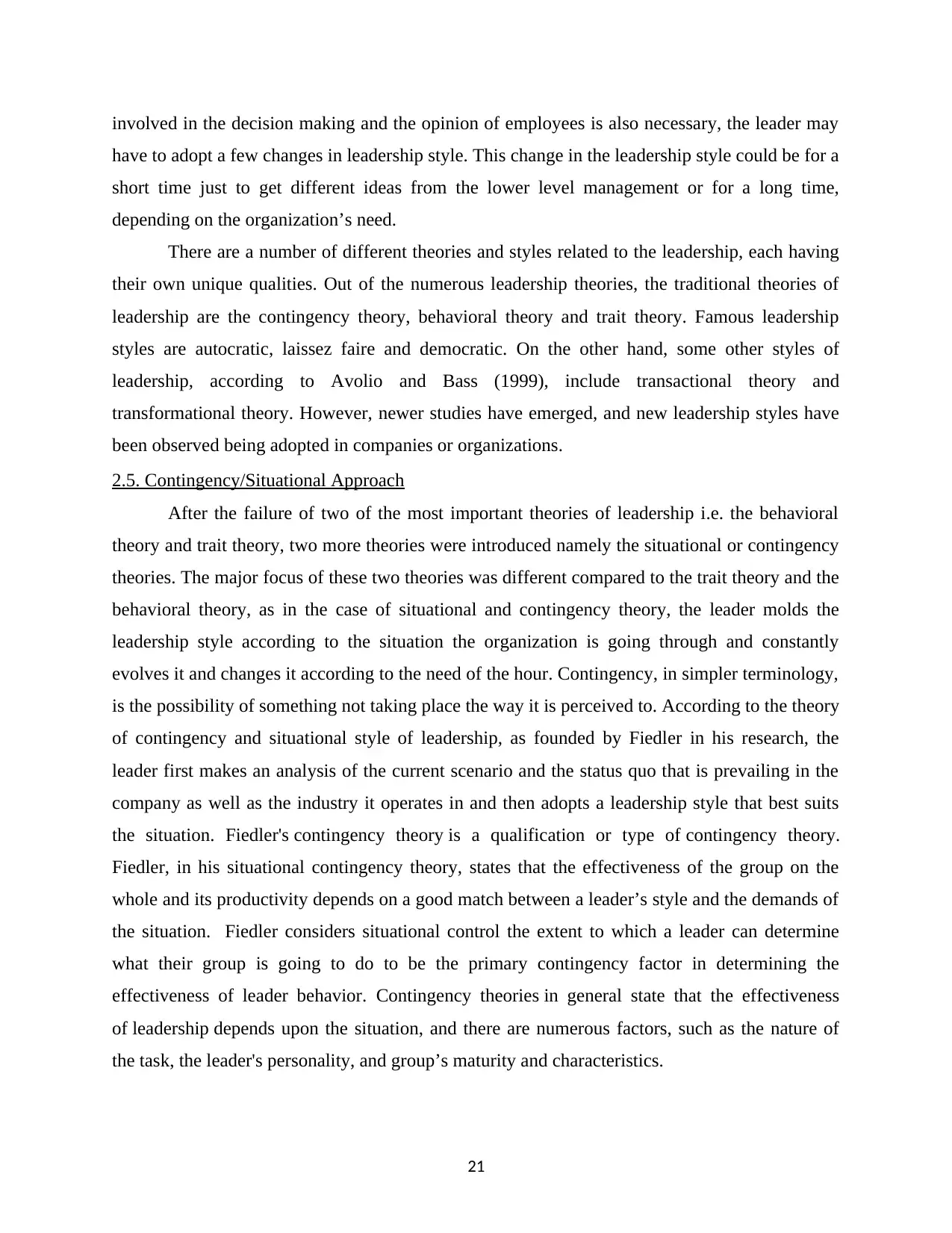
involved in the decision making and the opinion of employees is also necessary, the leader may
have to adopt a few changes in leadership style. This change in the leadership style could be for a
short time just to get different ideas from the lower level management or for a long time,
depending on the organization’s need.
There are a number of different theories and styles related to the leadership, each having
their own unique qualities. Out of the numerous leadership theories, the traditional theories of
leadership are the contingency theory, behavioral theory and trait theory. Famous leadership
styles are autocratic, laissez faire and democratic. On the other hand, some other styles of
leadership, according to Avolio and Bass (1999), include transactional theory and
transformational theory. However, newer studies have emerged, and new leadership styles have
been observed being adopted in companies or organizations.
2.5. Contingency/Situational Approach
After the failure of two of the most important theories of leadership i.e. the behavioral
theory and trait theory, two more theories were introduced namely the situational or contingency
theories. The major focus of these two theories was different compared to the trait theory and the
behavioral theory, as in the case of situational and contingency theory, the leader molds the
leadership style according to the situation the organization is going through and constantly
evolves it and changes it according to the need of the hour. Contingency, in simpler terminology,
is the possibility of something not taking place the way it is perceived to. According to the theory
of contingency and situational style of leadership, as founded by Fiedler in his research, the
leader first makes an analysis of the current scenario and the status quo that is prevailing in the
company as well as the industry it operates in and then adopts a leadership style that best suits
the situation. Fiedler's contingency theory is a qualification or type of contingency theory.
Fiedler, in his situational contingency theory, states that the effectiveness of the group on the
whole and its productivity depends on a good match between a leader’s style and the demands of
the situation. Fiedler considers situational control the extent to which a leader can determine
what their group is going to do to be the primary contingency factor in determining the
effectiveness of leader behavior. Contingency theories in general state that the effectiveness
of leadership depends upon the situation, and there are numerous factors, such as the nature of
the task, the leader's personality, and group’s maturity and characteristics.
21
have to adopt a few changes in leadership style. This change in the leadership style could be for a
short time just to get different ideas from the lower level management or for a long time,
depending on the organization’s need.
There are a number of different theories and styles related to the leadership, each having
their own unique qualities. Out of the numerous leadership theories, the traditional theories of
leadership are the contingency theory, behavioral theory and trait theory. Famous leadership
styles are autocratic, laissez faire and democratic. On the other hand, some other styles of
leadership, according to Avolio and Bass (1999), include transactional theory and
transformational theory. However, newer studies have emerged, and new leadership styles have
been observed being adopted in companies or organizations.
2.5. Contingency/Situational Approach
After the failure of two of the most important theories of leadership i.e. the behavioral
theory and trait theory, two more theories were introduced namely the situational or contingency
theories. The major focus of these two theories was different compared to the trait theory and the
behavioral theory, as in the case of situational and contingency theory, the leader molds the
leadership style according to the situation the organization is going through and constantly
evolves it and changes it according to the need of the hour. Contingency, in simpler terminology,
is the possibility of something not taking place the way it is perceived to. According to the theory
of contingency and situational style of leadership, as founded by Fiedler in his research, the
leader first makes an analysis of the current scenario and the status quo that is prevailing in the
company as well as the industry it operates in and then adopts a leadership style that best suits
the situation. Fiedler's contingency theory is a qualification or type of contingency theory.
Fiedler, in his situational contingency theory, states that the effectiveness of the group on the
whole and its productivity depends on a good match between a leader’s style and the demands of
the situation. Fiedler considers situational control the extent to which a leader can determine
what their group is going to do to be the primary contingency factor in determining the
effectiveness of leader behavior. Contingency theories in general state that the effectiveness
of leadership depends upon the situation, and there are numerous factors, such as the nature of
the task, the leader's personality, and group’s maturity and characteristics.
21
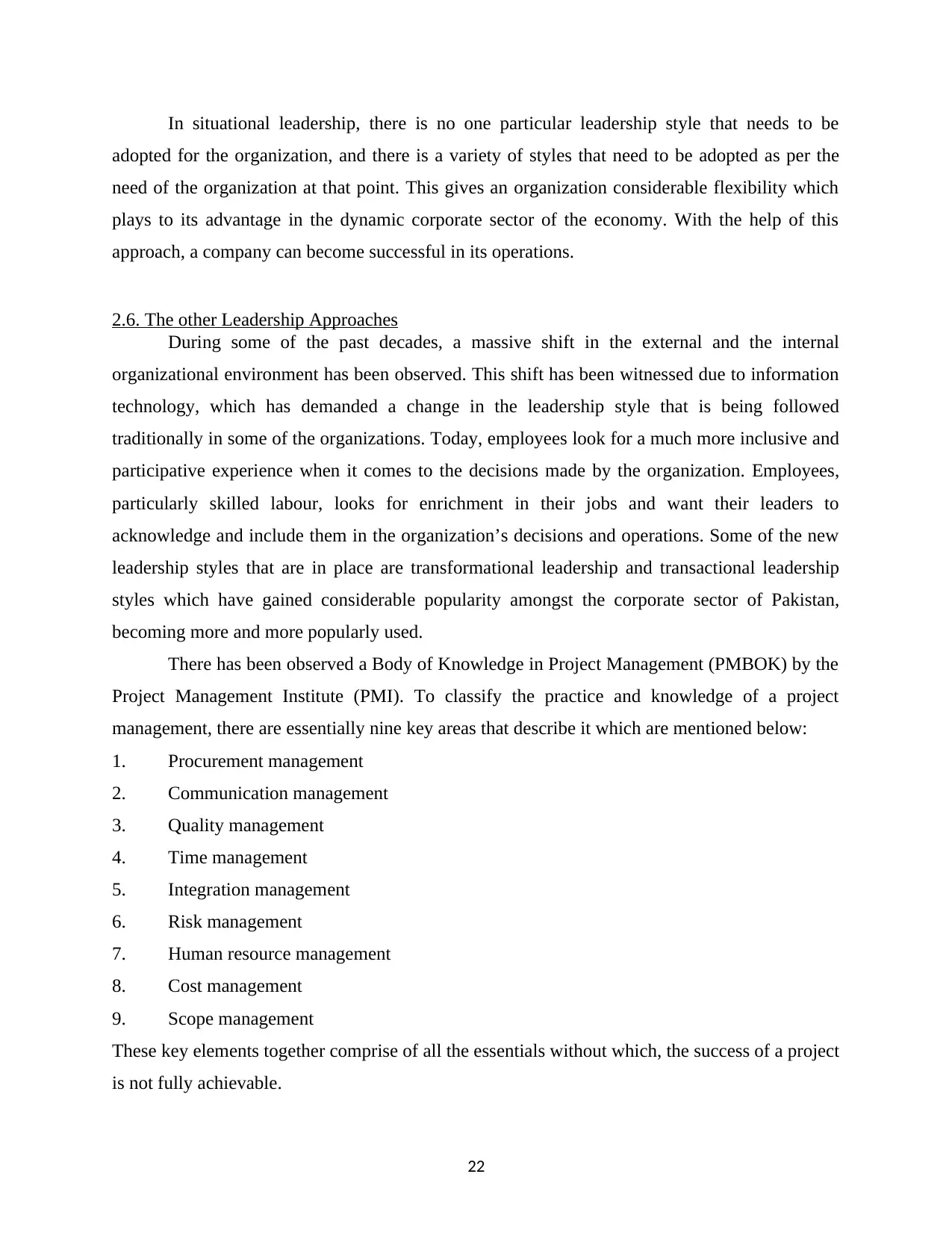
In situational leadership, there is no one particular leadership style that needs to be
adopted for the organization, and there is a variety of styles that need to be adopted as per the
need of the organization at that point. This gives an organization considerable flexibility which
plays to its advantage in the dynamic corporate sector of the economy. With the help of this
approach, a company can become successful in its operations.
2.6. The other Leadership Approaches
During some of the past decades, a massive shift in the external and the internal
organizational environment has been observed. This shift has been witnessed due to information
technology, which has demanded a change in the leadership style that is being followed
traditionally in some of the organizations. Today, employees look for a much more inclusive and
participative experience when it comes to the decisions made by the organization. Employees,
particularly skilled labour, looks for enrichment in their jobs and want their leaders to
acknowledge and include them in the organization’s decisions and operations. Some of the new
leadership styles that are in place are transformational leadership and transactional leadership
styles which have gained considerable popularity amongst the corporate sector of Pakistan,
becoming more and more popularly used.
There has been observed a Body of Knowledge in Project Management (PMBOK) by the
Project Management Institute (PMI). To classify the practice and knowledge of a project
management, there are essentially nine key areas that describe it which are mentioned below:
1. Procurement management
2. Communication management
3. Quality management
4. Time management
5. Integration management
6. Risk management
7. Human resource management
8. Cost management
9. Scope management
These key elements together comprise of all the essentials without which, the success of a project
is not fully achievable.
22
adopted for the organization, and there is a variety of styles that need to be adopted as per the
need of the organization at that point. This gives an organization considerable flexibility which
plays to its advantage in the dynamic corporate sector of the economy. With the help of this
approach, a company can become successful in its operations.
2.6. The other Leadership Approaches
During some of the past decades, a massive shift in the external and the internal
organizational environment has been observed. This shift has been witnessed due to information
technology, which has demanded a change in the leadership style that is being followed
traditionally in some of the organizations. Today, employees look for a much more inclusive and
participative experience when it comes to the decisions made by the organization. Employees,
particularly skilled labour, looks for enrichment in their jobs and want their leaders to
acknowledge and include them in the organization’s decisions and operations. Some of the new
leadership styles that are in place are transformational leadership and transactional leadership
styles which have gained considerable popularity amongst the corporate sector of Pakistan,
becoming more and more popularly used.
There has been observed a Body of Knowledge in Project Management (PMBOK) by the
Project Management Institute (PMI). To classify the practice and knowledge of a project
management, there are essentially nine key areas that describe it which are mentioned below:
1. Procurement management
2. Communication management
3. Quality management
4. Time management
5. Integration management
6. Risk management
7. Human resource management
8. Cost management
9. Scope management
These key elements together comprise of all the essentials without which, the success of a project
is not fully achievable.
22
Paraphrase This Document
Need a fresh take? Get an instant paraphrase of this document with our AI Paraphraser
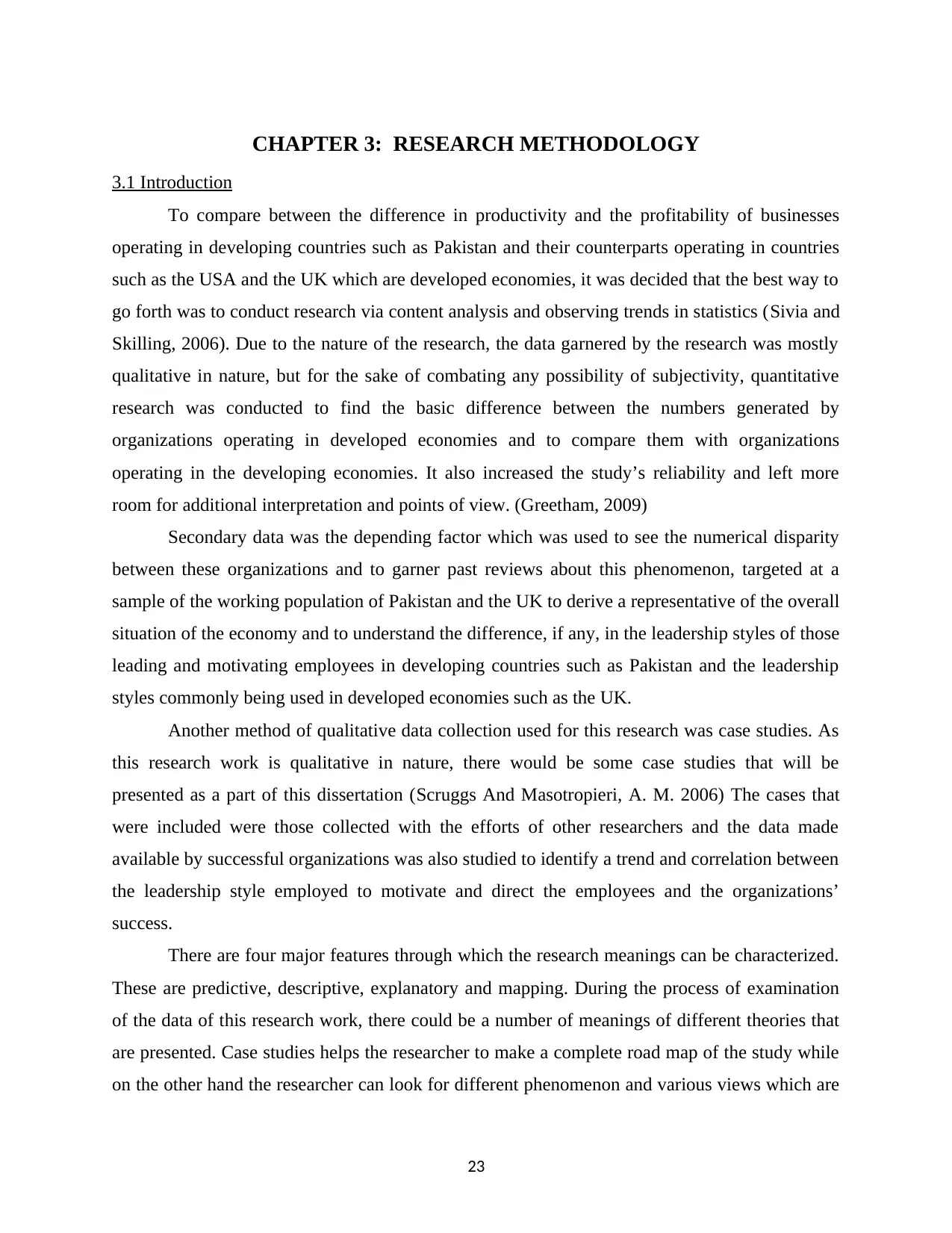
CHAPTER 3: RESEARCH METHODOLOGY
3.1 Introduction
To compare between the difference in productivity and the profitability of businesses
operating in developing countries such as Pakistan and their counterparts operating in countries
such as the USA and the UK which are developed economies, it was decided that the best way to
go forth was to conduct research via content analysis and observing trends in statistics (Sivia and
Skilling, 2006). Due to the nature of the research, the data garnered by the research was mostly
qualitative in nature, but for the sake of combating any possibility of subjectivity, quantitative
research was conducted to find the basic difference between the numbers generated by
organizations operating in developed economies and to compare them with organizations
operating in the developing economies. It also increased the study’s reliability and left more
room for additional interpretation and points of view. (Greetham, 2009)
Secondary data was the depending factor which was used to see the numerical disparity
between these organizations and to garner past reviews about this phenomenon, targeted at a
sample of the working population of Pakistan and the UK to derive a representative of the overall
situation of the economy and to understand the difference, if any, in the leadership styles of those
leading and motivating employees in developing countries such as Pakistan and the leadership
styles commonly being used in developed economies such as the UK.
Another method of qualitative data collection used for this research was case studies. As
this research work is qualitative in nature, there would be some case studies that will be
presented as a part of this dissertation (Scruggs And Masotropieri, A. M. 2006) The cases that
were included were those collected with the efforts of other researchers and the data made
available by successful organizations was also studied to identify a trend and correlation between
the leadership style employed to motivate and direct the employees and the organizations’
success.
There are four major features through which the research meanings can be characterized.
These are predictive, descriptive, explanatory and mapping. During the process of examination
of the data of this research work, there could be a number of meanings of different theories that
are presented. Case studies helps the researcher to make a complete road map of the study while
on the other hand the researcher can look for different phenomenon and various views which are
23
3.1 Introduction
To compare between the difference in productivity and the profitability of businesses
operating in developing countries such as Pakistan and their counterparts operating in countries
such as the USA and the UK which are developed economies, it was decided that the best way to
go forth was to conduct research via content analysis and observing trends in statistics (Sivia and
Skilling, 2006). Due to the nature of the research, the data garnered by the research was mostly
qualitative in nature, but for the sake of combating any possibility of subjectivity, quantitative
research was conducted to find the basic difference between the numbers generated by
organizations operating in developed economies and to compare them with organizations
operating in the developing economies. It also increased the study’s reliability and left more
room for additional interpretation and points of view. (Greetham, 2009)
Secondary data was the depending factor which was used to see the numerical disparity
between these organizations and to garner past reviews about this phenomenon, targeted at a
sample of the working population of Pakistan and the UK to derive a representative of the overall
situation of the economy and to understand the difference, if any, in the leadership styles of those
leading and motivating employees in developing countries such as Pakistan and the leadership
styles commonly being used in developed economies such as the UK.
Another method of qualitative data collection used for this research was case studies. As
this research work is qualitative in nature, there would be some case studies that will be
presented as a part of this dissertation (Scruggs And Masotropieri, A. M. 2006) The cases that
were included were those collected with the efforts of other researchers and the data made
available by successful organizations was also studied to identify a trend and correlation between
the leadership style employed to motivate and direct the employees and the organizations’
success.
There are four major features through which the research meanings can be characterized.
These are predictive, descriptive, explanatory and mapping. During the process of examination
of the data of this research work, there could be a number of meanings of different theories that
are presented. Case studies helps the researcher to make a complete road map of the study while
on the other hand the researcher can look for different phenomenon and various views which are
23
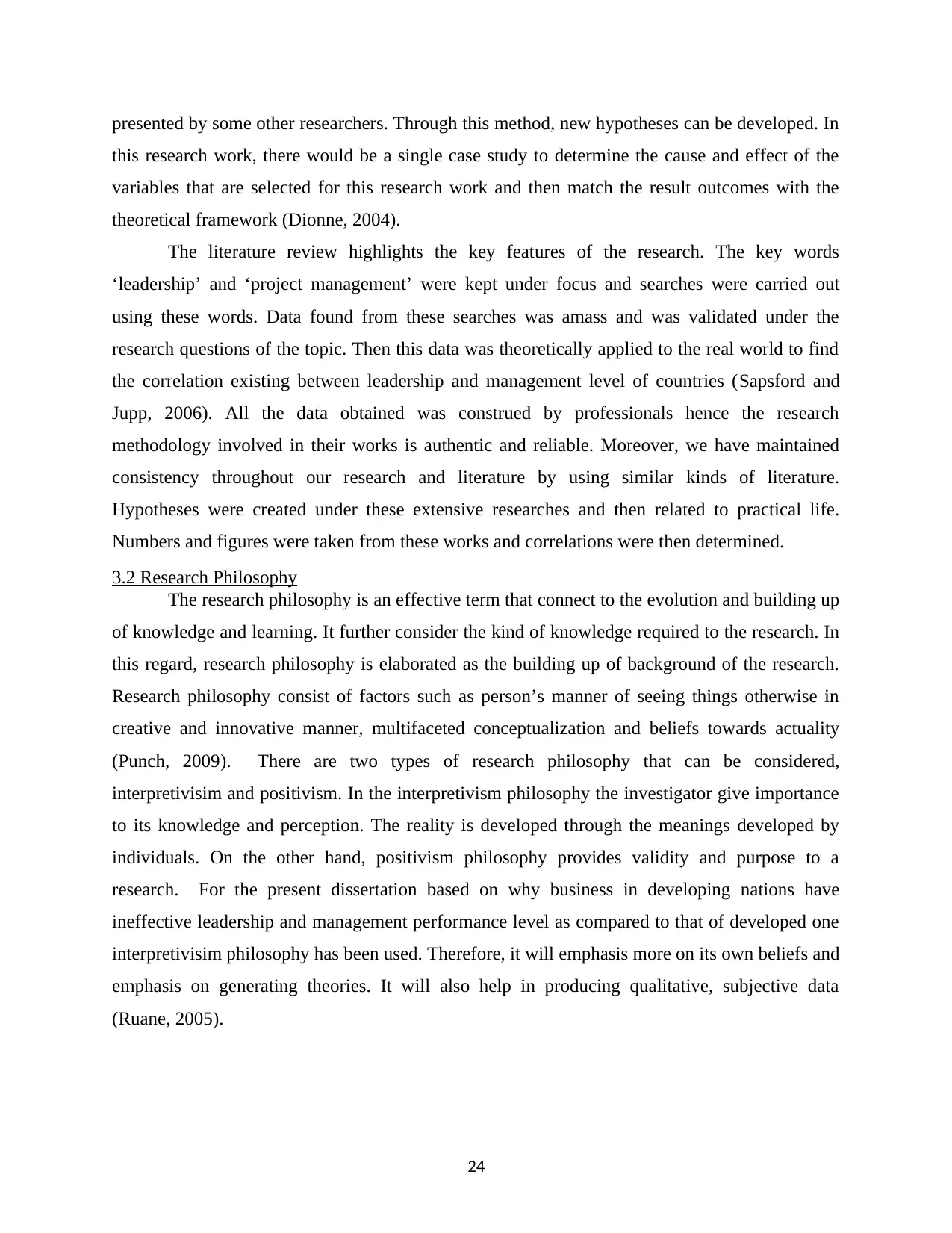
presented by some other researchers. Through this method, new hypotheses can be developed. In
this research work, there would be a single case study to determine the cause and effect of the
variables that are selected for this research work and then match the result outcomes with the
theoretical framework (Dionne, 2004).
The literature review highlights the key features of the research. The key words
‘leadership’ and ‘project management’ were kept under focus and searches were carried out
using these words. Data found from these searches was amass and was validated under the
research questions of the topic. Then this data was theoretically applied to the real world to find
the correlation existing between leadership and management level of countries (Sapsford and
Jupp, 2006). All the data obtained was construed by professionals hence the research
methodology involved in their works is authentic and reliable. Moreover, we have maintained
consistency throughout our research and literature by using similar kinds of literature.
Hypotheses were created under these extensive researches and then related to practical life.
Numbers and figures were taken from these works and correlations were then determined.
3.2 Research Philosophy
The research philosophy is an effective term that connect to the evolution and building up
of knowledge and learning. It further consider the kind of knowledge required to the research. In
this regard, research philosophy is elaborated as the building up of background of the research.
Research philosophy consist of factors such as person’s manner of seeing things otherwise in
creative and innovative manner, multifaceted conceptualization and beliefs towards actuality
(Punch, 2009). There are two types of research philosophy that can be considered,
interpretivisim and positivism. In the interpretivism philosophy the investigator give importance
to its knowledge and perception. The reality is developed through the meanings developed by
individuals. On the other hand, positivism philosophy provides validity and purpose to a
research. For the present dissertation based on why business in developing nations have
ineffective leadership and management performance level as compared to that of developed one
interpretivisim philosophy has been used. Therefore, it will emphasis more on its own beliefs and
emphasis on generating theories. It will also help in producing qualitative, subjective data
(Ruane, 2005).
24
this research work, there would be a single case study to determine the cause and effect of the
variables that are selected for this research work and then match the result outcomes with the
theoretical framework (Dionne, 2004).
The literature review highlights the key features of the research. The key words
‘leadership’ and ‘project management’ were kept under focus and searches were carried out
using these words. Data found from these searches was amass and was validated under the
research questions of the topic. Then this data was theoretically applied to the real world to find
the correlation existing between leadership and management level of countries (Sapsford and
Jupp, 2006). All the data obtained was construed by professionals hence the research
methodology involved in their works is authentic and reliable. Moreover, we have maintained
consistency throughout our research and literature by using similar kinds of literature.
Hypotheses were created under these extensive researches and then related to practical life.
Numbers and figures were taken from these works and correlations were then determined.
3.2 Research Philosophy
The research philosophy is an effective term that connect to the evolution and building up
of knowledge and learning. It further consider the kind of knowledge required to the research. In
this regard, research philosophy is elaborated as the building up of background of the research.
Research philosophy consist of factors such as person’s manner of seeing things otherwise in
creative and innovative manner, multifaceted conceptualization and beliefs towards actuality
(Punch, 2009). There are two types of research philosophy that can be considered,
interpretivisim and positivism. In the interpretivism philosophy the investigator give importance
to its knowledge and perception. The reality is developed through the meanings developed by
individuals. On the other hand, positivism philosophy provides validity and purpose to a
research. For the present dissertation based on why business in developing nations have
ineffective leadership and management performance level as compared to that of developed one
interpretivisim philosophy has been used. Therefore, it will emphasis more on its own beliefs and
emphasis on generating theories. It will also help in producing qualitative, subjective data
(Ruane, 2005).
24
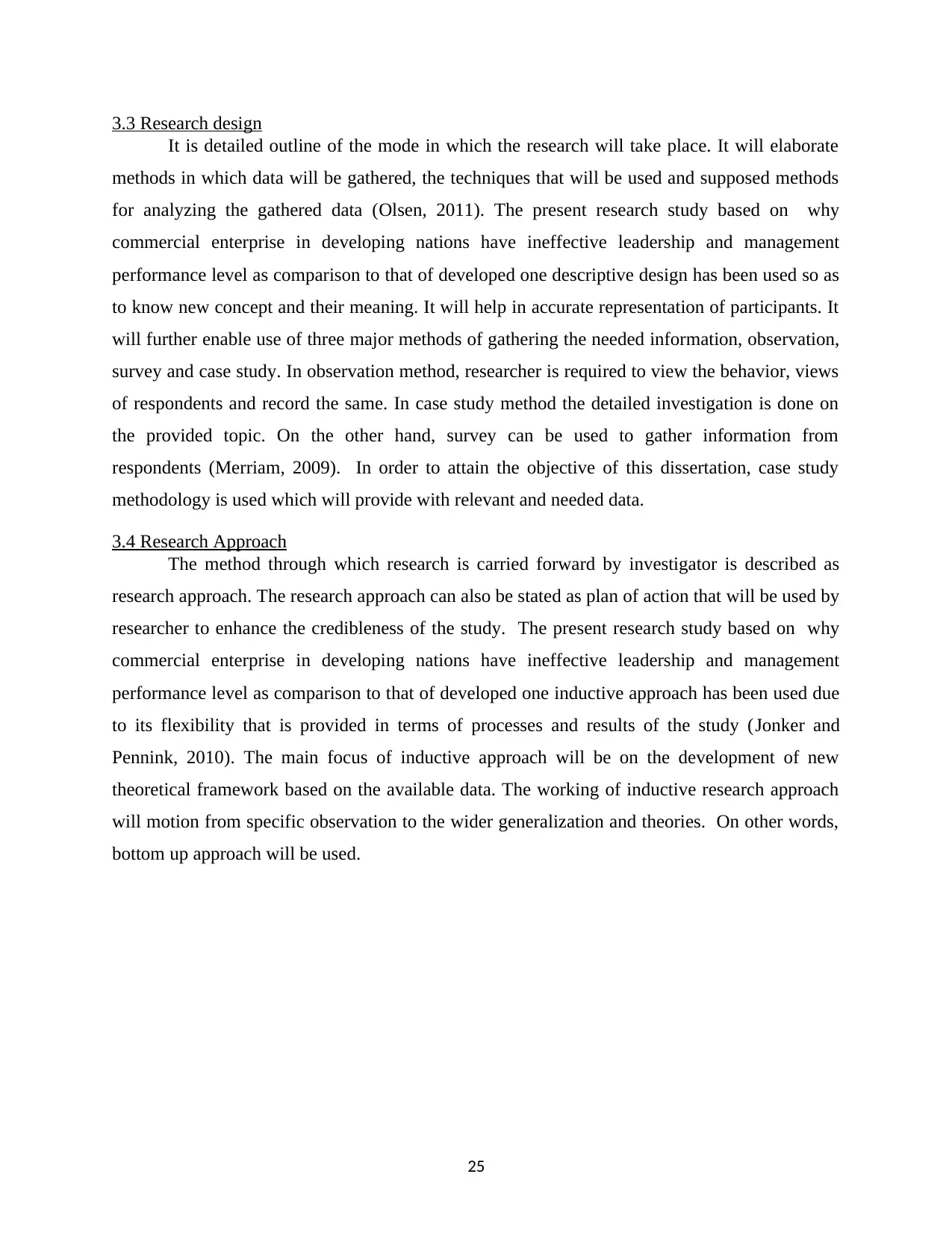
3.3 Research design
It is detailed outline of the mode in which the research will take place. It will elaborate
methods in which data will be gathered, the techniques that will be used and supposed methods
for analyzing the gathered data (Olsen, 2011). The present research study based on why
commercial enterprise in developing nations have ineffective leadership and management
performance level as comparison to that of developed one descriptive design has been used so as
to know new concept and their meaning. It will help in accurate representation of participants. It
will further enable use of three major methods of gathering the needed information, observation,
survey and case study. In observation method, researcher is required to view the behavior, views
of respondents and record the same. In case study method the detailed investigation is done on
the provided topic. On the other hand, survey can be used to gather information from
respondents (Merriam, 2009). In order to attain the objective of this dissertation, case study
methodology is used which will provide with relevant and needed data.
3.4 Research Approach
The method through which research is carried forward by investigator is described as
research approach. The research approach can also be stated as plan of action that will be used by
researcher to enhance the credibleness of the study. The present research study based on why
commercial enterprise in developing nations have ineffective leadership and management
performance level as comparison to that of developed one inductive approach has been used due
to its flexibility that is provided in terms of processes and results of the study (Jonker and
Pennink, 2010). The main focus of inductive approach will be on the development of new
theoretical framework based on the available data. The working of inductive research approach
will motion from specific observation to the wider generalization and theories. On other words,
bottom up approach will be used.
25
It is detailed outline of the mode in which the research will take place. It will elaborate
methods in which data will be gathered, the techniques that will be used and supposed methods
for analyzing the gathered data (Olsen, 2011). The present research study based on why
commercial enterprise in developing nations have ineffective leadership and management
performance level as comparison to that of developed one descriptive design has been used so as
to know new concept and their meaning. It will help in accurate representation of participants. It
will further enable use of three major methods of gathering the needed information, observation,
survey and case study. In observation method, researcher is required to view the behavior, views
of respondents and record the same. In case study method the detailed investigation is done on
the provided topic. On the other hand, survey can be used to gather information from
respondents (Merriam, 2009). In order to attain the objective of this dissertation, case study
methodology is used which will provide with relevant and needed data.
3.4 Research Approach
The method through which research is carried forward by investigator is described as
research approach. The research approach can also be stated as plan of action that will be used by
researcher to enhance the credibleness of the study. The present research study based on why
commercial enterprise in developing nations have ineffective leadership and management
performance level as comparison to that of developed one inductive approach has been used due
to its flexibility that is provided in terms of processes and results of the study (Jonker and
Pennink, 2010). The main focus of inductive approach will be on the development of new
theoretical framework based on the available data. The working of inductive research approach
will motion from specific observation to the wider generalization and theories. On other words,
bottom up approach will be used.
25
Secure Best Marks with AI Grader
Need help grading? Try our AI Grader for instant feedback on your assignments.

3.5 Research type
Basically, three kinds of research are adopted by investigators, qualitative, quantitative
and case study. Qualitative research is preoccupied by the notion of consideration of problems
and understanding of concepts. It furnish answers to questions by examining and providing
awareness of unorganized data. This sort of investigation makes utilization of in depth studies.
The outcome of qualitative studies are descriptive (Guerin, 2006). Further, the quantitative
research is associated to organized investigation of social phenomena with means taking
assistance of statistical or techniques related to scientific discipline. The important purpose of
this research is to tally and sort features and build statistical models. Quantitative investigation
exercise instrument such as questionnaires, surveys etc. for accumulation of primary data. The
present research on why commercial enterprise in developing nations have ineffective leadership
and management performance level as comparison to that of developed one qualitative research
has been used. Therefore, subjective approach will be used to enable in-depth description in
narrative form. The unstructured data will be conducted to develop understanding (Jackson,
2010).
3.6 Data collection methods
The data collection method is process of gathering and collecting information from varied
sources so as to attain the key purpose of the study. Broadly, there are two methods for gathering
information such as primary and secondary (Grbich, 2012). The present research on why
commercial enterprise in developing nations have ineffective leadership and management
performance level as comparison to that of developed one secondary information will be used.
26
Illustration 1: Inductive Research approach
Basically, three kinds of research are adopted by investigators, qualitative, quantitative
and case study. Qualitative research is preoccupied by the notion of consideration of problems
and understanding of concepts. It furnish answers to questions by examining and providing
awareness of unorganized data. This sort of investigation makes utilization of in depth studies.
The outcome of qualitative studies are descriptive (Guerin, 2006). Further, the quantitative
research is associated to organized investigation of social phenomena with means taking
assistance of statistical or techniques related to scientific discipline. The important purpose of
this research is to tally and sort features and build statistical models. Quantitative investigation
exercise instrument such as questionnaires, surveys etc. for accumulation of primary data. The
present research on why commercial enterprise in developing nations have ineffective leadership
and management performance level as comparison to that of developed one qualitative research
has been used. Therefore, subjective approach will be used to enable in-depth description in
narrative form. The unstructured data will be conducted to develop understanding (Jackson,
2010).
3.6 Data collection methods
The data collection method is process of gathering and collecting information from varied
sources so as to attain the key purpose of the study. Broadly, there are two methods for gathering
information such as primary and secondary (Grbich, 2012). The present research on why
commercial enterprise in developing nations have ineffective leadership and management
performance level as comparison to that of developed one secondary information will be used.
26
Illustration 1: Inductive Research approach
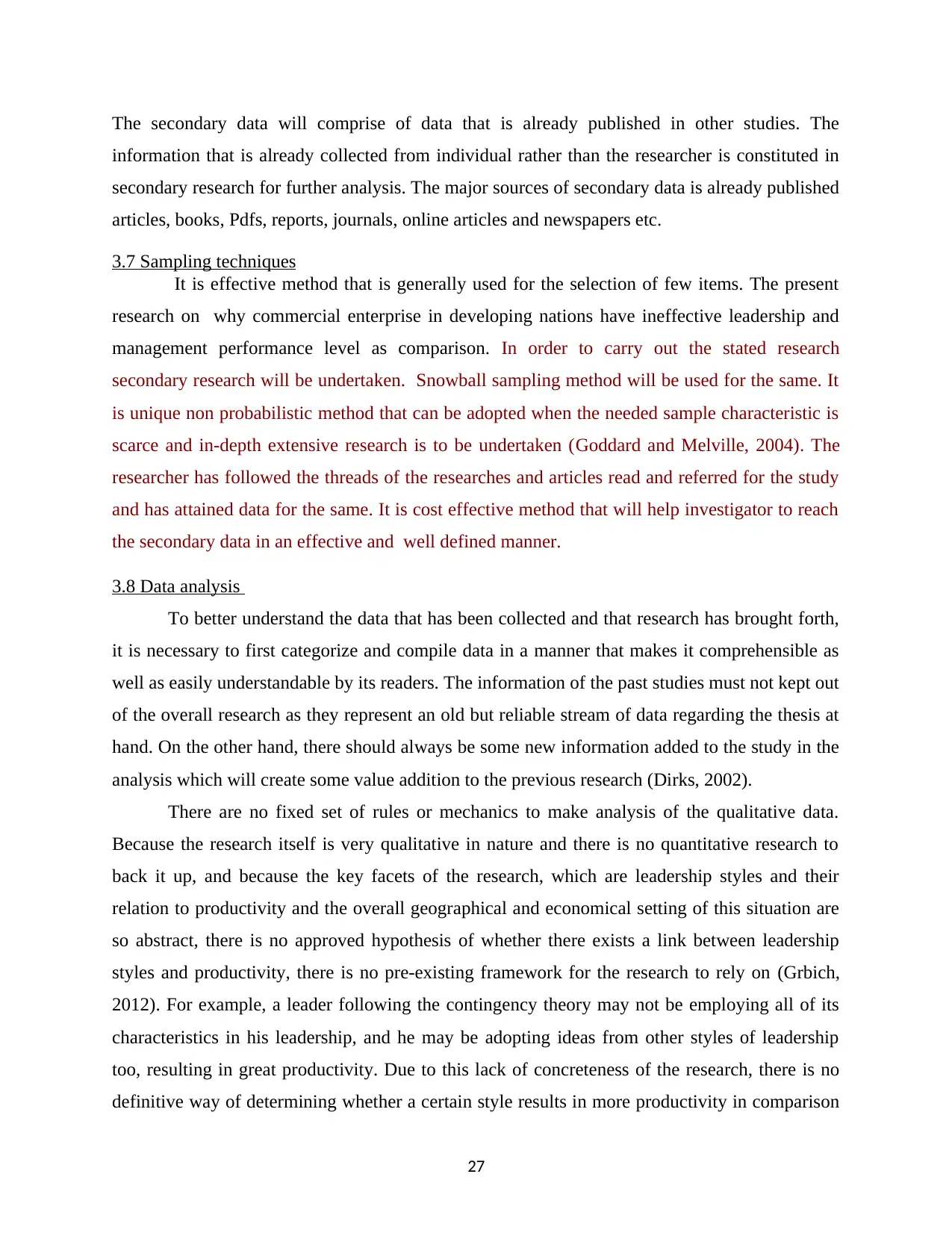
The secondary data will comprise of data that is already published in other studies. The
information that is already collected from individual rather than the researcher is constituted in
secondary research for further analysis. The major sources of secondary data is already published
articles, books, Pdfs, reports, journals, online articles and newspapers etc.
3.7 Sampling techniques
It is effective method that is generally used for the selection of few items. The present
research on why commercial enterprise in developing nations have ineffective leadership and
management performance level as comparison. In order to carry out the stated research
secondary research will be undertaken. Snowball sampling method will be used for the same. It
is unique non probabilistic method that can be adopted when the needed sample characteristic is
scarce and in-depth extensive research is to be undertaken (Goddard and Melville, 2004). The
researcher has followed the threads of the researches and articles read and referred for the study
and has attained data for the same. It is cost effective method that will help investigator to reach
the secondary data in an effective and well defined manner.
3.8 Data analysis
To better understand the data that has been collected and that research has brought forth,
it is necessary to first categorize and compile data in a manner that makes it comprehensible as
well as easily understandable by its readers. The information of the past studies must not kept out
of the overall research as they represent an old but reliable stream of data regarding the thesis at
hand. On the other hand, there should always be some new information added to the study in the
analysis which will create some value addition to the previous research (Dirks, 2002).
There are no fixed set of rules or mechanics to make analysis of the qualitative data.
Because the research itself is very qualitative in nature and there is no quantitative research to
back it up, and because the key facets of the research, which are leadership styles and their
relation to productivity and the overall geographical and economical setting of this situation are
so abstract, there is no approved hypothesis of whether there exists a link between leadership
styles and productivity, there is no pre-existing framework for the research to rely on (Grbich,
2012). For example, a leader following the contingency theory may not be employing all of its
characteristics in his leadership, and he may be adopting ideas from other styles of leadership
too, resulting in great productivity. Due to this lack of concreteness of the research, there is no
definitive way of determining whether a certain style results in more productivity in comparison
27
information that is already collected from individual rather than the researcher is constituted in
secondary research for further analysis. The major sources of secondary data is already published
articles, books, Pdfs, reports, journals, online articles and newspapers etc.
3.7 Sampling techniques
It is effective method that is generally used for the selection of few items. The present
research on why commercial enterprise in developing nations have ineffective leadership and
management performance level as comparison. In order to carry out the stated research
secondary research will be undertaken. Snowball sampling method will be used for the same. It
is unique non probabilistic method that can be adopted when the needed sample characteristic is
scarce and in-depth extensive research is to be undertaken (Goddard and Melville, 2004). The
researcher has followed the threads of the researches and articles read and referred for the study
and has attained data for the same. It is cost effective method that will help investigator to reach
the secondary data in an effective and well defined manner.
3.8 Data analysis
To better understand the data that has been collected and that research has brought forth,
it is necessary to first categorize and compile data in a manner that makes it comprehensible as
well as easily understandable by its readers. The information of the past studies must not kept out
of the overall research as they represent an old but reliable stream of data regarding the thesis at
hand. On the other hand, there should always be some new information added to the study in the
analysis which will create some value addition to the previous research (Dirks, 2002).
There are no fixed set of rules or mechanics to make analysis of the qualitative data.
Because the research itself is very qualitative in nature and there is no quantitative research to
back it up, and because the key facets of the research, which are leadership styles and their
relation to productivity and the overall geographical and economical setting of this situation are
so abstract, there is no approved hypothesis of whether there exists a link between leadership
styles and productivity, there is no pre-existing framework for the research to rely on (Grbich,
2012). For example, a leader following the contingency theory may not be employing all of its
characteristics in his leadership, and he may be adopting ideas from other styles of leadership
too, resulting in great productivity. Due to this lack of concreteness of the research, there is no
definitive way of determining whether a certain style results in more productivity in comparison
27
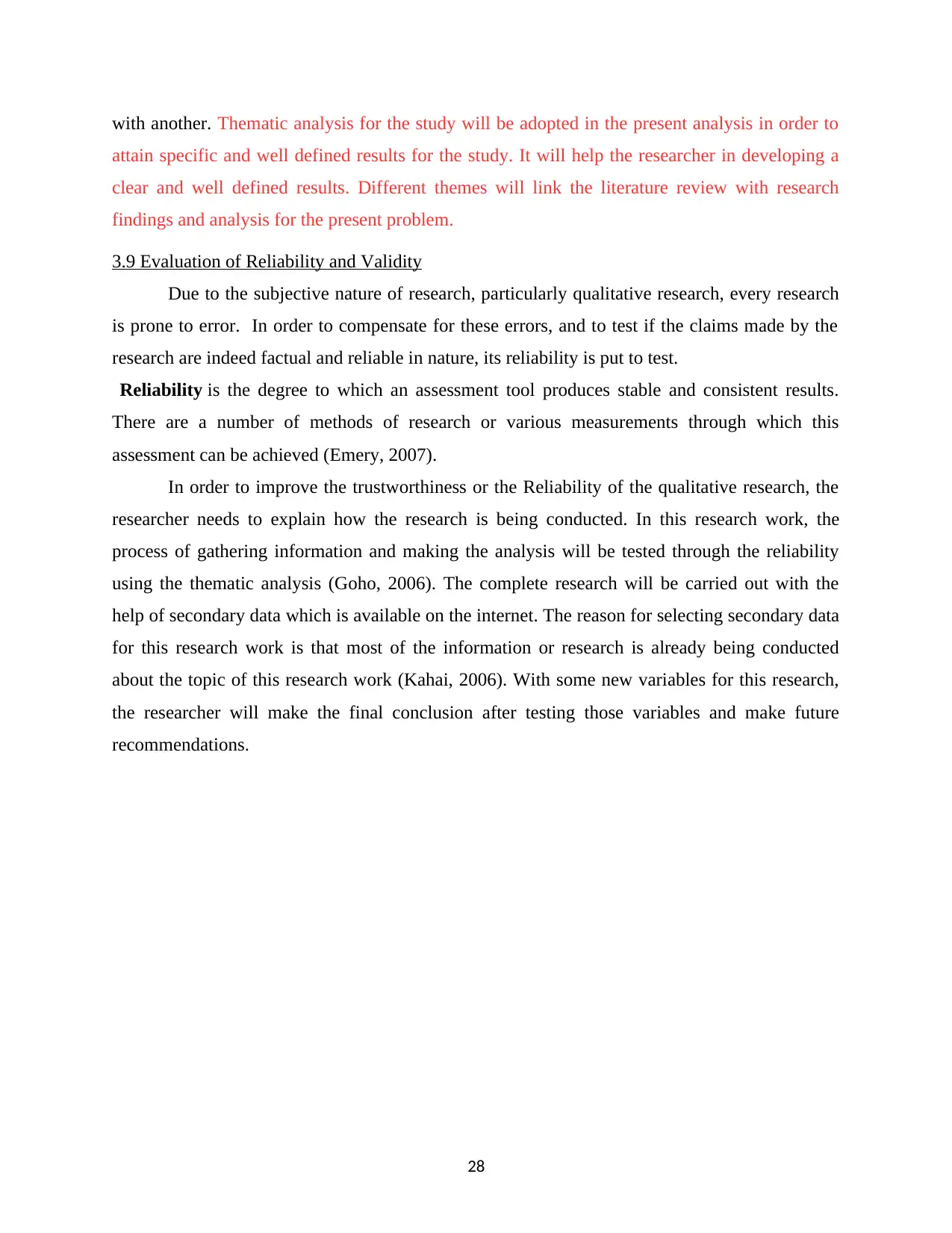
with another. Thematic analysis for the study will be adopted in the present analysis in order to
attain specific and well defined results for the study. It will help the researcher in developing a
clear and well defined results. Different themes will link the literature review with research
findings and analysis for the present problem.
3.9 Evaluation of Reliability and Validity
Due to the subjective nature of research, particularly qualitative research, every research
is prone to error. In order to compensate for these errors, and to test if the claims made by the
research are indeed factual and reliable in nature, its reliability is put to test.
Reliability is the degree to which an assessment tool produces stable and consistent results.
There are a number of methods of research or various measurements through which this
assessment can be achieved (Emery, 2007).
In order to improve the trustworthiness or the Reliability of the qualitative research, the
researcher needs to explain how the research is being conducted. In this research work, the
process of gathering information and making the analysis will be tested through the reliability
using the thematic analysis (Goho, 2006). The complete research will be carried out with the
help of secondary data which is available on the internet. The reason for selecting secondary data
for this research work is that most of the information or research is already being conducted
about the topic of this research work (Kahai, 2006). With some new variables for this research,
the researcher will make the final conclusion after testing those variables and make future
recommendations.
28
attain specific and well defined results for the study. It will help the researcher in developing a
clear and well defined results. Different themes will link the literature review with research
findings and analysis for the present problem.
3.9 Evaluation of Reliability and Validity
Due to the subjective nature of research, particularly qualitative research, every research
is prone to error. In order to compensate for these errors, and to test if the claims made by the
research are indeed factual and reliable in nature, its reliability is put to test.
Reliability is the degree to which an assessment tool produces stable and consistent results.
There are a number of methods of research or various measurements through which this
assessment can be achieved (Emery, 2007).
In order to improve the trustworthiness or the Reliability of the qualitative research, the
researcher needs to explain how the research is being conducted. In this research work, the
process of gathering information and making the analysis will be tested through the reliability
using the thematic analysis (Goho, 2006). The complete research will be carried out with the
help of secondary data which is available on the internet. The reason for selecting secondary data
for this research work is that most of the information or research is already being conducted
about the topic of this research work (Kahai, 2006). With some new variables for this research,
the researcher will make the final conclusion after testing those variables and make future
recommendations.
28
Paraphrase This Document
Need a fresh take? Get an instant paraphrase of this document with our AI Paraphraser
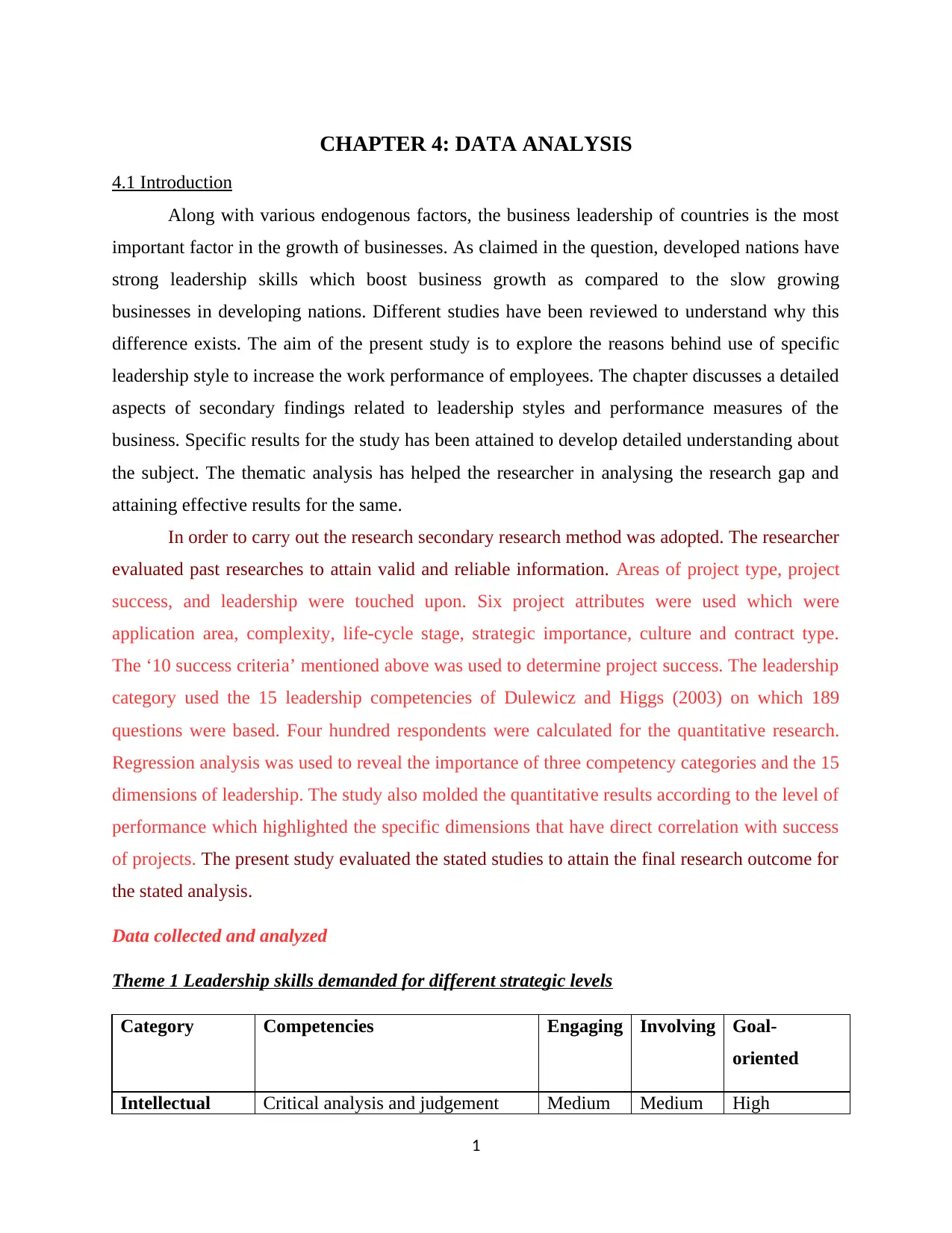
CHAPTER 4: DATA ANALYSIS
4.1 Introduction
Along with various endogenous factors, the business leadership of countries is the most
important factor in the growth of businesses. As claimed in the question, developed nations have
strong leadership skills which boost business growth as compared to the slow growing
businesses in developing nations. Different studies have been reviewed to understand why this
difference exists. The aim of the present study is to explore the reasons behind use of specific
leadership style to increase the work performance of employees. The chapter discusses a detailed
aspects of secondary findings related to leadership styles and performance measures of the
business. Specific results for the study has been attained to develop detailed understanding about
the subject. The thematic analysis has helped the researcher in analysing the research gap and
attaining effective results for the same.
In order to carry out the research secondary research method was adopted. The researcher
evaluated past researches to attain valid and reliable information. Areas of project type, project
success, and leadership were touched upon. Six project attributes were used which were
application area, complexity, life-cycle stage, strategic importance, culture and contract type.
The ‘10 success criteria’ mentioned above was used to determine project success. The leadership
category used the 15 leadership competencies of Dulewicz and Higgs (2003) on which 189
questions were based. Four hundred respondents were calculated for the quantitative research.
Regression analysis was used to reveal the importance of three competency categories and the 15
dimensions of leadership. The study also molded the quantitative results according to the level of
performance which highlighted the specific dimensions that have direct correlation with success
of projects. The present study evaluated the stated studies to attain the final research outcome for
the stated analysis.
Data collected and analyzed
Theme 1 Leadership skills demanded for different strategic levels
Category Competencies Engaging Involving Goal-
oriented
Intellectual Critical analysis and judgement Medium Medium High
1
4.1 Introduction
Along with various endogenous factors, the business leadership of countries is the most
important factor in the growth of businesses. As claimed in the question, developed nations have
strong leadership skills which boost business growth as compared to the slow growing
businesses in developing nations. Different studies have been reviewed to understand why this
difference exists. The aim of the present study is to explore the reasons behind use of specific
leadership style to increase the work performance of employees. The chapter discusses a detailed
aspects of secondary findings related to leadership styles and performance measures of the
business. Specific results for the study has been attained to develop detailed understanding about
the subject. The thematic analysis has helped the researcher in analysing the research gap and
attaining effective results for the same.
In order to carry out the research secondary research method was adopted. The researcher
evaluated past researches to attain valid and reliable information. Areas of project type, project
success, and leadership were touched upon. Six project attributes were used which were
application area, complexity, life-cycle stage, strategic importance, culture and contract type.
The ‘10 success criteria’ mentioned above was used to determine project success. The leadership
category used the 15 leadership competencies of Dulewicz and Higgs (2003) on which 189
questions were based. Four hundred respondents were calculated for the quantitative research.
Regression analysis was used to reveal the importance of three competency categories and the 15
dimensions of leadership. The study also molded the quantitative results according to the level of
performance which highlighted the specific dimensions that have direct correlation with success
of projects. The present study evaluated the stated studies to attain the final research outcome for
the stated analysis.
Data collected and analyzed
Theme 1 Leadership skills demanded for different strategic levels
Category Competencies Engaging Involving Goal-
oriented
Intellectual Critical analysis and judgement Medium Medium High
1
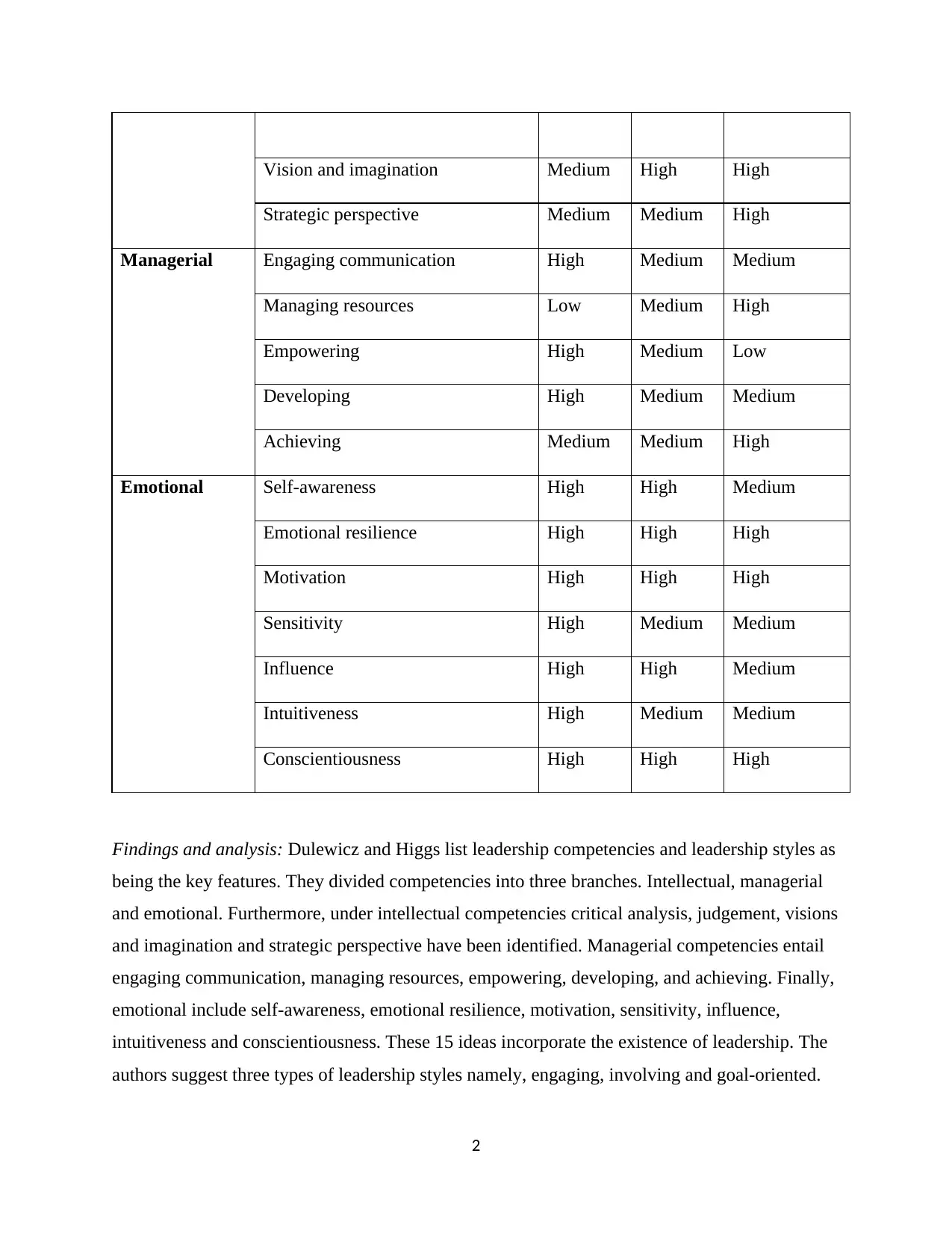
Vision and imagination Medium High High
Strategic perspective Medium Medium High
Managerial Engaging communication High Medium Medium
Managing resources Low Medium High
Empowering High Medium Low
Developing High Medium Medium
Achieving Medium Medium High
Emotional Self-awareness High High Medium
Emotional resilience High High High
Motivation High High High
Sensitivity High Medium Medium
Influence High High Medium
Intuitiveness High Medium Medium
Conscientiousness High High High
Findings and analysis: Dulewicz and Higgs list leadership competencies and leadership styles as
being the key features. They divided competencies into three branches. Intellectual, managerial
and emotional. Furthermore, under intellectual competencies critical analysis, judgement, visions
and imagination and strategic perspective have been identified. Managerial competencies entail
engaging communication, managing resources, empowering, developing, and achieving. Finally,
emotional include self-awareness, emotional resilience, motivation, sensitivity, influence,
intuitiveness and conscientiousness. These 15 ideas incorporate the existence of leadership. The
authors suggest three types of leadership styles namely, engaging, involving and goal-oriented.
2
Strategic perspective Medium Medium High
Managerial Engaging communication High Medium Medium
Managing resources Low Medium High
Empowering High Medium Low
Developing High Medium Medium
Achieving Medium Medium High
Emotional Self-awareness High High Medium
Emotional resilience High High High
Motivation High High High
Sensitivity High Medium Medium
Influence High High Medium
Intuitiveness High Medium Medium
Conscientiousness High High High
Findings and analysis: Dulewicz and Higgs list leadership competencies and leadership styles as
being the key features. They divided competencies into three branches. Intellectual, managerial
and emotional. Furthermore, under intellectual competencies critical analysis, judgement, visions
and imagination and strategic perspective have been identified. Managerial competencies entail
engaging communication, managing resources, empowering, developing, and achieving. Finally,
emotional include self-awareness, emotional resilience, motivation, sensitivity, influence,
intuitiveness and conscientiousness. These 15 ideas incorporate the existence of leadership. The
authors suggest three types of leadership styles namely, engaging, involving and goal-oriented.
2
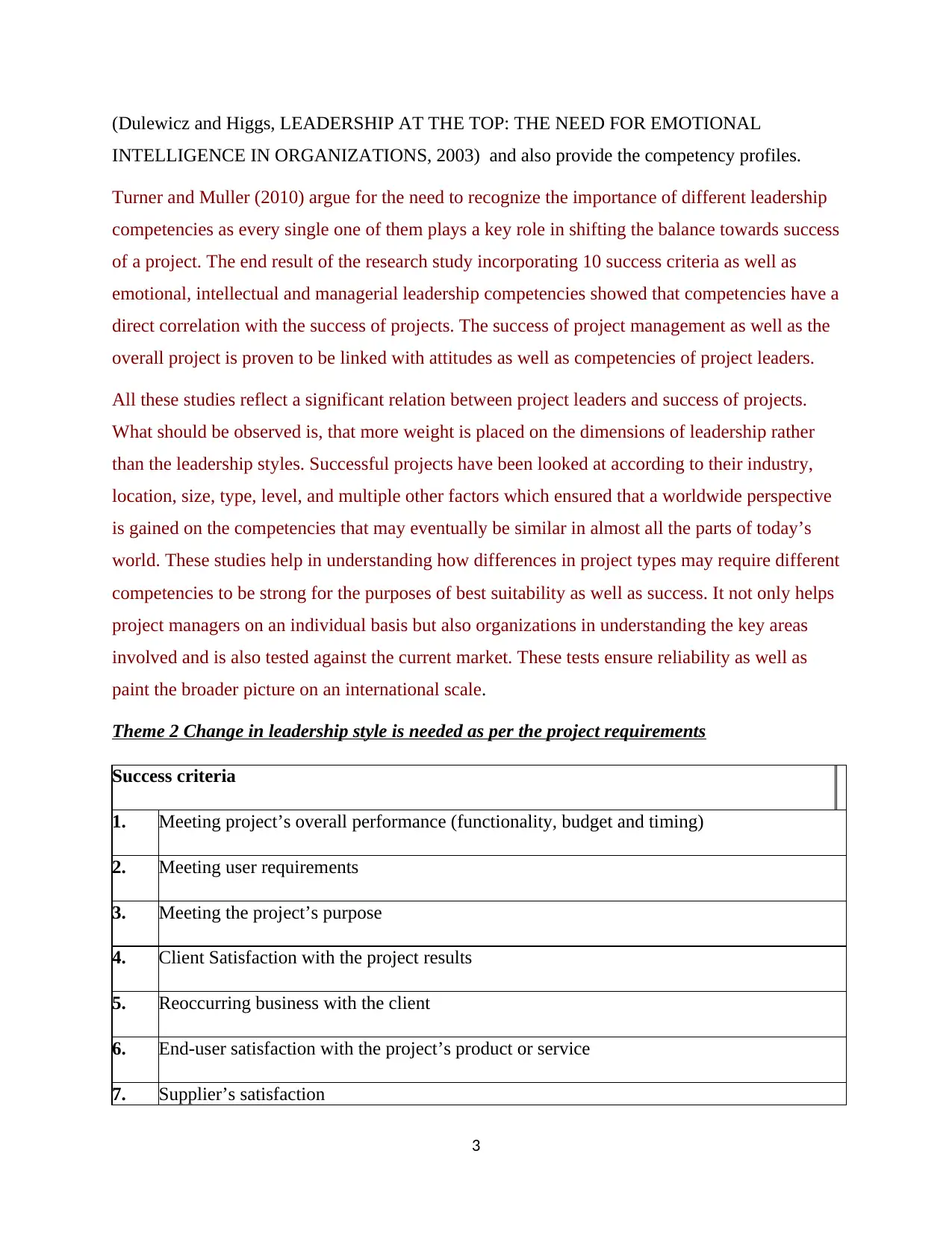
(Dulewicz and Higgs, LEADERSHIP AT THE TOP: THE NEED FOR EMOTIONAL
INTELLIGENCE IN ORGANIZATIONS, 2003) and also provide the competency profiles.
Turner and Muller (2010) argue for the need to recognize the importance of different leadership
competencies as every single one of them plays a key role in shifting the balance towards success
of a project. The end result of the research study incorporating 10 success criteria as well as
emotional, intellectual and managerial leadership competencies showed that competencies have a
direct correlation with the success of projects. The success of project management as well as the
overall project is proven to be linked with attitudes as well as competencies of project leaders.
All these studies reflect a significant relation between project leaders and success of projects.
What should be observed is, that more weight is placed on the dimensions of leadership rather
than the leadership styles. Successful projects have been looked at according to their industry,
location, size, type, level, and multiple other factors which ensured that a worldwide perspective
is gained on the competencies that may eventually be similar in almost all the parts of today’s
world. These studies help in understanding how differences in project types may require different
competencies to be strong for the purposes of best suitability as well as success. It not only helps
project managers on an individual basis but also organizations in understanding the key areas
involved and is also tested against the current market. These tests ensure reliability as well as
paint the broader picture on an international scale.
Theme 2 Change in leadership style is needed as per the project requirements
Success criteria
1. Meeting project’s overall performance (functionality, budget and timing)
2. Meeting user requirements
3. Meeting the project’s purpose
4. Client Satisfaction with the project results
5. Reoccurring business with the client
6. End-user satisfaction with the project’s product or service
7. Supplier’s satisfaction
3
INTELLIGENCE IN ORGANIZATIONS, 2003) and also provide the competency profiles.
Turner and Muller (2010) argue for the need to recognize the importance of different leadership
competencies as every single one of them plays a key role in shifting the balance towards success
of a project. The end result of the research study incorporating 10 success criteria as well as
emotional, intellectual and managerial leadership competencies showed that competencies have a
direct correlation with the success of projects. The success of project management as well as the
overall project is proven to be linked with attitudes as well as competencies of project leaders.
All these studies reflect a significant relation between project leaders and success of projects.
What should be observed is, that more weight is placed on the dimensions of leadership rather
than the leadership styles. Successful projects have been looked at according to their industry,
location, size, type, level, and multiple other factors which ensured that a worldwide perspective
is gained on the competencies that may eventually be similar in almost all the parts of today’s
world. These studies help in understanding how differences in project types may require different
competencies to be strong for the purposes of best suitability as well as success. It not only helps
project managers on an individual basis but also organizations in understanding the key areas
involved and is also tested against the current market. These tests ensure reliability as well as
paint the broader picture on an international scale.
Theme 2 Change in leadership style is needed as per the project requirements
Success criteria
1. Meeting project’s overall performance (functionality, budget and timing)
2. Meeting user requirements
3. Meeting the project’s purpose
4. Client Satisfaction with the project results
5. Reoccurring business with the client
6. End-user satisfaction with the project’s product or service
7. Supplier’s satisfaction
3
Secure Best Marks with AI Grader
Need help grading? Try our AI Grader for instant feedback on your assignments.
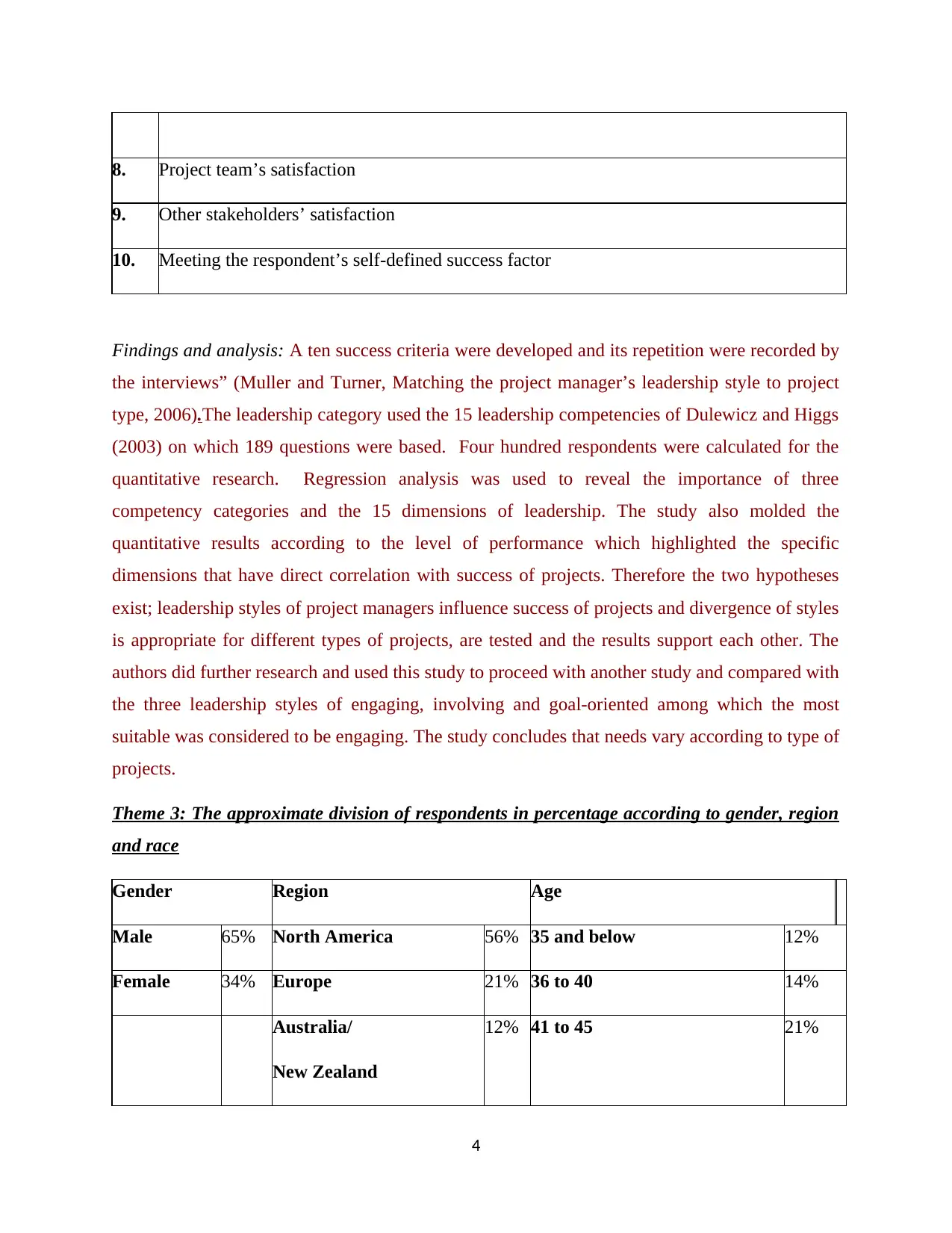
8. Project team’s satisfaction
9. Other stakeholders’ satisfaction
10. Meeting the respondent’s self-defined success factor
Findings and analysis: A ten success criteria were developed and its repetition were recorded by
the interviews” (Muller and Turner, Matching the project manager’s leadership style to project
type, 2006).The leadership category used the 15 leadership competencies of Dulewicz and Higgs
(2003) on which 189 questions were based. Four hundred respondents were calculated for the
quantitative research. Regression analysis was used to reveal the importance of three
competency categories and the 15 dimensions of leadership. The study also molded the
quantitative results according to the level of performance which highlighted the specific
dimensions that have direct correlation with success of projects. Therefore the two hypotheses
exist; leadership styles of project managers influence success of projects and divergence of styles
is appropriate for different types of projects, are tested and the results support each other. The
authors did further research and used this study to proceed with another study and compared with
the three leadership styles of engaging, involving and goal-oriented among which the most
suitable was considered to be engaging. The study concludes that needs vary according to type of
projects.
Theme 3: The approximate division of respondents in percentage according to gender, region
and race
Gender Region Age
Male 65% North America 56% 35 and below 12%
Female 34% Europe 21% 36 to 40 14%
Australia/
New Zealand
12% 41 to 45 21%
4
9. Other stakeholders’ satisfaction
10. Meeting the respondent’s self-defined success factor
Findings and analysis: A ten success criteria were developed and its repetition were recorded by
the interviews” (Muller and Turner, Matching the project manager’s leadership style to project
type, 2006).The leadership category used the 15 leadership competencies of Dulewicz and Higgs
(2003) on which 189 questions were based. Four hundred respondents were calculated for the
quantitative research. Regression analysis was used to reveal the importance of three
competency categories and the 15 dimensions of leadership. The study also molded the
quantitative results according to the level of performance which highlighted the specific
dimensions that have direct correlation with success of projects. Therefore the two hypotheses
exist; leadership styles of project managers influence success of projects and divergence of styles
is appropriate for different types of projects, are tested and the results support each other. The
authors did further research and used this study to proceed with another study and compared with
the three leadership styles of engaging, involving and goal-oriented among which the most
suitable was considered to be engaging. The study concludes that needs vary according to type of
projects.
Theme 3: The approximate division of respondents in percentage according to gender, region
and race
Gender Region Age
Male 65% North America 56% 35 and below 12%
Female 34% Europe 21% 36 to 40 14%
Australia/
New Zealand
12% 41 to 45 21%
4
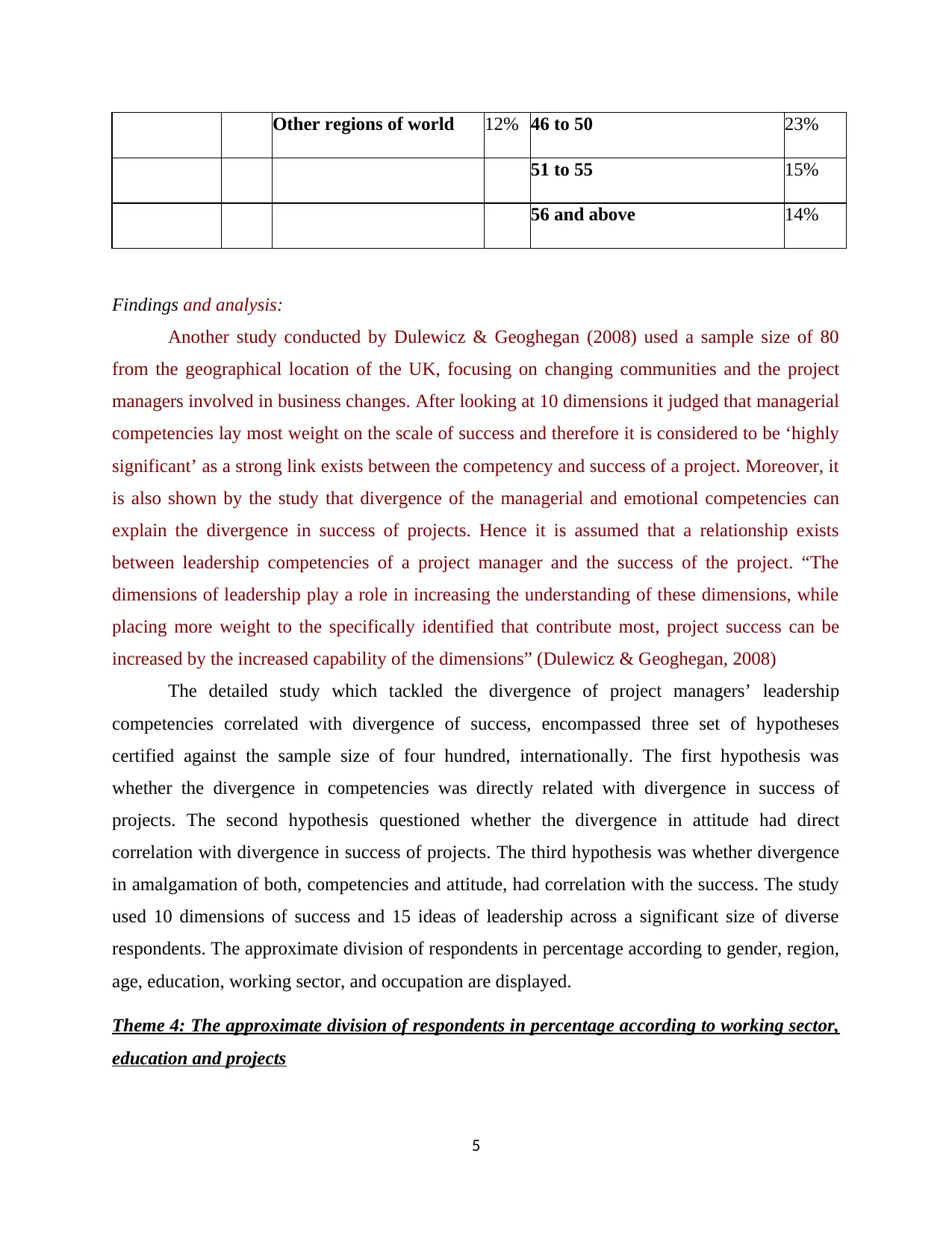
Other regions of world 12% 46 to 50 23%
51 to 55 15%
56 and above 14%
Findings and analysis:
Another study conducted by Dulewicz & Geoghegan (2008) used a sample size of 80
from the geographical location of the UK, focusing on changing communities and the project
managers involved in business changes. After looking at 10 dimensions it judged that managerial
competencies lay most weight on the scale of success and therefore it is considered to be ‘highly
significant’ as a strong link exists between the competency and success of a project. Moreover, it
is also shown by the study that divergence of the managerial and emotional competencies can
explain the divergence in success of projects. Hence it is assumed that a relationship exists
between leadership competencies of a project manager and the success of the project. “The
dimensions of leadership play a role in increasing the understanding of these dimensions, while
placing more weight to the specifically identified that contribute most, project success can be
increased by the increased capability of the dimensions” (Dulewicz & Geoghegan, 2008)
The detailed study which tackled the divergence of project managers’ leadership
competencies correlated with divergence of success, encompassed three set of hypotheses
certified against the sample size of four hundred, internationally. The first hypothesis was
whether the divergence in competencies was directly related with divergence in success of
projects. The second hypothesis questioned whether the divergence in attitude had direct
correlation with divergence in success of projects. The third hypothesis was whether divergence
in amalgamation of both, competencies and attitude, had correlation with the success. The study
used 10 dimensions of success and 15 ideas of leadership across a significant size of diverse
respondents. The approximate division of respondents in percentage according to gender, region,
age, education, working sector, and occupation are displayed.
Theme 4: The approximate division of respondents in percentage according to working sector,
education and projects
5
51 to 55 15%
56 and above 14%
Findings and analysis:
Another study conducted by Dulewicz & Geoghegan (2008) used a sample size of 80
from the geographical location of the UK, focusing on changing communities and the project
managers involved in business changes. After looking at 10 dimensions it judged that managerial
competencies lay most weight on the scale of success and therefore it is considered to be ‘highly
significant’ as a strong link exists between the competency and success of a project. Moreover, it
is also shown by the study that divergence of the managerial and emotional competencies can
explain the divergence in success of projects. Hence it is assumed that a relationship exists
between leadership competencies of a project manager and the success of the project. “The
dimensions of leadership play a role in increasing the understanding of these dimensions, while
placing more weight to the specifically identified that contribute most, project success can be
increased by the increased capability of the dimensions” (Dulewicz & Geoghegan, 2008)
The detailed study which tackled the divergence of project managers’ leadership
competencies correlated with divergence of success, encompassed three set of hypotheses
certified against the sample size of four hundred, internationally. The first hypothesis was
whether the divergence in competencies was directly related with divergence in success of
projects. The second hypothesis questioned whether the divergence in attitude had direct
correlation with divergence in success of projects. The third hypothesis was whether divergence
in amalgamation of both, competencies and attitude, had correlation with the success. The study
used 10 dimensions of success and 15 ideas of leadership across a significant size of diverse
respondents. The approximate division of respondents in percentage according to gender, region,
age, education, working sector, and occupation are displayed.
Theme 4: The approximate division of respondents in percentage according to working sector,
education and projects
5

Working Sector Education Occupation
Private 67% Professional
Qualification
38% Technical 43%
Public 28% Higher Degree 32% General Management 18%
Non-profit 5% First Degree 24% Research and
Development
6%
Different education 16% Marketing, HR and
Finance
5%
Manufacturing 5%
Other 21%
The other research was completed in 2010 by Muller and Turner. Analysis was
categorized into four parts according to project application area, complexity, importance and
contracts respectively due to specific focus. In engineering industries, the competencies of
critical thinking, developing, influence, motivation and conscientiousness were highly popular.
Under IT and similar industries all competencies were seen to be formidable except for vision
being on a medium level. Under change projects except for developing, achieving and
intuitiveness all others were observed to be strong. The analysis that targeted profiles by
complexity had a comparatively low sample size but the results nevertheless concluded that
medium complexity successful projects involved strong competencies in critical thinking,
managing resources, empowering, developing, self-awareness, sensitivity, influence and
conscientiousness. The results of profiles by importance were further categorized into
mandatory, renewal type and repositioning types. In the introductory, critical thinking, managing
resources, empowering, developing, sensitivity, influence, motivation and conscientiousness
were found to be strong (Muller and Turner, Attitudes and leadership competences for project
success, 2010). In the second category other than vision and intuition, all other competencies
were high and in the last category all other competencies were high other than vision, strategic
perspective, achieving and self-awareness.
6
Private 67% Professional
Qualification
38% Technical 43%
Public 28% Higher Degree 32% General Management 18%
Non-profit 5% First Degree 24% Research and
Development
6%
Different education 16% Marketing, HR and
Finance
5%
Manufacturing 5%
Other 21%
The other research was completed in 2010 by Muller and Turner. Analysis was
categorized into four parts according to project application area, complexity, importance and
contracts respectively due to specific focus. In engineering industries, the competencies of
critical thinking, developing, influence, motivation and conscientiousness were highly popular.
Under IT and similar industries all competencies were seen to be formidable except for vision
being on a medium level. Under change projects except for developing, achieving and
intuitiveness all others were observed to be strong. The analysis that targeted profiles by
complexity had a comparatively low sample size but the results nevertheless concluded that
medium complexity successful projects involved strong competencies in critical thinking,
managing resources, empowering, developing, self-awareness, sensitivity, influence and
conscientiousness. The results of profiles by importance were further categorized into
mandatory, renewal type and repositioning types. In the introductory, critical thinking, managing
resources, empowering, developing, sensitivity, influence, motivation and conscientiousness
were found to be strong (Muller and Turner, Attitudes and leadership competences for project
success, 2010). In the second category other than vision and intuition, all other competencies
were high and in the last category all other competencies were high other than vision, strategic
perspective, achieving and self-awareness.
6
Paraphrase This Document
Need a fresh take? Get an instant paraphrase of this document with our AI Paraphraser
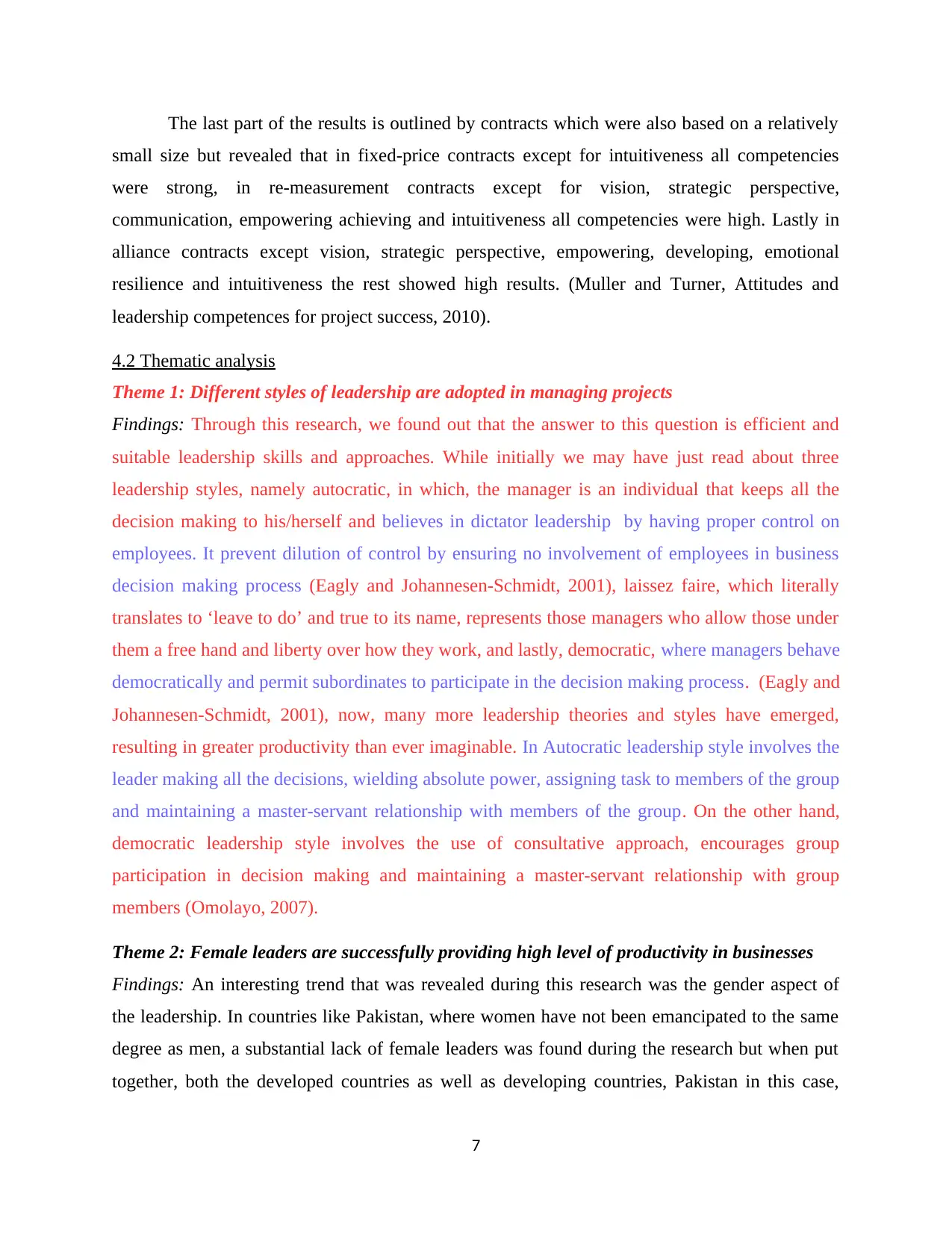
The last part of the results is outlined by contracts which were also based on a relatively
small size but revealed that in fixed-price contracts except for intuitiveness all competencies
were strong, in re-measurement contracts except for vision, strategic perspective,
communication, empowering achieving and intuitiveness all competencies were high. Lastly in
alliance contracts except vision, strategic perspective, empowering, developing, emotional
resilience and intuitiveness the rest showed high results. (Muller and Turner, Attitudes and
leadership competences for project success, 2010).
4.2 Thematic analysis
Theme 1: Different styles of leadership are adopted in managing projects
Findings: Through this research, we found out that the answer to this question is efficient and
suitable leadership skills and approaches. While initially we may have just read about three
leadership styles, namely autocratic, in which, the manager is an individual that keeps all the
decision making to his/herself and believes in dictator leadership by having proper control on
employees. It prevent dilution of control by ensuring no involvement of employees in business
decision making process (Eagly and Johannesen-Schmidt, 2001), laissez faire, which literally
translates to ‘leave to do’ and true to its name, represents those managers who allow those under
them a free hand and liberty over how they work, and lastly, democratic, where managers behave
democratically and permit subordinates to participate in the decision making process. (Eagly and
Johannesen-Schmidt, 2001), now, many more leadership theories and styles have emerged,
resulting in greater productivity than ever imaginable. In Autocratic leadership style involves the
leader making all the decisions, wielding absolute power, assigning task to members of the group
and maintaining a master-servant relationship with members of the group. On the other hand,
democratic leadership style involves the use of consultative approach, encourages group
participation in decision making and maintaining a master-servant relationship with group
members (Omolayo, 2007).
Theme 2: Female leaders are successfully providing high level of productivity in businesses
Findings: An interesting trend that was revealed during this research was the gender aspect of
the leadership. In countries like Pakistan, where women have not been emancipated to the same
degree as men, a substantial lack of female leaders was found during the research but when put
together, both the developed countries as well as developing countries, Pakistan in this case,
7
small size but revealed that in fixed-price contracts except for intuitiveness all competencies
were strong, in re-measurement contracts except for vision, strategic perspective,
communication, empowering achieving and intuitiveness all competencies were high. Lastly in
alliance contracts except vision, strategic perspective, empowering, developing, emotional
resilience and intuitiveness the rest showed high results. (Muller and Turner, Attitudes and
leadership competences for project success, 2010).
4.2 Thematic analysis
Theme 1: Different styles of leadership are adopted in managing projects
Findings: Through this research, we found out that the answer to this question is efficient and
suitable leadership skills and approaches. While initially we may have just read about three
leadership styles, namely autocratic, in which, the manager is an individual that keeps all the
decision making to his/herself and believes in dictator leadership by having proper control on
employees. It prevent dilution of control by ensuring no involvement of employees in business
decision making process (Eagly and Johannesen-Schmidt, 2001), laissez faire, which literally
translates to ‘leave to do’ and true to its name, represents those managers who allow those under
them a free hand and liberty over how they work, and lastly, democratic, where managers behave
democratically and permit subordinates to participate in the decision making process. (Eagly and
Johannesen-Schmidt, 2001), now, many more leadership theories and styles have emerged,
resulting in greater productivity than ever imaginable. In Autocratic leadership style involves the
leader making all the decisions, wielding absolute power, assigning task to members of the group
and maintaining a master-servant relationship with members of the group. On the other hand,
democratic leadership style involves the use of consultative approach, encourages group
participation in decision making and maintaining a master-servant relationship with group
members (Omolayo, 2007).
Theme 2: Female leaders are successfully providing high level of productivity in businesses
Findings: An interesting trend that was revealed during this research was the gender aspect of
the leadership. In countries like Pakistan, where women have not been emancipated to the same
degree as men, a substantial lack of female leaders was found during the research but when put
together, both the developed countries as well as developing countries, Pakistan in this case,
7
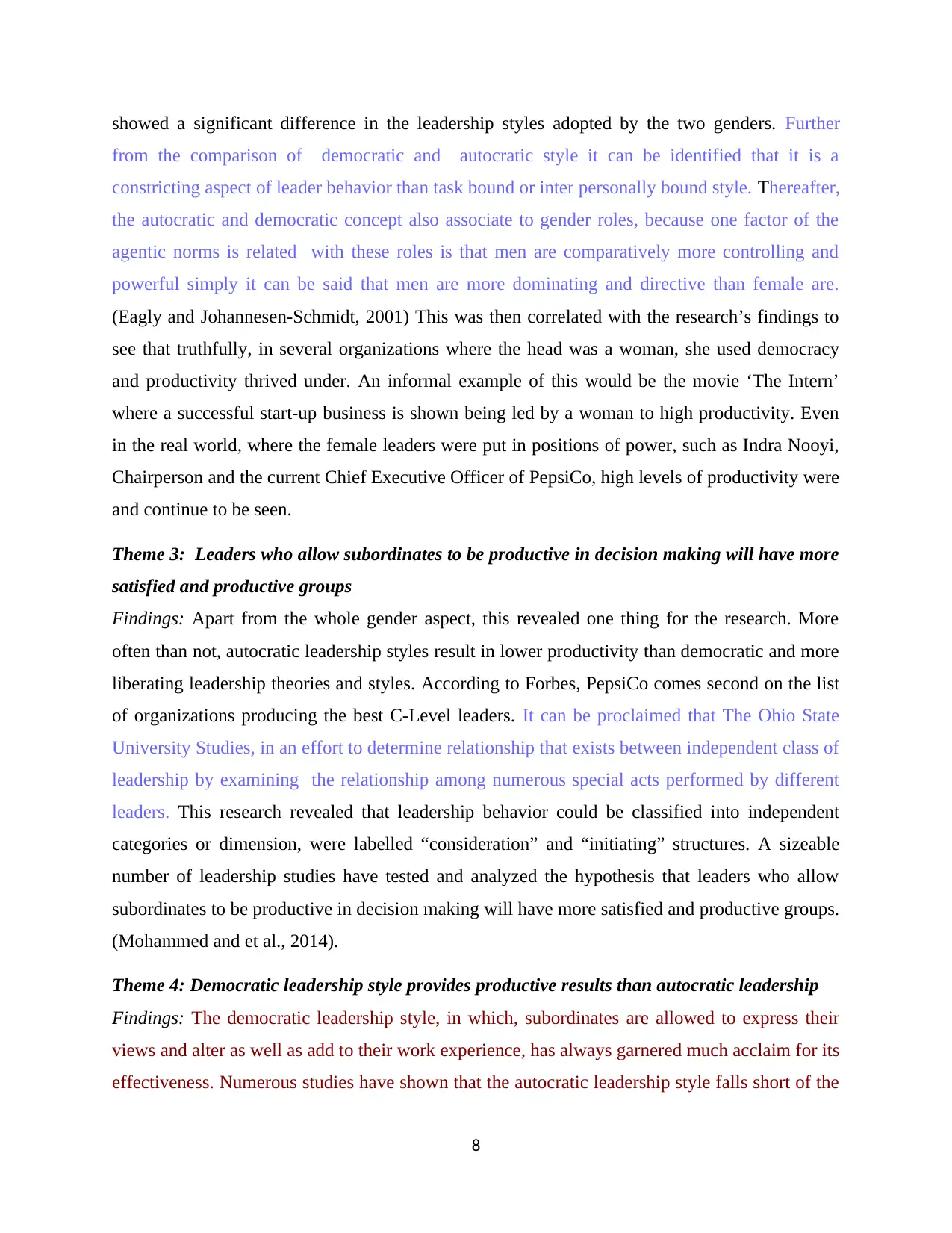
showed a significant difference in the leadership styles adopted by the two genders. Further
from the comparison of democratic and autocratic style it can be identified that it is a
constricting aspect of leader behavior than task bound or inter personally bound style. Thereafter,
the autocratic and democratic concept also associate to gender roles, because one factor of the
agentic norms is related with these roles is that men are comparatively more controlling and
powerful simply it can be said that men are more dominating and directive than female are.
(Eagly and Johannesen-Schmidt, 2001) This was then correlated with the research’s findings to
see that truthfully, in several organizations where the head was a woman, she used democracy
and productivity thrived under. An informal example of this would be the movie ‘The Intern’
where a successful start-up business is shown being led by a woman to high productivity. Even
in the real world, where the female leaders were put in positions of power, such as Indra Nooyi,
Chairperson and the current Chief Executive Officer of PepsiCo, high levels of productivity were
and continue to be seen.
Theme 3: Leaders who allow subordinates to be productive in decision making will have more
satisfied and productive groups
Findings: Apart from the whole gender aspect, this revealed one thing for the research. More
often than not, autocratic leadership styles result in lower productivity than democratic and more
liberating leadership theories and styles. According to Forbes, PepsiCo comes second on the list
of organizations producing the best C-Level leaders. It can be proclaimed that The Ohio State
University Studies, in an effort to determine relationship that exists between independent class of
leadership by examining the relationship among numerous special acts performed by different
leaders. This research revealed that leadership behavior could be classified into independent
categories or dimension, were labelled “consideration” and “initiating” structures. A sizeable
number of leadership studies have tested and analyzed the hypothesis that leaders who allow
subordinates to be productive in decision making will have more satisfied and productive groups.
(Mohammed and et al., 2014).
Theme 4: Democratic leadership style provides productive results than autocratic leadership
Findings: The democratic leadership style, in which, subordinates are allowed to express their
views and alter as well as add to their work experience, has always garnered much acclaim for its
effectiveness. Numerous studies have shown that the autocratic leadership style falls short of the
8
from the comparison of democratic and autocratic style it can be identified that it is a
constricting aspect of leader behavior than task bound or inter personally bound style. Thereafter,
the autocratic and democratic concept also associate to gender roles, because one factor of the
agentic norms is related with these roles is that men are comparatively more controlling and
powerful simply it can be said that men are more dominating and directive than female are.
(Eagly and Johannesen-Schmidt, 2001) This was then correlated with the research’s findings to
see that truthfully, in several organizations where the head was a woman, she used democracy
and productivity thrived under. An informal example of this would be the movie ‘The Intern’
where a successful start-up business is shown being led by a woman to high productivity. Even
in the real world, where the female leaders were put in positions of power, such as Indra Nooyi,
Chairperson and the current Chief Executive Officer of PepsiCo, high levels of productivity were
and continue to be seen.
Theme 3: Leaders who allow subordinates to be productive in decision making will have more
satisfied and productive groups
Findings: Apart from the whole gender aspect, this revealed one thing for the research. More
often than not, autocratic leadership styles result in lower productivity than democratic and more
liberating leadership theories and styles. According to Forbes, PepsiCo comes second on the list
of organizations producing the best C-Level leaders. It can be proclaimed that The Ohio State
University Studies, in an effort to determine relationship that exists between independent class of
leadership by examining the relationship among numerous special acts performed by different
leaders. This research revealed that leadership behavior could be classified into independent
categories or dimension, were labelled “consideration” and “initiating” structures. A sizeable
number of leadership studies have tested and analyzed the hypothesis that leaders who allow
subordinates to be productive in decision making will have more satisfied and productive groups.
(Mohammed and et al., 2014).
Theme 4: Democratic leadership style provides productive results than autocratic leadership
Findings: The democratic leadership style, in which, subordinates are allowed to express their
views and alter as well as add to their work experience, has always garnered much acclaim for its
effectiveness. Numerous studies have shown that the autocratic leadership style falls short of the
8
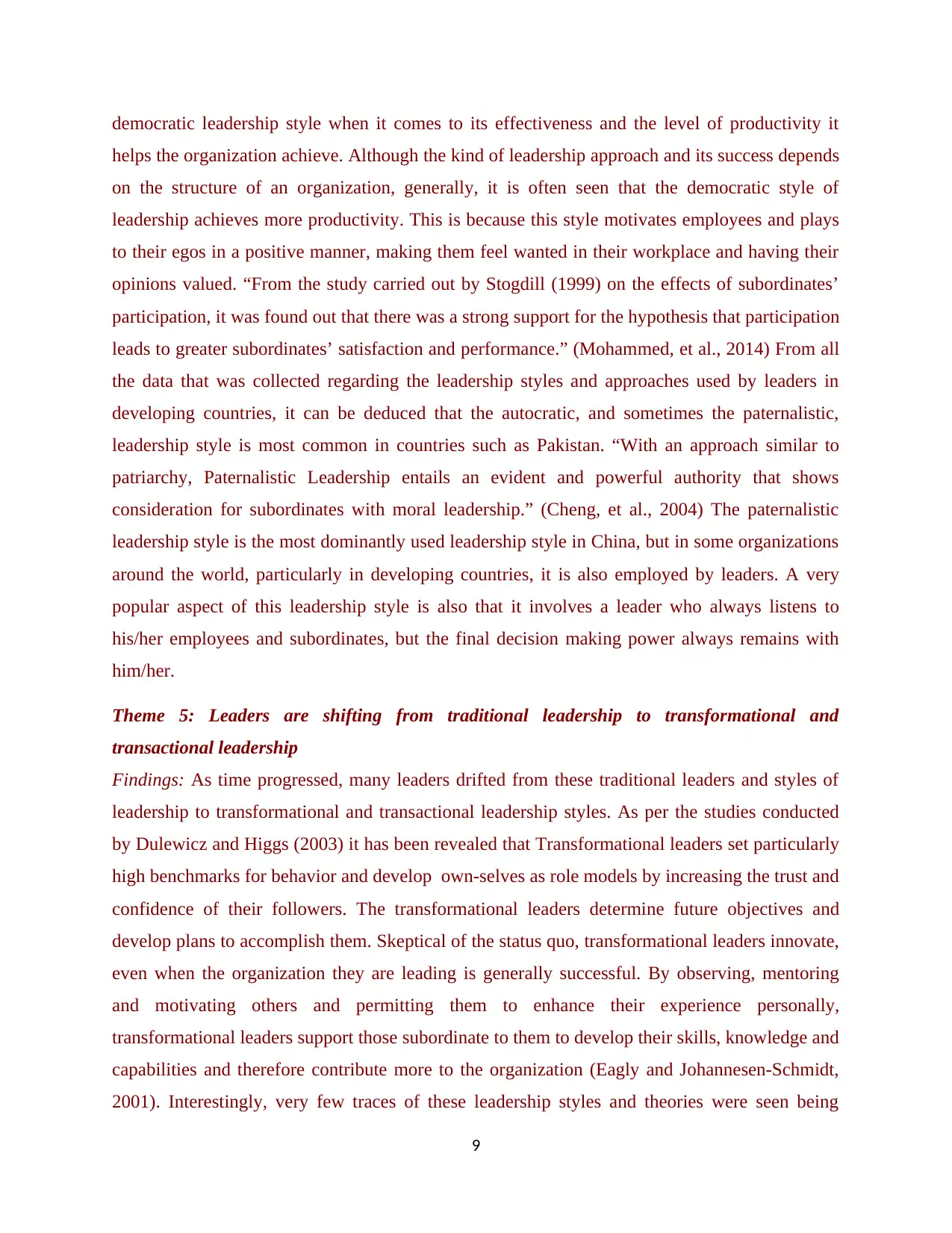
democratic leadership style when it comes to its effectiveness and the level of productivity it
helps the organization achieve. Although the kind of leadership approach and its success depends
on the structure of an organization, generally, it is often seen that the democratic style of
leadership achieves more productivity. This is because this style motivates employees and plays
to their egos in a positive manner, making them feel wanted in their workplace and having their
opinions valued. “From the study carried out by Stogdill (1999) on the effects of subordinates’
participation, it was found out that there was a strong support for the hypothesis that participation
leads to greater subordinates’ satisfaction and performance.” (Mohammed, et al., 2014) From all
the data that was collected regarding the leadership styles and approaches used by leaders in
developing countries, it can be deduced that the autocratic, and sometimes the paternalistic,
leadership style is most common in countries such as Pakistan. “With an approach similar to
patriarchy, Paternalistic Leadership entails an evident and powerful authority that shows
consideration for subordinates with moral leadership.” (Cheng, et al., 2004) The paternalistic
leadership style is the most dominantly used leadership style in China, but in some organizations
around the world, particularly in developing countries, it is also employed by leaders. A very
popular aspect of this leadership style is also that it involves a leader who always listens to
his/her employees and subordinates, but the final decision making power always remains with
him/her.
Theme 5: Leaders are shifting from traditional leadership to transformational and
transactional leadership
Findings: As time progressed, many leaders drifted from these traditional leaders and styles of
leadership to transformational and transactional leadership styles. As per the studies conducted
by Dulewicz and Higgs (2003) it has been revealed that Transformational leaders set particularly
high benchmarks for behavior and develop own-selves as role models by increasing the trust and
confidence of their followers. The transformational leaders determine future objectives and
develop plans to accomplish them. Skeptical of the status quo, transformational leaders innovate,
even when the organization they are leading is generally successful. By observing, mentoring
and motivating others and permitting them to enhance their experience personally,
transformational leaders support those subordinate to them to develop their skills, knowledge and
capabilities and therefore contribute more to the organization (Eagly and Johannesen-Schmidt,
2001). Interestingly, very few traces of these leadership styles and theories were seen being
9
helps the organization achieve. Although the kind of leadership approach and its success depends
on the structure of an organization, generally, it is often seen that the democratic style of
leadership achieves more productivity. This is because this style motivates employees and plays
to their egos in a positive manner, making them feel wanted in their workplace and having their
opinions valued. “From the study carried out by Stogdill (1999) on the effects of subordinates’
participation, it was found out that there was a strong support for the hypothesis that participation
leads to greater subordinates’ satisfaction and performance.” (Mohammed, et al., 2014) From all
the data that was collected regarding the leadership styles and approaches used by leaders in
developing countries, it can be deduced that the autocratic, and sometimes the paternalistic,
leadership style is most common in countries such as Pakistan. “With an approach similar to
patriarchy, Paternalistic Leadership entails an evident and powerful authority that shows
consideration for subordinates with moral leadership.” (Cheng, et al., 2004) The paternalistic
leadership style is the most dominantly used leadership style in China, but in some organizations
around the world, particularly in developing countries, it is also employed by leaders. A very
popular aspect of this leadership style is also that it involves a leader who always listens to
his/her employees and subordinates, but the final decision making power always remains with
him/her.
Theme 5: Leaders are shifting from traditional leadership to transformational and
transactional leadership
Findings: As time progressed, many leaders drifted from these traditional leaders and styles of
leadership to transformational and transactional leadership styles. As per the studies conducted
by Dulewicz and Higgs (2003) it has been revealed that Transformational leaders set particularly
high benchmarks for behavior and develop own-selves as role models by increasing the trust and
confidence of their followers. The transformational leaders determine future objectives and
develop plans to accomplish them. Skeptical of the status quo, transformational leaders innovate,
even when the organization they are leading is generally successful. By observing, mentoring
and motivating others and permitting them to enhance their experience personally,
transformational leaders support those subordinate to them to develop their skills, knowledge and
capabilities and therefore contribute more to the organization (Eagly and Johannesen-Schmidt,
2001). Interestingly, very few traces of these leadership styles and theories were seen being
9
Secure Best Marks with AI Grader
Need help grading? Try our AI Grader for instant feedback on your assignments.
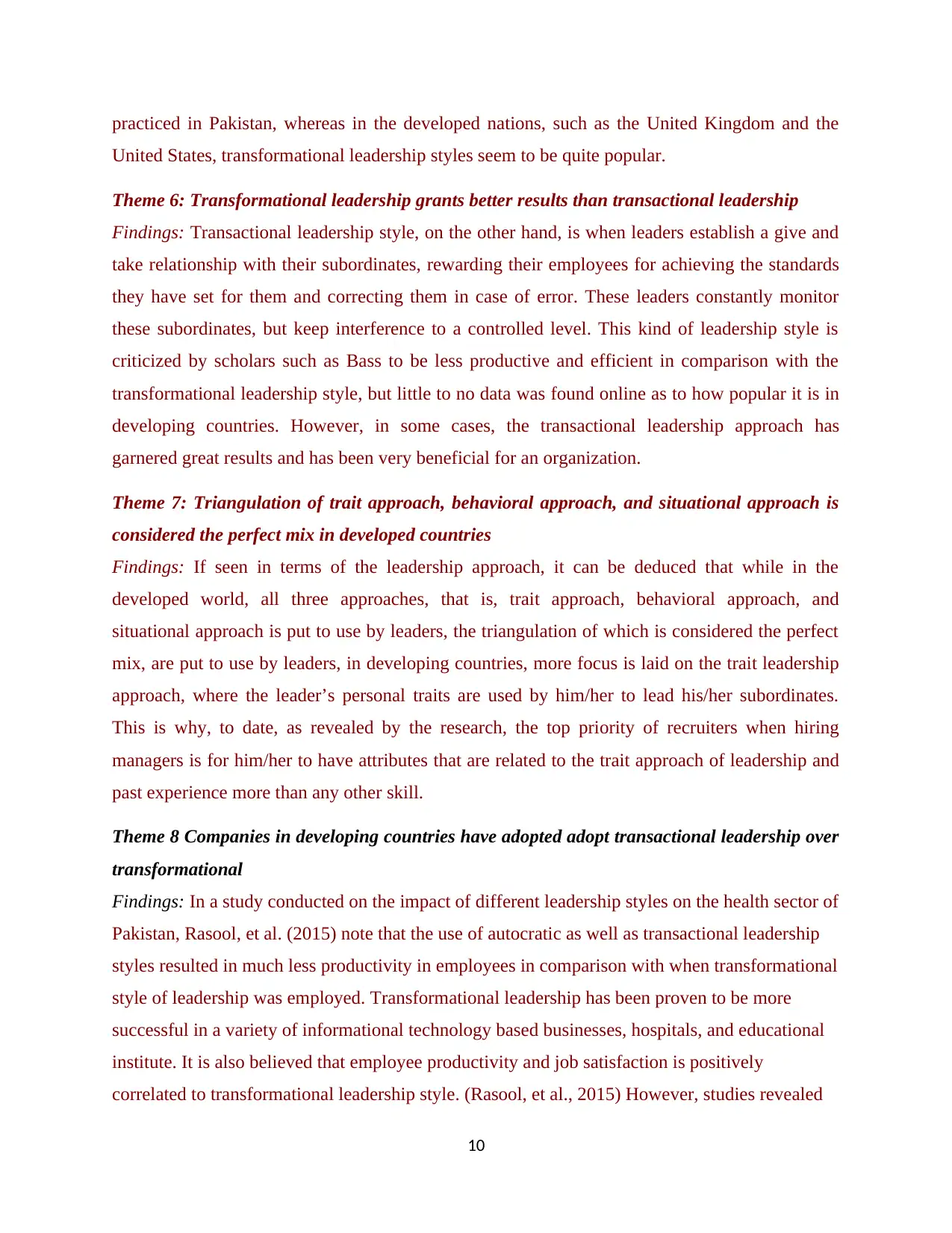
practiced in Pakistan, whereas in the developed nations, such as the United Kingdom and the
United States, transformational leadership styles seem to be quite popular.
Theme 6: Transformational leadership grants better results than transactional leadership
Findings: Transactional leadership style, on the other hand, is when leaders establish a give and
take relationship with their subordinates, rewarding their employees for achieving the standards
they have set for them and correcting them in case of error. These leaders constantly monitor
these subordinates, but keep interference to a controlled level. This kind of leadership style is
criticized by scholars such as Bass to be less productive and efficient in comparison with the
transformational leadership style, but little to no data was found online as to how popular it is in
developing countries. However, in some cases, the transactional leadership approach has
garnered great results and has been very beneficial for an organization.
Theme 7: Triangulation of trait approach, behavioral approach, and situational approach is
considered the perfect mix in developed countries
Findings: If seen in terms of the leadership approach, it can be deduced that while in the
developed world, all three approaches, that is, trait approach, behavioral approach, and
situational approach is put to use by leaders, the triangulation of which is considered the perfect
mix, are put to use by leaders, in developing countries, more focus is laid on the trait leadership
approach, where the leader’s personal traits are used by him/her to lead his/her subordinates.
This is why, to date, as revealed by the research, the top priority of recruiters when hiring
managers is for him/her to have attributes that are related to the trait approach of leadership and
past experience more than any other skill.
Theme 8 Companies in developing countries have adopted adopt transactional leadership over
transformational
Findings: In a study conducted on the impact of different leadership styles on the health sector of
Pakistan, Rasool, et al. (2015) note that the use of autocratic as well as transactional leadership
styles resulted in much less productivity in employees in comparison with when transformational
style of leadership was employed. Transformational leadership has been proven to be more
successful in a variety of informational technology based businesses, hospitals, and educational
institute. It is also believed that employee productivity and job satisfaction is positively
correlated to transformational leadership style. (Rasool, et al., 2015) However, studies revealed
10
United States, transformational leadership styles seem to be quite popular.
Theme 6: Transformational leadership grants better results than transactional leadership
Findings: Transactional leadership style, on the other hand, is when leaders establish a give and
take relationship with their subordinates, rewarding their employees for achieving the standards
they have set for them and correcting them in case of error. These leaders constantly monitor
these subordinates, but keep interference to a controlled level. This kind of leadership style is
criticized by scholars such as Bass to be less productive and efficient in comparison with the
transformational leadership style, but little to no data was found online as to how popular it is in
developing countries. However, in some cases, the transactional leadership approach has
garnered great results and has been very beneficial for an organization.
Theme 7: Triangulation of trait approach, behavioral approach, and situational approach is
considered the perfect mix in developed countries
Findings: If seen in terms of the leadership approach, it can be deduced that while in the
developed world, all three approaches, that is, trait approach, behavioral approach, and
situational approach is put to use by leaders, the triangulation of which is considered the perfect
mix, are put to use by leaders, in developing countries, more focus is laid on the trait leadership
approach, where the leader’s personal traits are used by him/her to lead his/her subordinates.
This is why, to date, as revealed by the research, the top priority of recruiters when hiring
managers is for him/her to have attributes that are related to the trait approach of leadership and
past experience more than any other skill.
Theme 8 Companies in developing countries have adopted adopt transactional leadership over
transformational
Findings: In a study conducted on the impact of different leadership styles on the health sector of
Pakistan, Rasool, et al. (2015) note that the use of autocratic as well as transactional leadership
styles resulted in much less productivity in employees in comparison with when transformational
style of leadership was employed. Transformational leadership has been proven to be more
successful in a variety of informational technology based businesses, hospitals, and educational
institute. It is also believed that employee productivity and job satisfaction is positively
correlated to transformational leadership style. (Rasool, et al., 2015) However, studies revealed
10
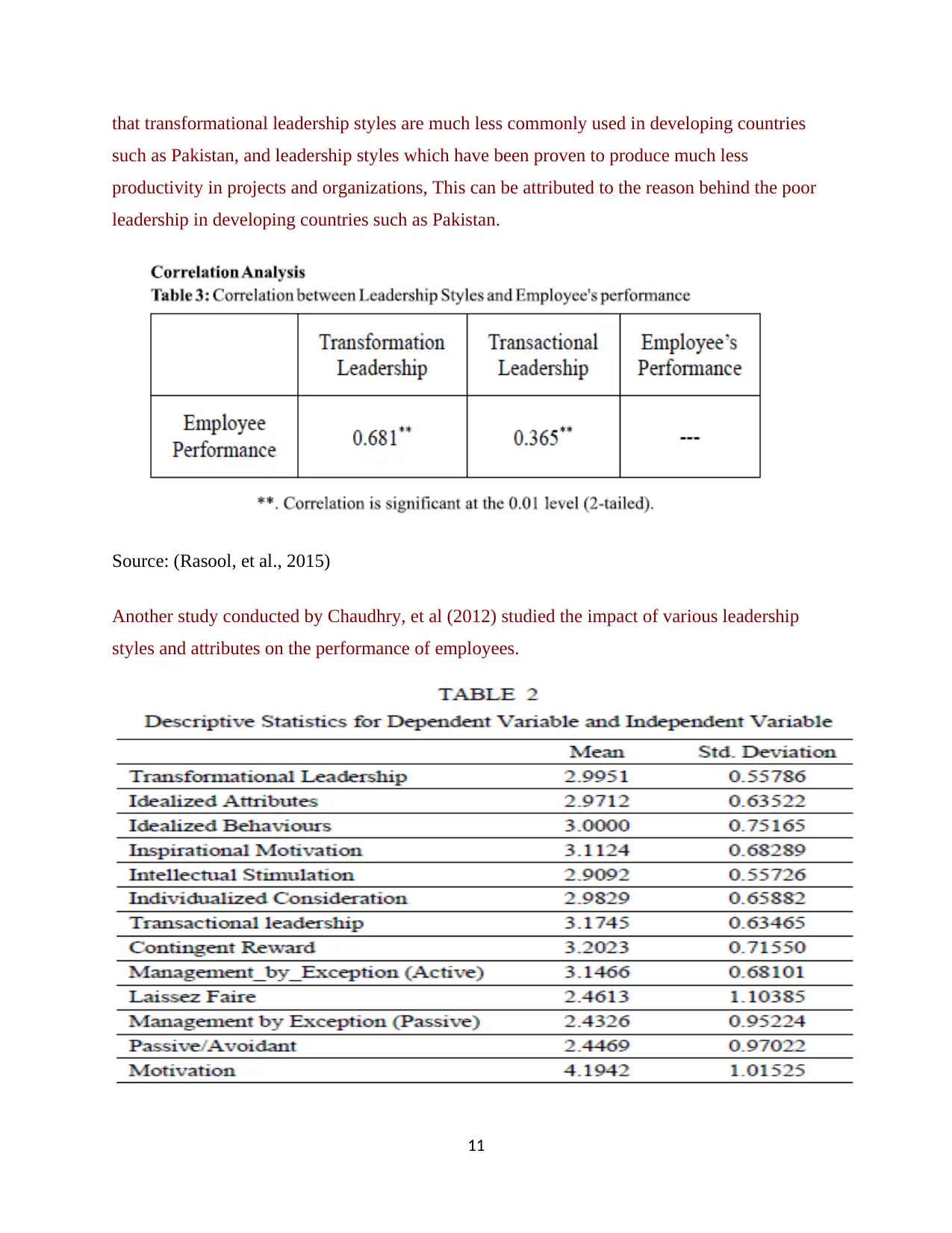
that transformational leadership styles are much less commonly used in developing countries
such as Pakistan, and leadership styles which have been proven to produce much less
productivity in projects and organizations, This can be attributed to the reason behind the poor
leadership in developing countries such as Pakistan.
Source: (Rasool, et al., 2015)
Another study conducted by Chaudhry, et al (2012) studied the impact of various leadership
styles and attributes on the performance of employees.
11
such as Pakistan, and leadership styles which have been proven to produce much less
productivity in projects and organizations, This can be attributed to the reason behind the poor
leadership in developing countries such as Pakistan.
Source: (Rasool, et al., 2015)
Another study conducted by Chaudhry, et al (2012) studied the impact of various leadership
styles and attributes on the performance of employees.
11
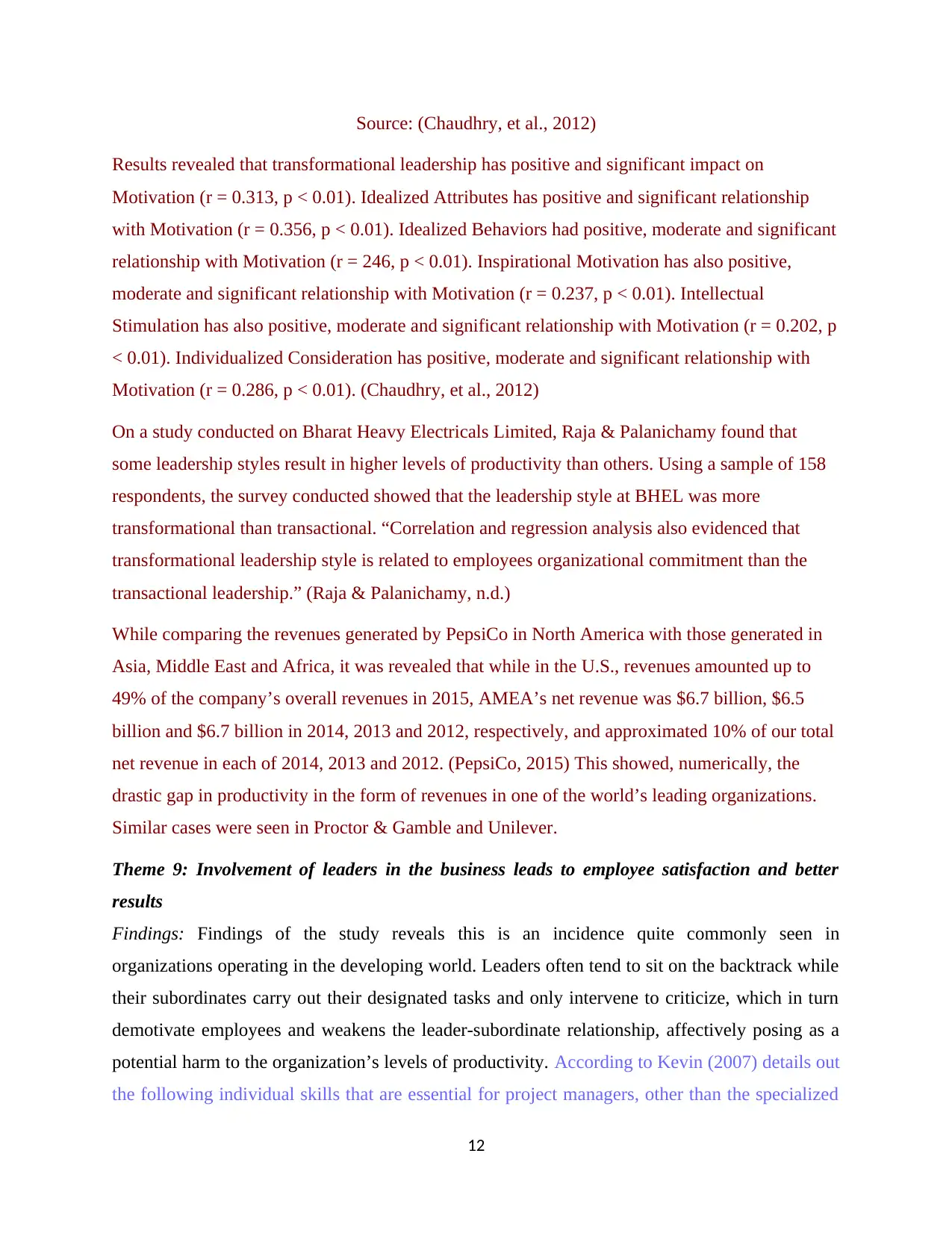
Source: (Chaudhry, et al., 2012)
Results revealed that transformational leadership has positive and significant impact on
Motivation (r = 0.313, p < 0.01). Idealized Attributes has positive and significant relationship
with Motivation (r = 0.356, p < 0.01). Idealized Behaviors had positive, moderate and significant
relationship with Motivation (r = 246, p < 0.01). Inspirational Motivation has also positive,
moderate and significant relationship with Motivation (r = 0.237, p < 0.01). Intellectual
Stimulation has also positive, moderate and significant relationship with Motivation (r = 0.202, p
< 0.01). Individualized Consideration has positive, moderate and significant relationship with
Motivation (r = 0.286, p < 0.01). (Chaudhry, et al., 2012)
On a study conducted on Bharat Heavy Electricals Limited, Raja & Palanichamy found that
some leadership styles result in higher levels of productivity than others. Using a sample of 158
respondents, the survey conducted showed that the leadership style at BHEL was more
transformational than transactional. “Correlation and regression analysis also evidenced that
transformational leadership style is related to employees organizational commitment than the
transactional leadership.” (Raja & Palanichamy, n.d.)
While comparing the revenues generated by PepsiCo in North America with those generated in
Asia, Middle East and Africa, it was revealed that while in the U.S., revenues amounted up to
49% of the company’s overall revenues in 2015, AMEA’s net revenue was $6.7 billion, $6.5
billion and $6.7 billion in 2014, 2013 and 2012, respectively, and approximated 10% of our total
net revenue in each of 2014, 2013 and 2012. (PepsiCo, 2015) This showed, numerically, the
drastic gap in productivity in the form of revenues in one of the world’s leading organizations.
Similar cases were seen in Proctor & Gamble and Unilever.
Theme 9: Involvement of leaders in the business leads to employee satisfaction and better
results
Findings: Findings of the study reveals this is an incidence quite commonly seen in
organizations operating in the developing world. Leaders often tend to sit on the backtrack while
their subordinates carry out their designated tasks and only intervene to criticize, which in turn
demotivate employees and weakens the leader-subordinate relationship, affectively posing as a
potential harm to the organization’s levels of productivity. According to Kevin (2007) details out
the following individual skills that are essential for project managers, other than the specialized
12
Results revealed that transformational leadership has positive and significant impact on
Motivation (r = 0.313, p < 0.01). Idealized Attributes has positive and significant relationship
with Motivation (r = 0.356, p < 0.01). Idealized Behaviors had positive, moderate and significant
relationship with Motivation (r = 246, p < 0.01). Inspirational Motivation has also positive,
moderate and significant relationship with Motivation (r = 0.237, p < 0.01). Intellectual
Stimulation has also positive, moderate and significant relationship with Motivation (r = 0.202, p
< 0.01). Individualized Consideration has positive, moderate and significant relationship with
Motivation (r = 0.286, p < 0.01). (Chaudhry, et al., 2012)
On a study conducted on Bharat Heavy Electricals Limited, Raja & Palanichamy found that
some leadership styles result in higher levels of productivity than others. Using a sample of 158
respondents, the survey conducted showed that the leadership style at BHEL was more
transformational than transactional. “Correlation and regression analysis also evidenced that
transformational leadership style is related to employees organizational commitment than the
transactional leadership.” (Raja & Palanichamy, n.d.)
While comparing the revenues generated by PepsiCo in North America with those generated in
Asia, Middle East and Africa, it was revealed that while in the U.S., revenues amounted up to
49% of the company’s overall revenues in 2015, AMEA’s net revenue was $6.7 billion, $6.5
billion and $6.7 billion in 2014, 2013 and 2012, respectively, and approximated 10% of our total
net revenue in each of 2014, 2013 and 2012. (PepsiCo, 2015) This showed, numerically, the
drastic gap in productivity in the form of revenues in one of the world’s leading organizations.
Similar cases were seen in Proctor & Gamble and Unilever.
Theme 9: Involvement of leaders in the business leads to employee satisfaction and better
results
Findings: Findings of the study reveals this is an incidence quite commonly seen in
organizations operating in the developing world. Leaders often tend to sit on the backtrack while
their subordinates carry out their designated tasks and only intervene to criticize, which in turn
demotivate employees and weakens the leader-subordinate relationship, affectively posing as a
potential harm to the organization’s levels of productivity. According to Kevin (2007) details out
the following individual skills that are essential for project managers, other than the specialized
12
Paraphrase This Document
Need a fresh take? Get an instant paraphrase of this document with our AI Paraphraser
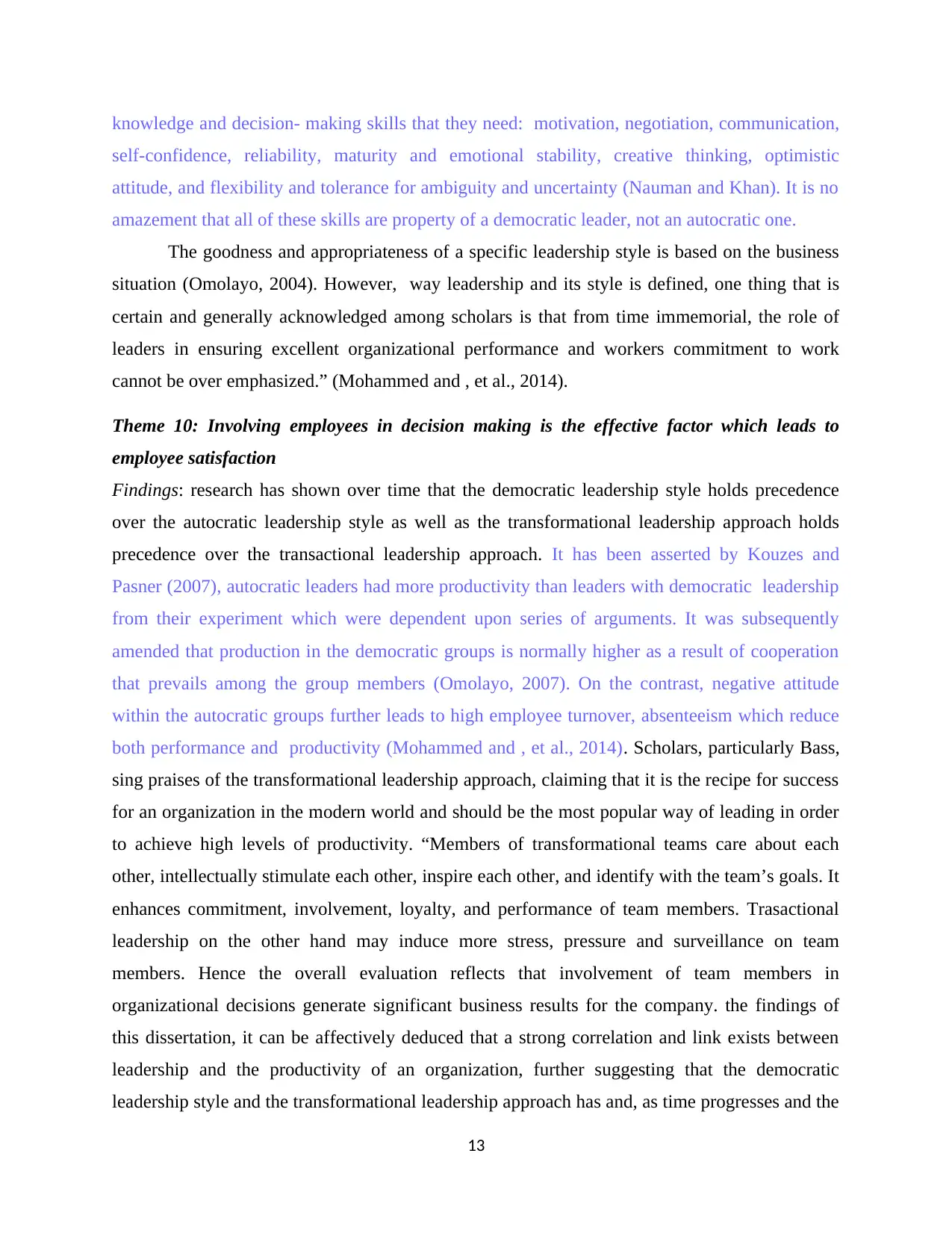
knowledge and decision- making skills that they need: motivation, negotiation, communication,
self-confidence, reliability, maturity and emotional stability, creative thinking, optimistic
attitude, and flexibility and tolerance for ambiguity and uncertainty (Nauman and Khan). It is no
amazement that all of these skills are property of a democratic leader, not an autocratic one.
The goodness and appropriateness of a specific leadership style is based on the business
situation (Omolayo, 2004). However, way leadership and its style is defined, one thing that is
certain and generally acknowledged among scholars is that from time immemorial, the role of
leaders in ensuring excellent organizational performance and workers commitment to work
cannot be over emphasized.” (Mohammed and , et al., 2014).
Theme 10: Involving employees in decision making is the effective factor which leads to
employee satisfaction
Findings: research has shown over time that the democratic leadership style holds precedence
over the autocratic leadership style as well as the transformational leadership approach holds
precedence over the transactional leadership approach. It has been asserted by Kouzes and
Pasner (2007), autocratic leaders had more productivity than leaders with democratic leadership
from their experiment which were dependent upon series of arguments. It was subsequently
amended that production in the democratic groups is normally higher as a result of cooperation
that prevails among the group members (Omolayo, 2007). On the contrast, negative attitude
within the autocratic groups further leads to high employee turnover, absenteeism which reduce
both performance and productivity (Mohammed and , et al., 2014). Scholars, particularly Bass,
sing praises of the transformational leadership approach, claiming that it is the recipe for success
for an organization in the modern world and should be the most popular way of leading in order
to achieve high levels of productivity. “Members of transformational teams care about each
other, intellectually stimulate each other, inspire each other, and identify with the team’s goals. It
enhances commitment, involvement, loyalty, and performance of team members. Trasactional
leadership on the other hand may induce more stress, pressure and surveillance on team
members. Hence the overall evaluation reflects that involvement of team members in
organizational decisions generate significant business results for the company. the findings of
this dissertation, it can be affectively deduced that a strong correlation and link exists between
leadership and the productivity of an organization, further suggesting that the democratic
leadership style and the transformational leadership approach has and, as time progresses and the
13
self-confidence, reliability, maturity and emotional stability, creative thinking, optimistic
attitude, and flexibility and tolerance for ambiguity and uncertainty (Nauman and Khan). It is no
amazement that all of these skills are property of a democratic leader, not an autocratic one.
The goodness and appropriateness of a specific leadership style is based on the business
situation (Omolayo, 2004). However, way leadership and its style is defined, one thing that is
certain and generally acknowledged among scholars is that from time immemorial, the role of
leaders in ensuring excellent organizational performance and workers commitment to work
cannot be over emphasized.” (Mohammed and , et al., 2014).
Theme 10: Involving employees in decision making is the effective factor which leads to
employee satisfaction
Findings: research has shown over time that the democratic leadership style holds precedence
over the autocratic leadership style as well as the transformational leadership approach holds
precedence over the transactional leadership approach. It has been asserted by Kouzes and
Pasner (2007), autocratic leaders had more productivity than leaders with democratic leadership
from their experiment which were dependent upon series of arguments. It was subsequently
amended that production in the democratic groups is normally higher as a result of cooperation
that prevails among the group members (Omolayo, 2007). On the contrast, negative attitude
within the autocratic groups further leads to high employee turnover, absenteeism which reduce
both performance and productivity (Mohammed and , et al., 2014). Scholars, particularly Bass,
sing praises of the transformational leadership approach, claiming that it is the recipe for success
for an organization in the modern world and should be the most popular way of leading in order
to achieve high levels of productivity. “Members of transformational teams care about each
other, intellectually stimulate each other, inspire each other, and identify with the team’s goals. It
enhances commitment, involvement, loyalty, and performance of team members. Trasactional
leadership on the other hand may induce more stress, pressure and surveillance on team
members. Hence the overall evaluation reflects that involvement of team members in
organizational decisions generate significant business results for the company. the findings of
this dissertation, it can be affectively deduced that a strong correlation and link exists between
leadership and the productivity of an organization, further suggesting that the democratic
leadership style and the transformational leadership approach has and, as time progresses and the
13
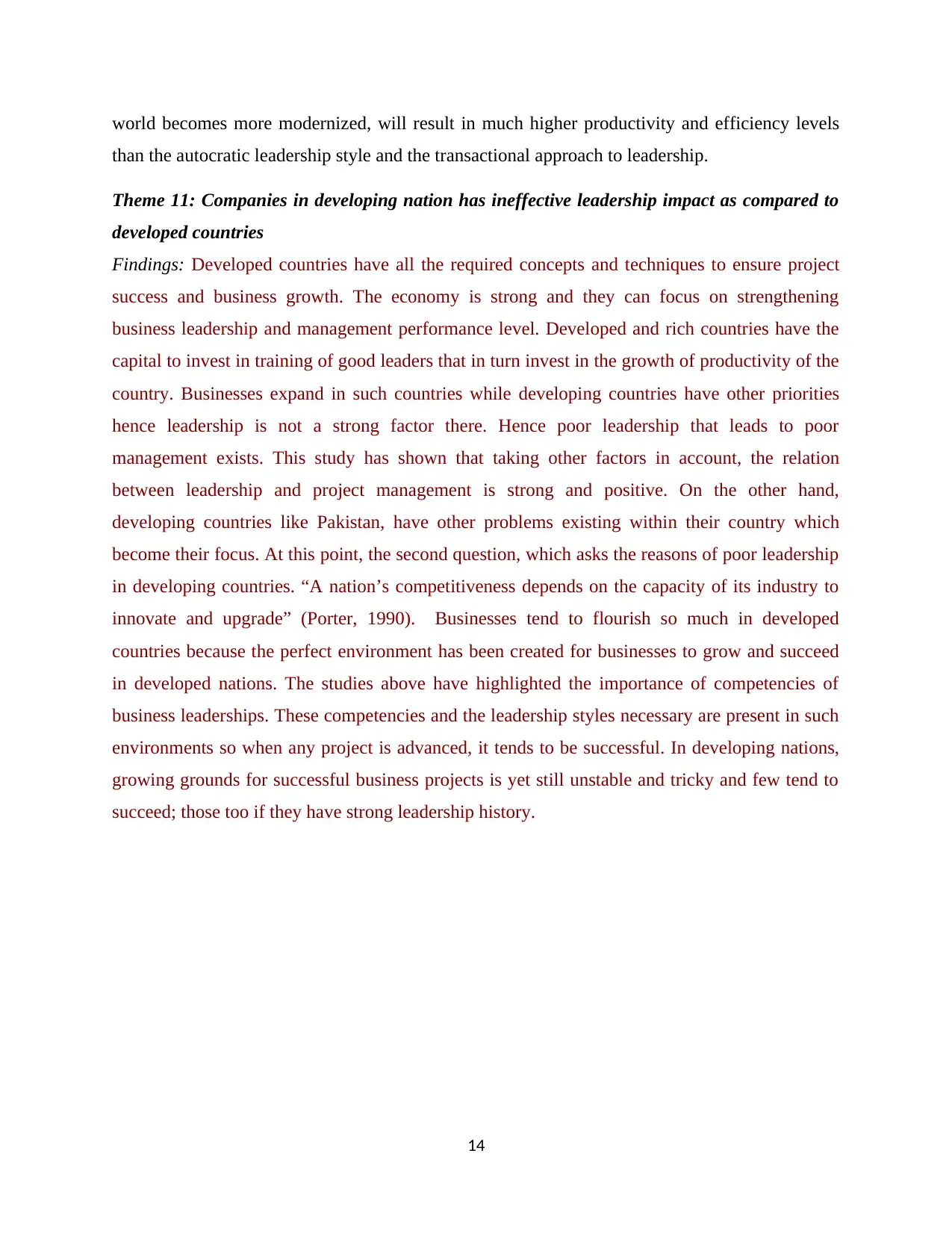
world becomes more modernized, will result in much higher productivity and efficiency levels
than the autocratic leadership style and the transactional approach to leadership.
Theme 11: Companies in developing nation has ineffective leadership impact as compared to
developed countries
Findings: Developed countries have all the required concepts and techniques to ensure project
success and business growth. The economy is strong and they can focus on strengthening
business leadership and management performance level. Developed and rich countries have the
capital to invest in training of good leaders that in turn invest in the growth of productivity of the
country. Businesses expand in such countries while developing countries have other priorities
hence leadership is not a strong factor there. Hence poor leadership that leads to poor
management exists. This study has shown that taking other factors in account, the relation
between leadership and project management is strong and positive. On the other hand,
developing countries like Pakistan, have other problems existing within their country which
become their focus. At this point, the second question, which asks the reasons of poor leadership
in developing countries. “A nation’s competitiveness depends on the capacity of its industry to
innovate and upgrade” (Porter, 1990). Businesses tend to flourish so much in developed
countries because the perfect environment has been created for businesses to grow and succeed
in developed nations. The studies above have highlighted the importance of competencies of
business leaderships. These competencies and the leadership styles necessary are present in such
environments so when any project is advanced, it tends to be successful. In developing nations,
growing grounds for successful business projects is yet still unstable and tricky and few tend to
succeed; those too if they have strong leadership history.
14
than the autocratic leadership style and the transactional approach to leadership.
Theme 11: Companies in developing nation has ineffective leadership impact as compared to
developed countries
Findings: Developed countries have all the required concepts and techniques to ensure project
success and business growth. The economy is strong and they can focus on strengthening
business leadership and management performance level. Developed and rich countries have the
capital to invest in training of good leaders that in turn invest in the growth of productivity of the
country. Businesses expand in such countries while developing countries have other priorities
hence leadership is not a strong factor there. Hence poor leadership that leads to poor
management exists. This study has shown that taking other factors in account, the relation
between leadership and project management is strong and positive. On the other hand,
developing countries like Pakistan, have other problems existing within their country which
become their focus. At this point, the second question, which asks the reasons of poor leadership
in developing countries. “A nation’s competitiveness depends on the capacity of its industry to
innovate and upgrade” (Porter, 1990). Businesses tend to flourish so much in developed
countries because the perfect environment has been created for businesses to grow and succeed
in developed nations. The studies above have highlighted the importance of competencies of
business leaderships. These competencies and the leadership styles necessary are present in such
environments so when any project is advanced, it tends to be successful. In developing nations,
growing grounds for successful business projects is yet still unstable and tricky and few tend to
succeed; those too if they have strong leadership history.
14
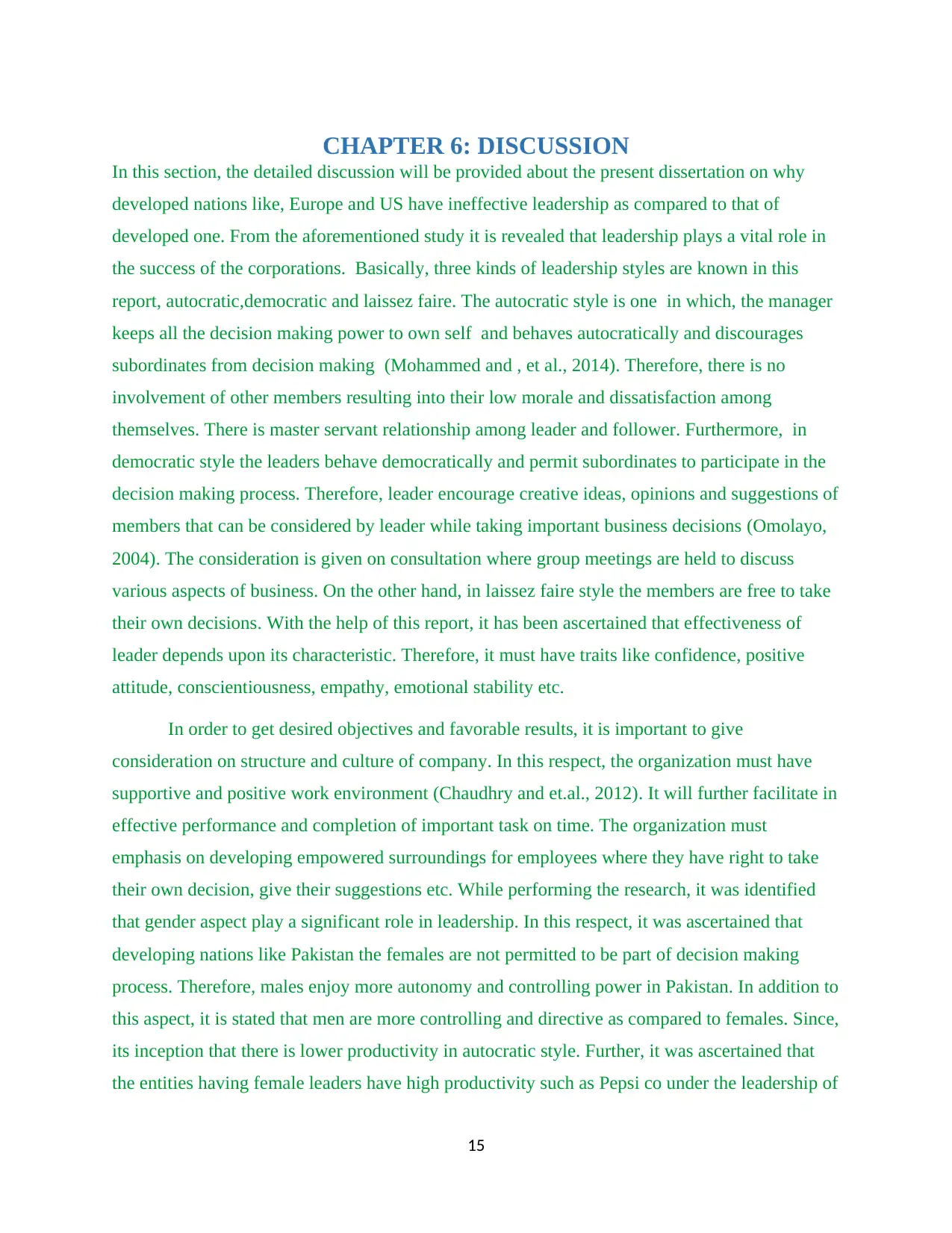
CHAPTER 6: DISCUSSION
In this section, the detailed discussion will be provided about the present dissertation on why
developed nations like, Europe and US have ineffective leadership as compared to that of
developed one. From the aforementioned study it is revealed that leadership plays a vital role in
the success of the corporations. Basically, three kinds of leadership styles are known in this
report, autocratic,democratic and laissez faire. The autocratic style is one in which, the manager
keeps all the decision making power to own self and behaves autocratically and discourages
subordinates from decision making (Mohammed and , et al., 2014). Therefore, there is no
involvement of other members resulting into their low morale and dissatisfaction among
themselves. There is master servant relationship among leader and follower. Furthermore, in
democratic style the leaders behave democratically and permit subordinates to participate in the
decision making process. Therefore, leader encourage creative ideas, opinions and suggestions of
members that can be considered by leader while taking important business decisions (Omolayo,
2004). The consideration is given on consultation where group meetings are held to discuss
various aspects of business. On the other hand, in laissez faire style the members are free to take
their own decisions. With the help of this report, it has been ascertained that effectiveness of
leader depends upon its characteristic. Therefore, it must have traits like confidence, positive
attitude, conscientiousness, empathy, emotional stability etc.
In order to get desired objectives and favorable results, it is important to give
consideration on structure and culture of company. In this respect, the organization must have
supportive and positive work environment (Chaudhry and et.al., 2012). It will further facilitate in
effective performance and completion of important task on time. The organization must
emphasis on developing empowered surroundings for employees where they have right to take
their own decision, give their suggestions etc. While performing the research, it was identified
that gender aspect play a significant role in leadership. In this respect, it was ascertained that
developing nations like Pakistan the females are not permitted to be part of decision making
process. Therefore, males enjoy more autonomy and controlling power in Pakistan. In addition to
this aspect, it is stated that men are more controlling and directive as compared to females. Since,
its inception that there is lower productivity in autocratic style. Further, it was ascertained that
the entities having female leaders have high productivity such as Pepsi co under the leadership of
15
In this section, the detailed discussion will be provided about the present dissertation on why
developed nations like, Europe and US have ineffective leadership as compared to that of
developed one. From the aforementioned study it is revealed that leadership plays a vital role in
the success of the corporations. Basically, three kinds of leadership styles are known in this
report, autocratic,democratic and laissez faire. The autocratic style is one in which, the manager
keeps all the decision making power to own self and behaves autocratically and discourages
subordinates from decision making (Mohammed and , et al., 2014). Therefore, there is no
involvement of other members resulting into their low morale and dissatisfaction among
themselves. There is master servant relationship among leader and follower. Furthermore, in
democratic style the leaders behave democratically and permit subordinates to participate in the
decision making process. Therefore, leader encourage creative ideas, opinions and suggestions of
members that can be considered by leader while taking important business decisions (Omolayo,
2004). The consideration is given on consultation where group meetings are held to discuss
various aspects of business. On the other hand, in laissez faire style the members are free to take
their own decisions. With the help of this report, it has been ascertained that effectiveness of
leader depends upon its characteristic. Therefore, it must have traits like confidence, positive
attitude, conscientiousness, empathy, emotional stability etc.
In order to get desired objectives and favorable results, it is important to give
consideration on structure and culture of company. In this respect, the organization must have
supportive and positive work environment (Chaudhry and et.al., 2012). It will further facilitate in
effective performance and completion of important task on time. The organization must
emphasis on developing empowered surroundings for employees where they have right to take
their own decision, give their suggestions etc. While performing the research, it was identified
that gender aspect play a significant role in leadership. In this respect, it was ascertained that
developing nations like Pakistan the females are not permitted to be part of decision making
process. Therefore, males enjoy more autonomy and controlling power in Pakistan. In addition to
this aspect, it is stated that men are more controlling and directive as compared to females. Since,
its inception that there is lower productivity in autocratic style. Further, it was ascertained that
the entities having female leaders have high productivity such as Pepsi co under the leadership of
15
Secure Best Marks with AI Grader
Need help grading? Try our AI Grader for instant feedback on your assignments.
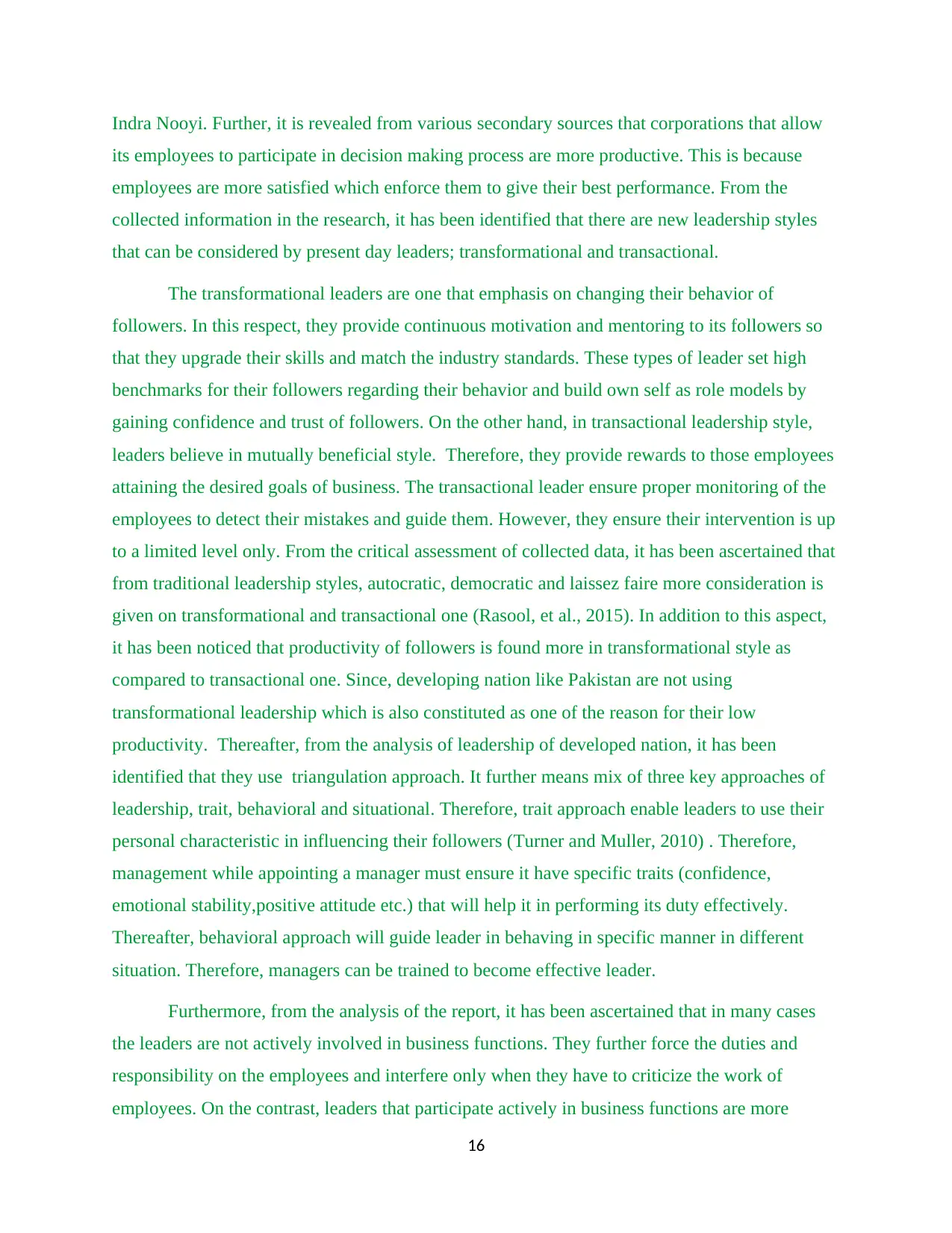
Indra Nooyi. Further, it is revealed from various secondary sources that corporations that allow
its employees to participate in decision making process are more productive. This is because
employees are more satisfied which enforce them to give their best performance. From the
collected information in the research, it has been identified that there are new leadership styles
that can be considered by present day leaders; transformational and transactional.
The transformational leaders are one that emphasis on changing their behavior of
followers. In this respect, they provide continuous motivation and mentoring to its followers so
that they upgrade their skills and match the industry standards. These types of leader set high
benchmarks for their followers regarding their behavior and build own self as role models by
gaining confidence and trust of followers. On the other hand, in transactional leadership style,
leaders believe in mutually beneficial style. Therefore, they provide rewards to those employees
attaining the desired goals of business. The transactional leader ensure proper monitoring of the
employees to detect their mistakes and guide them. However, they ensure their intervention is up
to a limited level only. From the critical assessment of collected data, it has been ascertained that
from traditional leadership styles, autocratic, democratic and laissez faire more consideration is
given on transformational and transactional one (Rasool, et al., 2015). In addition to this aspect,
it has been noticed that productivity of followers is found more in transformational style as
compared to transactional one. Since, developing nation like Pakistan are not using
transformational leadership which is also constituted as one of the reason for their low
productivity. Thereafter, from the analysis of leadership of developed nation, it has been
identified that they use triangulation approach. It further means mix of three key approaches of
leadership, trait, behavioral and situational. Therefore, trait approach enable leaders to use their
personal characteristic in influencing their followers (Turner and Muller, 2010) . Therefore,
management while appointing a manager must ensure it have specific traits (confidence,
emotional stability,positive attitude etc.) that will help it in performing its duty effectively.
Thereafter, behavioral approach will guide leader in behaving in specific manner in different
situation. Therefore, managers can be trained to become effective leader.
Furthermore, from the analysis of the report, it has been ascertained that in many cases
the leaders are not actively involved in business functions. They further force the duties and
responsibility on the employees and interfere only when they have to criticize the work of
employees. On the contrast, leaders that participate actively in business functions are more
16
its employees to participate in decision making process are more productive. This is because
employees are more satisfied which enforce them to give their best performance. From the
collected information in the research, it has been identified that there are new leadership styles
that can be considered by present day leaders; transformational and transactional.
The transformational leaders are one that emphasis on changing their behavior of
followers. In this respect, they provide continuous motivation and mentoring to its followers so
that they upgrade their skills and match the industry standards. These types of leader set high
benchmarks for their followers regarding their behavior and build own self as role models by
gaining confidence and trust of followers. On the other hand, in transactional leadership style,
leaders believe in mutually beneficial style. Therefore, they provide rewards to those employees
attaining the desired goals of business. The transactional leader ensure proper monitoring of the
employees to detect their mistakes and guide them. However, they ensure their intervention is up
to a limited level only. From the critical assessment of collected data, it has been ascertained that
from traditional leadership styles, autocratic, democratic and laissez faire more consideration is
given on transformational and transactional one (Rasool, et al., 2015). In addition to this aspect,
it has been noticed that productivity of followers is found more in transformational style as
compared to transactional one. Since, developing nation like Pakistan are not using
transformational leadership which is also constituted as one of the reason for their low
productivity. Thereafter, from the analysis of leadership of developed nation, it has been
identified that they use triangulation approach. It further means mix of three key approaches of
leadership, trait, behavioral and situational. Therefore, trait approach enable leaders to use their
personal characteristic in influencing their followers (Turner and Muller, 2010) . Therefore,
management while appointing a manager must ensure it have specific traits (confidence,
emotional stability,positive attitude etc.) that will help it in performing its duty effectively.
Thereafter, behavioral approach will guide leader in behaving in specific manner in different
situation. Therefore, managers can be trained to become effective leader.
Furthermore, from the analysis of the report, it has been ascertained that in many cases
the leaders are not actively involved in business functions. They further force the duties and
responsibility on the employees and interfere only when they have to criticize the work of
employees. On the contrast, leaders that participate actively in business functions are more
16
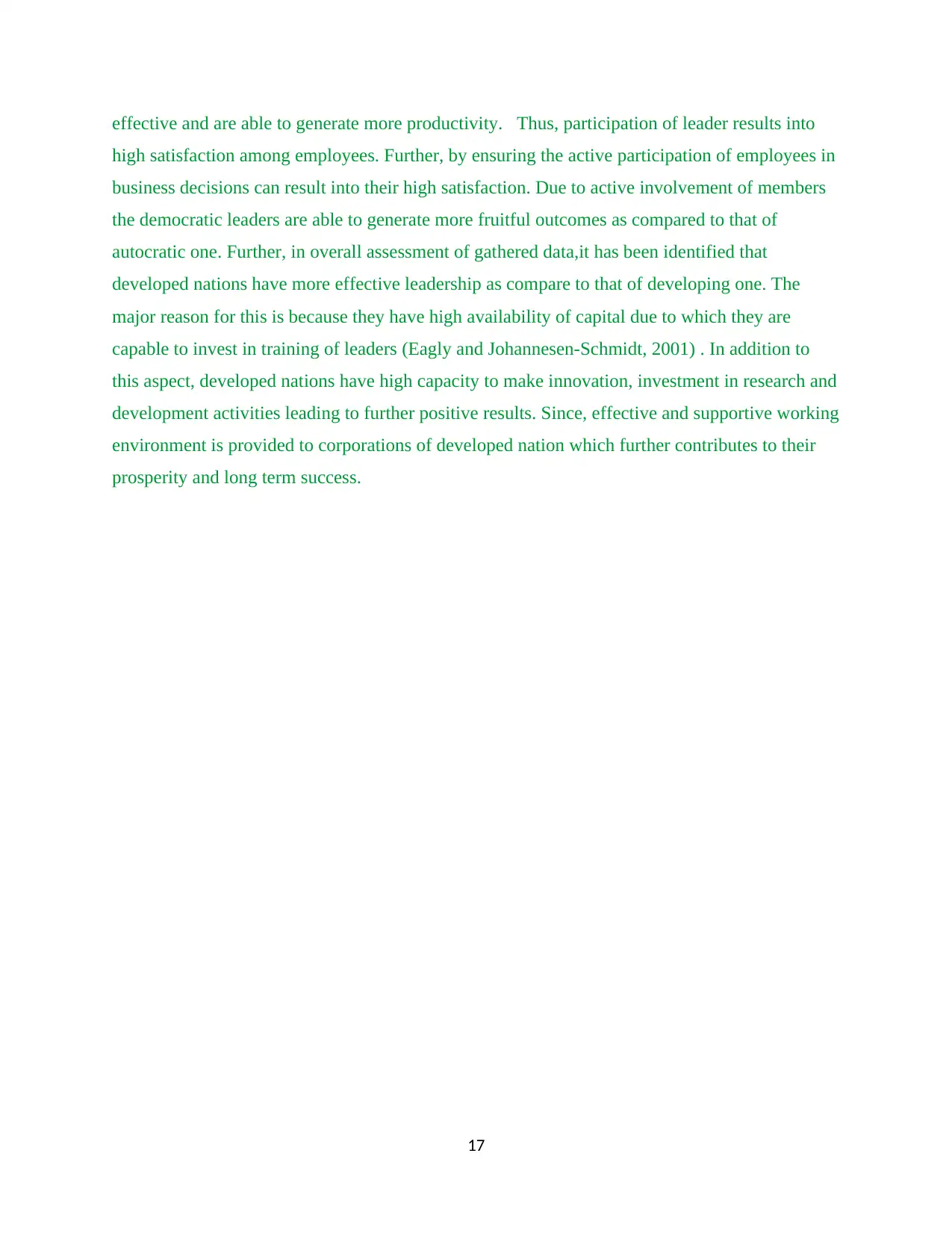
effective and are able to generate more productivity. Thus, participation of leader results into
high satisfaction among employees. Further, by ensuring the active participation of employees in
business decisions can result into their high satisfaction. Due to active involvement of members
the democratic leaders are able to generate more fruitful outcomes as compared to that of
autocratic one. Further, in overall assessment of gathered data,it has been identified that
developed nations have more effective leadership as compare to that of developing one. The
major reason for this is because they have high availability of capital due to which they are
capable to invest in training of leaders (Eagly and Johannesen-Schmidt, 2001) . In addition to
this aspect, developed nations have high capacity to make innovation, investment in research and
development activities leading to further positive results. Since, effective and supportive working
environment is provided to corporations of developed nation which further contributes to their
prosperity and long term success.
17
high satisfaction among employees. Further, by ensuring the active participation of employees in
business decisions can result into their high satisfaction. Due to active involvement of members
the democratic leaders are able to generate more fruitful outcomes as compared to that of
autocratic one. Further, in overall assessment of gathered data,it has been identified that
developed nations have more effective leadership as compare to that of developing one. The
major reason for this is because they have high availability of capital due to which they are
capable to invest in training of leaders (Eagly and Johannesen-Schmidt, 2001) . In addition to
this aspect, developed nations have high capacity to make innovation, investment in research and
development activities leading to further positive results. Since, effective and supportive working
environment is provided to corporations of developed nation which further contributes to their
prosperity and long term success.
17

CHAPTER 7: CONCLUSION AND RECOMMENDATIONS
5.1 Introduction
This chapter of the study develops a significant result for the overall analysis where the
overall findings and analysis of the research is concluded and analysed. This section will
evaluate the overall findings and conclude the objective of the study to examine the research gap.
The later section will also includes the recommendations regarding the activities that companies
must undertake to develop effective leadership measures within the economy.
5.2 Conclusion
The focus of this dissertation was to study the reason behind poor leadership and management
skills in businesses of developing countries compared to the developed countries. The articles
and journals chosen to answer the research questions showed that without strong leadership,
businesses cannot be managed in a proper way. As the various literature depicted, the workforce
and leadership styles have changed over time. The workforce does not wish to be treated in a
similar pattern anymore because of different personal skills involved. Project management has
revolutionized shifting from a traditional method to a modern one. Instead of prioritizing the
project the most and making sure that its requirements are met properly, labor has been made a
priority, mostly in the developed world, because research has indicated over the years that the
more motivated the workforce, the more productive the organization, and motivating the
workforce comes under the job description of a good leader According to Kevin (2007) a
positive relationship is seen between good leadership and a business project. Moreover, our
findings showed us numerically how there is a strong correlation between good leadership and a
business’ productivity.
To identify the leadership factors that leads to employee satisfaction
Leadership was divided into different styles and features. A study resulted in showing
how emotional intelligence is a sign of a good leadership. Emotional intelligence is when a
leader knows how to empathize with his/her subordinates and uses that skill to communicate
with them and lead them in a way that best suits them. Signs of emotional intelligence are mostly
seen in the transformational approach to leadership. If leadership is diversified, does it mean that
there will be a positive influence on projects? For different projects, different leadership styles
will be better since they would handle each one according to their needs. So the numerical
18
5.1 Introduction
This chapter of the study develops a significant result for the overall analysis where the
overall findings and analysis of the research is concluded and analysed. This section will
evaluate the overall findings and conclude the objective of the study to examine the research gap.
The later section will also includes the recommendations regarding the activities that companies
must undertake to develop effective leadership measures within the economy.
5.2 Conclusion
The focus of this dissertation was to study the reason behind poor leadership and management
skills in businesses of developing countries compared to the developed countries. The articles
and journals chosen to answer the research questions showed that without strong leadership,
businesses cannot be managed in a proper way. As the various literature depicted, the workforce
and leadership styles have changed over time. The workforce does not wish to be treated in a
similar pattern anymore because of different personal skills involved. Project management has
revolutionized shifting from a traditional method to a modern one. Instead of prioritizing the
project the most and making sure that its requirements are met properly, labor has been made a
priority, mostly in the developed world, because research has indicated over the years that the
more motivated the workforce, the more productive the organization, and motivating the
workforce comes under the job description of a good leader According to Kevin (2007) a
positive relationship is seen between good leadership and a business project. Moreover, our
findings showed us numerically how there is a strong correlation between good leadership and a
business’ productivity.
To identify the leadership factors that leads to employee satisfaction
Leadership was divided into different styles and features. A study resulted in showing
how emotional intelligence is a sign of a good leadership. Emotional intelligence is when a
leader knows how to empathize with his/her subordinates and uses that skill to communicate
with them and lead them in a way that best suits them. Signs of emotional intelligence are mostly
seen in the transformational approach to leadership. If leadership is diversified, does it mean that
there will be a positive influence on projects? For different projects, different leadership styles
will be better since they would handle each one according to their needs. So the numerical
18
Paraphrase This Document
Need a fresh take? Get an instant paraphrase of this document with our AI Paraphraser
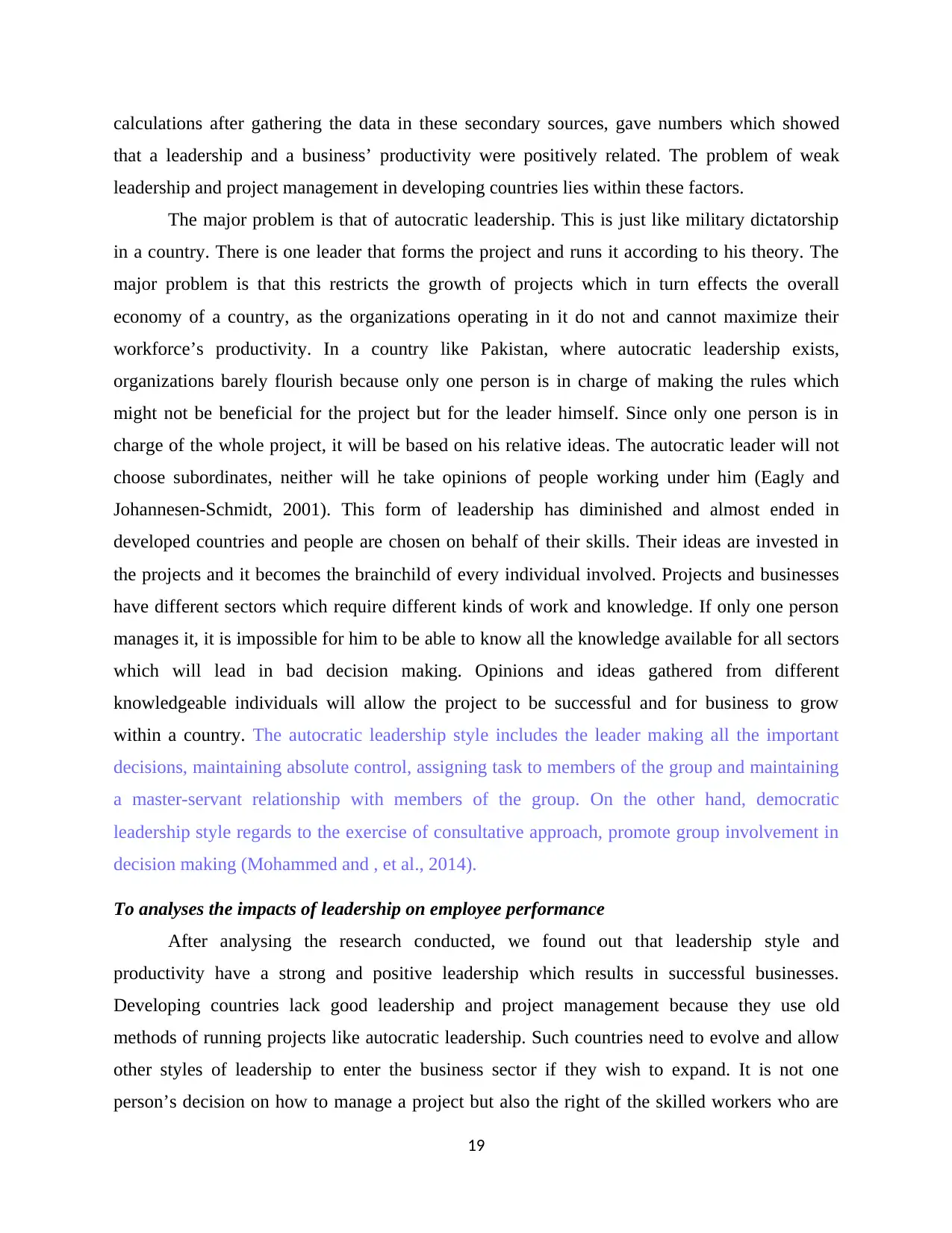
calculations after gathering the data in these secondary sources, gave numbers which showed
that a leadership and a business’ productivity were positively related. The problem of weak
leadership and project management in developing countries lies within these factors.
The major problem is that of autocratic leadership. This is just like military dictatorship
in a country. There is one leader that forms the project and runs it according to his theory. The
major problem is that this restricts the growth of projects which in turn effects the overall
economy of a country, as the organizations operating in it do not and cannot maximize their
workforce’s productivity. In a country like Pakistan, where autocratic leadership exists,
organizations barely flourish because only one person is in charge of making the rules which
might not be beneficial for the project but for the leader himself. Since only one person is in
charge of the whole project, it will be based on his relative ideas. The autocratic leader will not
choose subordinates, neither will he take opinions of people working under him (Eagly and
Johannesen-Schmidt, 2001). This form of leadership has diminished and almost ended in
developed countries and people are chosen on behalf of their skills. Their ideas are invested in
the projects and it becomes the brainchild of every individual involved. Projects and businesses
have different sectors which require different kinds of work and knowledge. If only one person
manages it, it is impossible for him to be able to know all the knowledge available for all sectors
which will lead in bad decision making. Opinions and ideas gathered from different
knowledgeable individuals will allow the project to be successful and for business to grow
within a country. The autocratic leadership style includes the leader making all the important
decisions, maintaining absolute control, assigning task to members of the group and maintaining
a master-servant relationship with members of the group. On the other hand, democratic
leadership style regards to the exercise of consultative approach, promote group involvement in
decision making (Mohammed and , et al., 2014).
To analyses the impacts of leadership on employee performance
After analysing the research conducted, we found out that leadership style and
productivity have a strong and positive leadership which results in successful businesses.
Developing countries lack good leadership and project management because they use old
methods of running projects like autocratic leadership. Such countries need to evolve and allow
other styles of leadership to enter the business sector if they wish to expand. It is not one
person’s decision on how to manage a project but also the right of the skilled workers who are
19
that a leadership and a business’ productivity were positively related. The problem of weak
leadership and project management in developing countries lies within these factors.
The major problem is that of autocratic leadership. This is just like military dictatorship
in a country. There is one leader that forms the project and runs it according to his theory. The
major problem is that this restricts the growth of projects which in turn effects the overall
economy of a country, as the organizations operating in it do not and cannot maximize their
workforce’s productivity. In a country like Pakistan, where autocratic leadership exists,
organizations barely flourish because only one person is in charge of making the rules which
might not be beneficial for the project but for the leader himself. Since only one person is in
charge of the whole project, it will be based on his relative ideas. The autocratic leader will not
choose subordinates, neither will he take opinions of people working under him (Eagly and
Johannesen-Schmidt, 2001). This form of leadership has diminished and almost ended in
developed countries and people are chosen on behalf of their skills. Their ideas are invested in
the projects and it becomes the brainchild of every individual involved. Projects and businesses
have different sectors which require different kinds of work and knowledge. If only one person
manages it, it is impossible for him to be able to know all the knowledge available for all sectors
which will lead in bad decision making. Opinions and ideas gathered from different
knowledgeable individuals will allow the project to be successful and for business to grow
within a country. The autocratic leadership style includes the leader making all the important
decisions, maintaining absolute control, assigning task to members of the group and maintaining
a master-servant relationship with members of the group. On the other hand, democratic
leadership style regards to the exercise of consultative approach, promote group involvement in
decision making (Mohammed and , et al., 2014).
To analyses the impacts of leadership on employee performance
After analysing the research conducted, we found out that leadership style and
productivity have a strong and positive leadership which results in successful businesses.
Developing countries lack good leadership and project management because they use old
methods of running projects like autocratic leadership. Such countries need to evolve and allow
other styles of leadership to enter the business sector if they wish to expand. It is not one
person’s decision on how to manage a project but also the right of the skilled workers who are
19
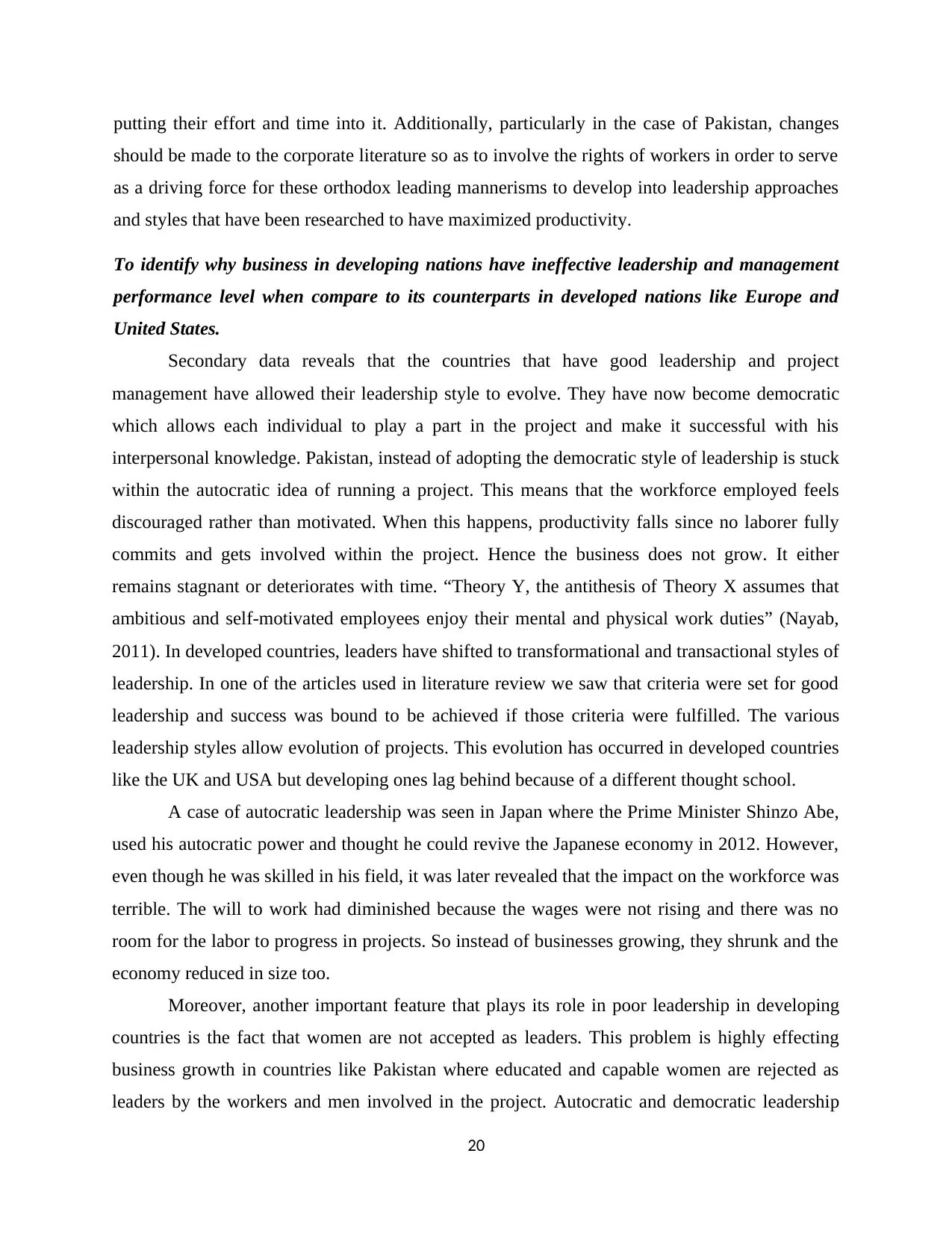
putting their effort and time into it. Additionally, particularly in the case of Pakistan, changes
should be made to the corporate literature so as to involve the rights of workers in order to serve
as a driving force for these orthodox leading mannerisms to develop into leadership approaches
and styles that have been researched to have maximized productivity.
To identify why business in developing nations have ineffective leadership and management
performance level when compare to its counterparts in developed nations like Europe and
United States.
Secondary data reveals that the countries that have good leadership and project
management have allowed their leadership style to evolve. They have now become democratic
which allows each individual to play a part in the project and make it successful with his
interpersonal knowledge. Pakistan, instead of adopting the democratic style of leadership is stuck
within the autocratic idea of running a project. This means that the workforce employed feels
discouraged rather than motivated. When this happens, productivity falls since no laborer fully
commits and gets involved within the project. Hence the business does not grow. It either
remains stagnant or deteriorates with time. “Theory Y, the antithesis of Theory X assumes that
ambitious and self-motivated employees enjoy their mental and physical work duties” (Nayab,
2011). In developed countries, leaders have shifted to transformational and transactional styles of
leadership. In one of the articles used in literature review we saw that criteria were set for good
leadership and success was bound to be achieved if those criteria were fulfilled. The various
leadership styles allow evolution of projects. This evolution has occurred in developed countries
like the UK and USA but developing ones lag behind because of a different thought school.
A case of autocratic leadership was seen in Japan where the Prime Minister Shinzo Abe,
used his autocratic power and thought he could revive the Japanese economy in 2012. However,
even though he was skilled in his field, it was later revealed that the impact on the workforce was
terrible. The will to work had diminished because the wages were not rising and there was no
room for the labor to progress in projects. So instead of businesses growing, they shrunk and the
economy reduced in size too.
Moreover, another important feature that plays its role in poor leadership in developing
countries is the fact that women are not accepted as leaders. This problem is highly effecting
business growth in countries like Pakistan where educated and capable women are rejected as
leaders by the workers and men involved in the project. Autocratic and democratic leadership
20
should be made to the corporate literature so as to involve the rights of workers in order to serve
as a driving force for these orthodox leading mannerisms to develop into leadership approaches
and styles that have been researched to have maximized productivity.
To identify why business in developing nations have ineffective leadership and management
performance level when compare to its counterparts in developed nations like Europe and
United States.
Secondary data reveals that the countries that have good leadership and project
management have allowed their leadership style to evolve. They have now become democratic
which allows each individual to play a part in the project and make it successful with his
interpersonal knowledge. Pakistan, instead of adopting the democratic style of leadership is stuck
within the autocratic idea of running a project. This means that the workforce employed feels
discouraged rather than motivated. When this happens, productivity falls since no laborer fully
commits and gets involved within the project. Hence the business does not grow. It either
remains stagnant or deteriorates with time. “Theory Y, the antithesis of Theory X assumes that
ambitious and self-motivated employees enjoy their mental and physical work duties” (Nayab,
2011). In developed countries, leaders have shifted to transformational and transactional styles of
leadership. In one of the articles used in literature review we saw that criteria were set for good
leadership and success was bound to be achieved if those criteria were fulfilled. The various
leadership styles allow evolution of projects. This evolution has occurred in developed countries
like the UK and USA but developing ones lag behind because of a different thought school.
A case of autocratic leadership was seen in Japan where the Prime Minister Shinzo Abe,
used his autocratic power and thought he could revive the Japanese economy in 2012. However,
even though he was skilled in his field, it was later revealed that the impact on the workforce was
terrible. The will to work had diminished because the wages were not rising and there was no
room for the labor to progress in projects. So instead of businesses growing, they shrunk and the
economy reduced in size too.
Moreover, another important feature that plays its role in poor leadership in developing
countries is the fact that women are not accepted as leaders. This problem is highly effecting
business growth in countries like Pakistan where educated and capable women are rejected as
leaders by the workers and men involved in the project. Autocratic and democratic leadership
20
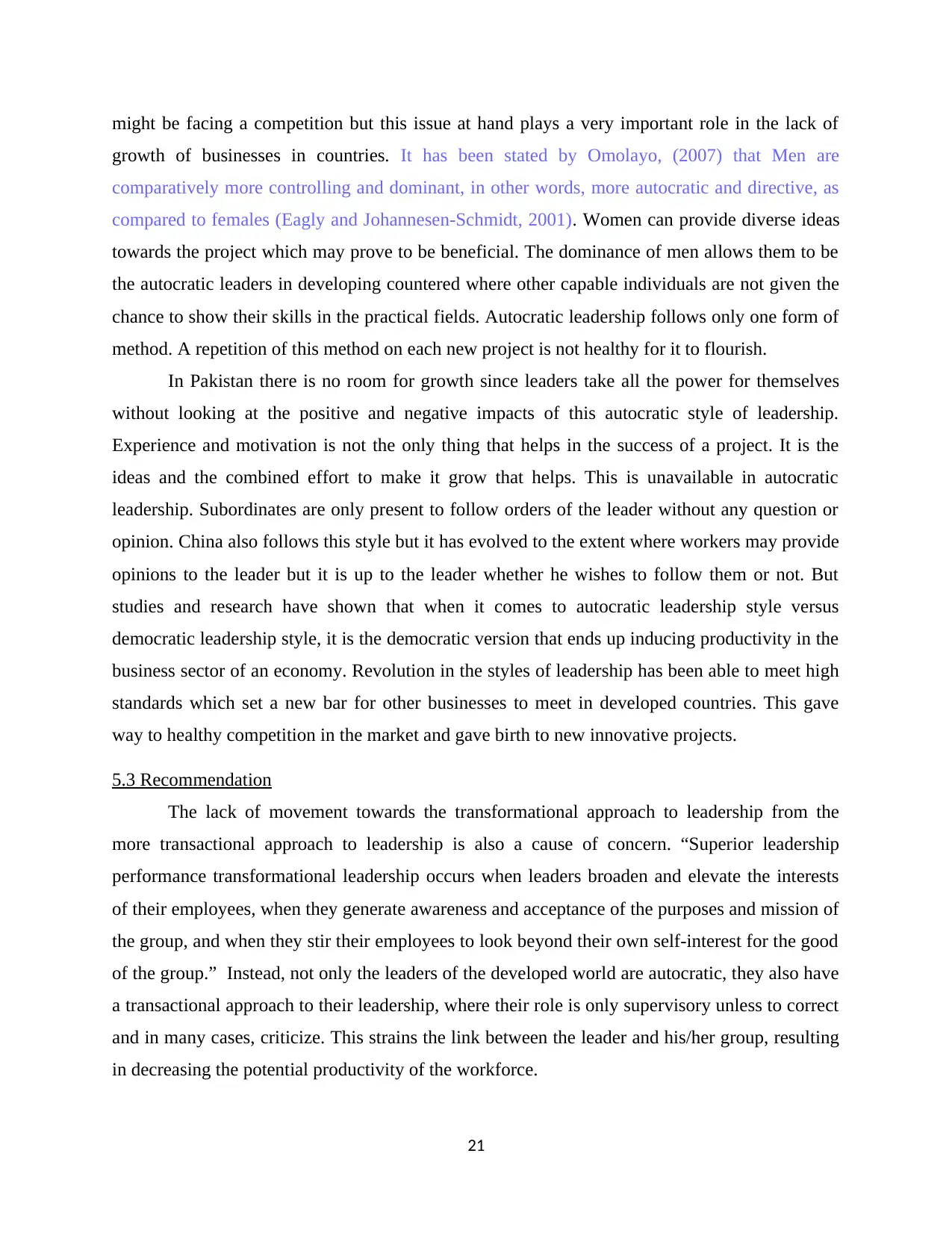
might be facing a competition but this issue at hand plays a very important role in the lack of
growth of businesses in countries. It has been stated by Omolayo, (2007) that Men are
comparatively more controlling and dominant, in other words, more autocratic and directive, as
compared to females (Eagly and Johannesen-Schmidt, 2001). Women can provide diverse ideas
towards the project which may prove to be beneficial. The dominance of men allows them to be
the autocratic leaders in developing countered where other capable individuals are not given the
chance to show their skills in the practical fields. Autocratic leadership follows only one form of
method. A repetition of this method on each new project is not healthy for it to flourish.
In Pakistan there is no room for growth since leaders take all the power for themselves
without looking at the positive and negative impacts of this autocratic style of leadership.
Experience and motivation is not the only thing that helps in the success of a project. It is the
ideas and the combined effort to make it grow that helps. This is unavailable in autocratic
leadership. Subordinates are only present to follow orders of the leader without any question or
opinion. China also follows this style but it has evolved to the extent where workers may provide
opinions to the leader but it is up to the leader whether he wishes to follow them or not. But
studies and research have shown that when it comes to autocratic leadership style versus
democratic leadership style, it is the democratic version that ends up inducing productivity in the
business sector of an economy. Revolution in the styles of leadership has been able to meet high
standards which set a new bar for other businesses to meet in developed countries. This gave
way to healthy competition in the market and gave birth to new innovative projects.
5.3 Recommendation
The lack of movement towards the transformational approach to leadership from the
more transactional approach to leadership is also a cause of concern. “Superior leadership
performance transformational leadership occurs when leaders broaden and elevate the interests
of their employees, when they generate awareness and acceptance of the purposes and mission of
the group, and when they stir their employees to look beyond their own self-interest for the good
of the group.” Instead, not only the leaders of the developed world are autocratic, they also have
a transactional approach to their leadership, where their role is only supervisory unless to correct
and in many cases, criticize. This strains the link between the leader and his/her group, resulting
in decreasing the potential productivity of the workforce.
21
growth of businesses in countries. It has been stated by Omolayo, (2007) that Men are
comparatively more controlling and dominant, in other words, more autocratic and directive, as
compared to females (Eagly and Johannesen-Schmidt, 2001). Women can provide diverse ideas
towards the project which may prove to be beneficial. The dominance of men allows them to be
the autocratic leaders in developing countered where other capable individuals are not given the
chance to show their skills in the practical fields. Autocratic leadership follows only one form of
method. A repetition of this method on each new project is not healthy for it to flourish.
In Pakistan there is no room for growth since leaders take all the power for themselves
without looking at the positive and negative impacts of this autocratic style of leadership.
Experience and motivation is not the only thing that helps in the success of a project. It is the
ideas and the combined effort to make it grow that helps. This is unavailable in autocratic
leadership. Subordinates are only present to follow orders of the leader without any question or
opinion. China also follows this style but it has evolved to the extent where workers may provide
opinions to the leader but it is up to the leader whether he wishes to follow them or not. But
studies and research have shown that when it comes to autocratic leadership style versus
democratic leadership style, it is the democratic version that ends up inducing productivity in the
business sector of an economy. Revolution in the styles of leadership has been able to meet high
standards which set a new bar for other businesses to meet in developed countries. This gave
way to healthy competition in the market and gave birth to new innovative projects.
5.3 Recommendation
The lack of movement towards the transformational approach to leadership from the
more transactional approach to leadership is also a cause of concern. “Superior leadership
performance transformational leadership occurs when leaders broaden and elevate the interests
of their employees, when they generate awareness and acceptance of the purposes and mission of
the group, and when they stir their employees to look beyond their own self-interest for the good
of the group.” Instead, not only the leaders of the developed world are autocratic, they also have
a transactional approach to their leadership, where their role is only supervisory unless to correct
and in many cases, criticize. This strains the link between the leader and his/her group, resulting
in decreasing the potential productivity of the workforce.
21
Secure Best Marks with AI Grader
Need help grading? Try our AI Grader for instant feedback on your assignments.
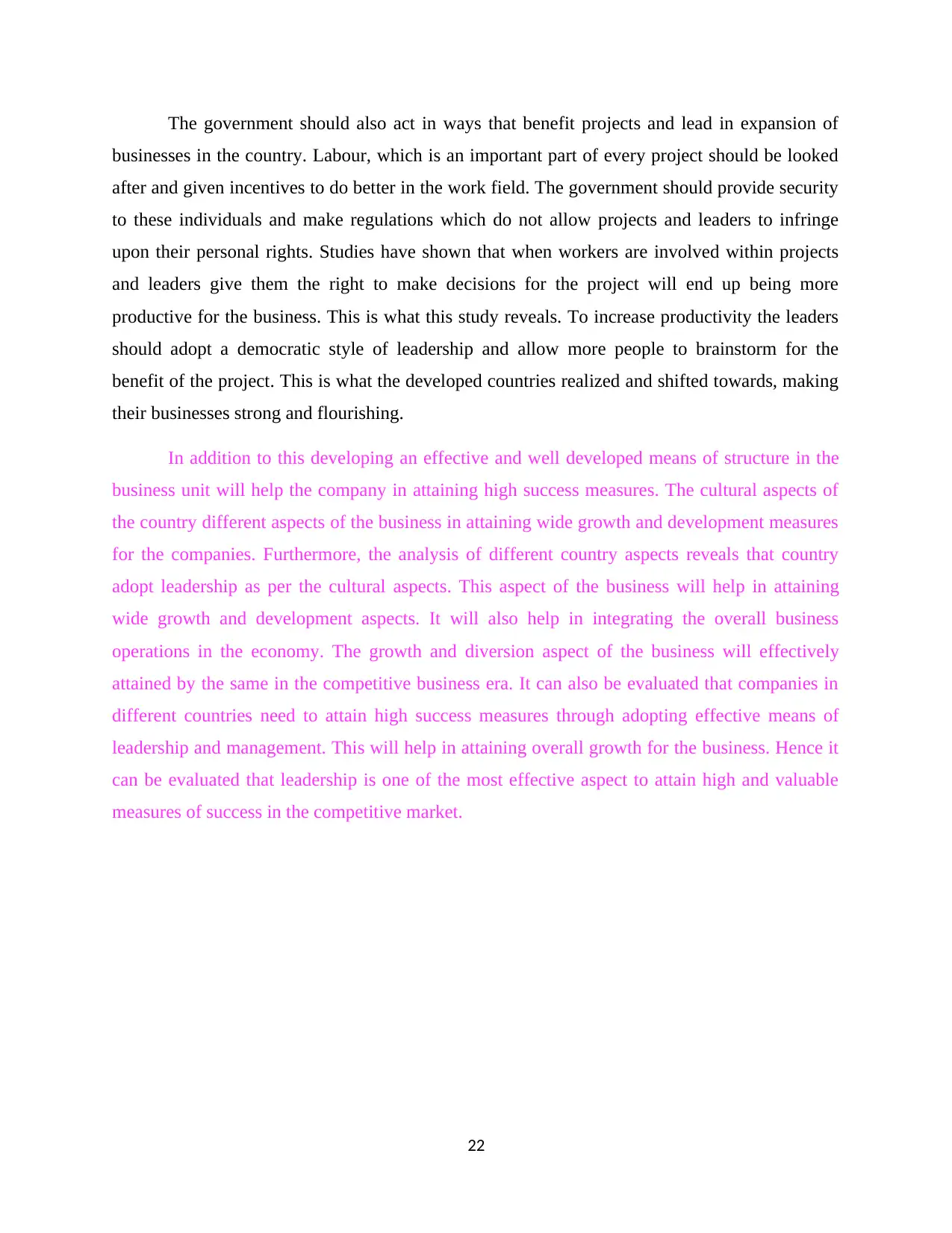
The government should also act in ways that benefit projects and lead in expansion of
businesses in the country. Labour, which is an important part of every project should be looked
after and given incentives to do better in the work field. The government should provide security
to these individuals and make regulations which do not allow projects and leaders to infringe
upon their personal rights. Studies have shown that when workers are involved within projects
and leaders give them the right to make decisions for the project will end up being more
productive for the business. This is what this study reveals. To increase productivity the leaders
should adopt a democratic style of leadership and allow more people to brainstorm for the
benefit of the project. This is what the developed countries realized and shifted towards, making
their businesses strong and flourishing.
In addition to this developing an effective and well developed means of structure in the
business unit will help the company in attaining high success measures. The cultural aspects of
the country different aspects of the business in attaining wide growth and development measures
for the companies. Furthermore, the analysis of different country aspects reveals that country
adopt leadership as per the cultural aspects. This aspect of the business will help in attaining
wide growth and development aspects. It will also help in integrating the overall business
operations in the economy. The growth and diversion aspect of the business will effectively
attained by the same in the competitive business era. It can also be evaluated that companies in
different countries need to attain high success measures through adopting effective means of
leadership and management. This will help in attaining overall growth for the business. Hence it
can be evaluated that leadership is one of the most effective aspect to attain high and valuable
measures of success in the competitive market.
22
businesses in the country. Labour, which is an important part of every project should be looked
after and given incentives to do better in the work field. The government should provide security
to these individuals and make regulations which do not allow projects and leaders to infringe
upon their personal rights. Studies have shown that when workers are involved within projects
and leaders give them the right to make decisions for the project will end up being more
productive for the business. This is what this study reveals. To increase productivity the leaders
should adopt a democratic style of leadership and allow more people to brainstorm for the
benefit of the project. This is what the developed countries realized and shifted towards, making
their businesses strong and flourishing.
In addition to this developing an effective and well developed means of structure in the
business unit will help the company in attaining high success measures. The cultural aspects of
the country different aspects of the business in attaining wide growth and development measures
for the companies. Furthermore, the analysis of different country aspects reveals that country
adopt leadership as per the cultural aspects. This aspect of the business will help in attaining
wide growth and development aspects. It will also help in integrating the overall business
operations in the economy. The growth and diversion aspect of the business will effectively
attained by the same in the competitive business era. It can also be evaluated that companies in
different countries need to attain high success measures through adopting effective means of
leadership and management. This will help in attaining overall growth for the business. Hence it
can be evaluated that leadership is one of the most effective aspect to attain high and valuable
measures of success in the competitive market.
22

CHAPTER 8: REFLECTIVE CHAPTER
6.1. Introduction
This chapter would act as a foresight into the dissertation, explaining briefly the
background of the research, its main motive, the methodology employed to gather data regarding
the research, the analysis of the data, its findings and finally, the conclusion to the hypothesis
being tested by the research because this research primary employs the use of secondary data and
in effect, is secondary research, it will take into account several pre-published works revolving
around the research question so as to gain a vast insight into the various leadership styles, their
usage in various countries, and the productivity of the various economies being studied in the
research. Although this research vastly focuses on developing countries and their economies, to
narrow the focus of the dissertation, Pakistan has been chosen as the representative of developing
economies and hence, organizations operating in Pakistan will be taken under consideration
when tasting the hypothesis and gathering data.
In summary, this research aims to determine the reason behind the vast disparity between
organizations operating in developed economies in contrast with those working in developing
economies when it comes to their success and productivity. The research also aims to establish a
link between the leadership of managers and how employees are led by these individuals in these
different economies, aiming to identify a correlation between the two, if any. This would be
analyzed through different relevant literature available on the internet, books and different
relevant and updated journals to find out the most relevant results in the final section of this
research work.
6.2. The Concept of Project Leadership
Of all factors leading to the success of a project or an organization, the organizational
structure, that is the framework of the project and organization, and who leads and manages it, is
the most crucial. Leadership can be defined as the art through which the leader motivates his
subordinates in order to materialize certain tasks that has been assigned or a duty to be
accomplished. A leader’s job is to provide a direction for his/her subordinates and to manage and
motivate them to work in a way that maximizes their potential. The behavior of any organization
is set by its leaders who further describe the vision, mission and the objectives which the
employees of the organization need to achieve. They set the goals for an organization or a
23
6.1. Introduction
This chapter would act as a foresight into the dissertation, explaining briefly the
background of the research, its main motive, the methodology employed to gather data regarding
the research, the analysis of the data, its findings and finally, the conclusion to the hypothesis
being tested by the research because this research primary employs the use of secondary data and
in effect, is secondary research, it will take into account several pre-published works revolving
around the research question so as to gain a vast insight into the various leadership styles, their
usage in various countries, and the productivity of the various economies being studied in the
research. Although this research vastly focuses on developing countries and their economies, to
narrow the focus of the dissertation, Pakistan has been chosen as the representative of developing
economies and hence, organizations operating in Pakistan will be taken under consideration
when tasting the hypothesis and gathering data.
In summary, this research aims to determine the reason behind the vast disparity between
organizations operating in developed economies in contrast with those working in developing
economies when it comes to their success and productivity. The research also aims to establish a
link between the leadership of managers and how employees are led by these individuals in these
different economies, aiming to identify a correlation between the two, if any. This would be
analyzed through different relevant literature available on the internet, books and different
relevant and updated journals to find out the most relevant results in the final section of this
research work.
6.2. The Concept of Project Leadership
Of all factors leading to the success of a project or an organization, the organizational
structure, that is the framework of the project and organization, and who leads and manages it, is
the most crucial. Leadership can be defined as the art through which the leader motivates his
subordinates in order to materialize certain tasks that has been assigned or a duty to be
accomplished. A leader’s job is to provide a direction for his/her subordinates and to manage and
motivate them to work in a way that maximizes their potential. The behavior of any organization
is set by its leaders who further describe the vision, mission and the objectives which the
employees of the organization need to achieve. They set the goals for an organization or a
23
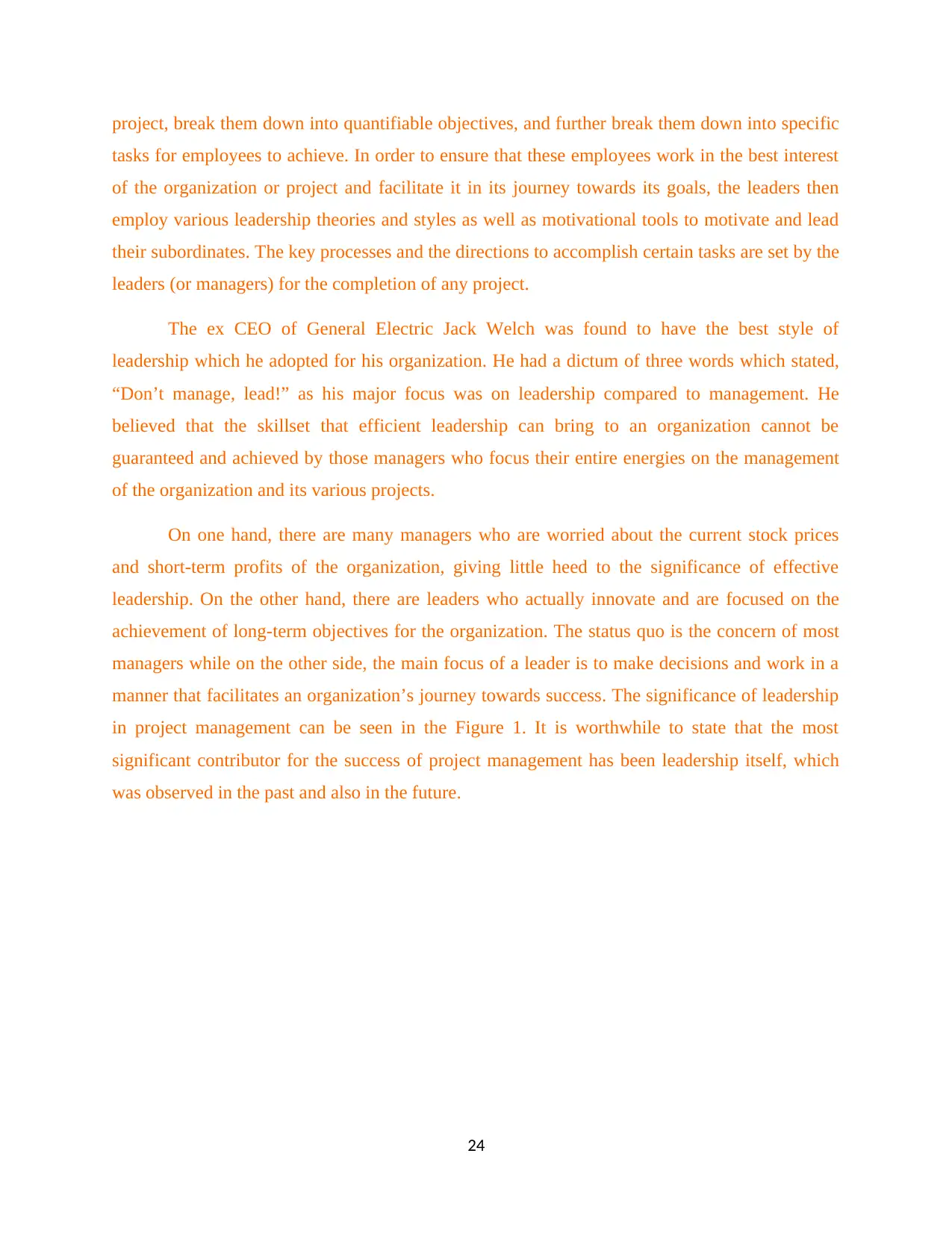
project, break them down into quantifiable objectives, and further break them down into specific
tasks for employees to achieve. In order to ensure that these employees work in the best interest
of the organization or project and facilitate it in its journey towards its goals, the leaders then
employ various leadership theories and styles as well as motivational tools to motivate and lead
their subordinates. The key processes and the directions to accomplish certain tasks are set by the
leaders (or managers) for the completion of any project.
The ex CEO of General Electric Jack Welch was found to have the best style of
leadership which he adopted for his organization. He had a dictum of three words which stated,
“Don’t manage, lead!” as his major focus was on leadership compared to management. He
believed that the skillset that efficient leadership can bring to an organization cannot be
guaranteed and achieved by those managers who focus their entire energies on the management
of the organization and its various projects.
On one hand, there are many managers who are worried about the current stock prices
and short-term profits of the organization, giving little heed to the significance of effective
leadership. On the other hand, there are leaders who actually innovate and are focused on the
achievement of long-term objectives for the organization. The status quo is the concern of most
managers while on the other side, the main focus of a leader is to make decisions and work in a
manner that facilitates an organization’s journey towards success. The significance of leadership
in project management can be seen in the Figure 1. It is worthwhile to state that the most
significant contributor for the success of project management has been leadership itself, which
was observed in the past and also in the future.
24
tasks for employees to achieve. In order to ensure that these employees work in the best interest
of the organization or project and facilitate it in its journey towards its goals, the leaders then
employ various leadership theories and styles as well as motivational tools to motivate and lead
their subordinates. The key processes and the directions to accomplish certain tasks are set by the
leaders (or managers) for the completion of any project.
The ex CEO of General Electric Jack Welch was found to have the best style of
leadership which he adopted for his organization. He had a dictum of three words which stated,
“Don’t manage, lead!” as his major focus was on leadership compared to management. He
believed that the skillset that efficient leadership can bring to an organization cannot be
guaranteed and achieved by those managers who focus their entire energies on the management
of the organization and its various projects.
On one hand, there are many managers who are worried about the current stock prices
and short-term profits of the organization, giving little heed to the significance of effective
leadership. On the other hand, there are leaders who actually innovate and are focused on the
achievement of long-term objectives for the organization. The status quo is the concern of most
managers while on the other side, the main focus of a leader is to make decisions and work in a
manner that facilitates an organization’s journey towards success. The significance of leadership
in project management can be seen in the Figure 1. It is worthwhile to state that the most
significant contributor for the success of project management has been leadership itself, which
was observed in the past and also in the future.
24
Paraphrase This Document
Need a fresh take? Get an instant paraphrase of this document with our AI Paraphraser
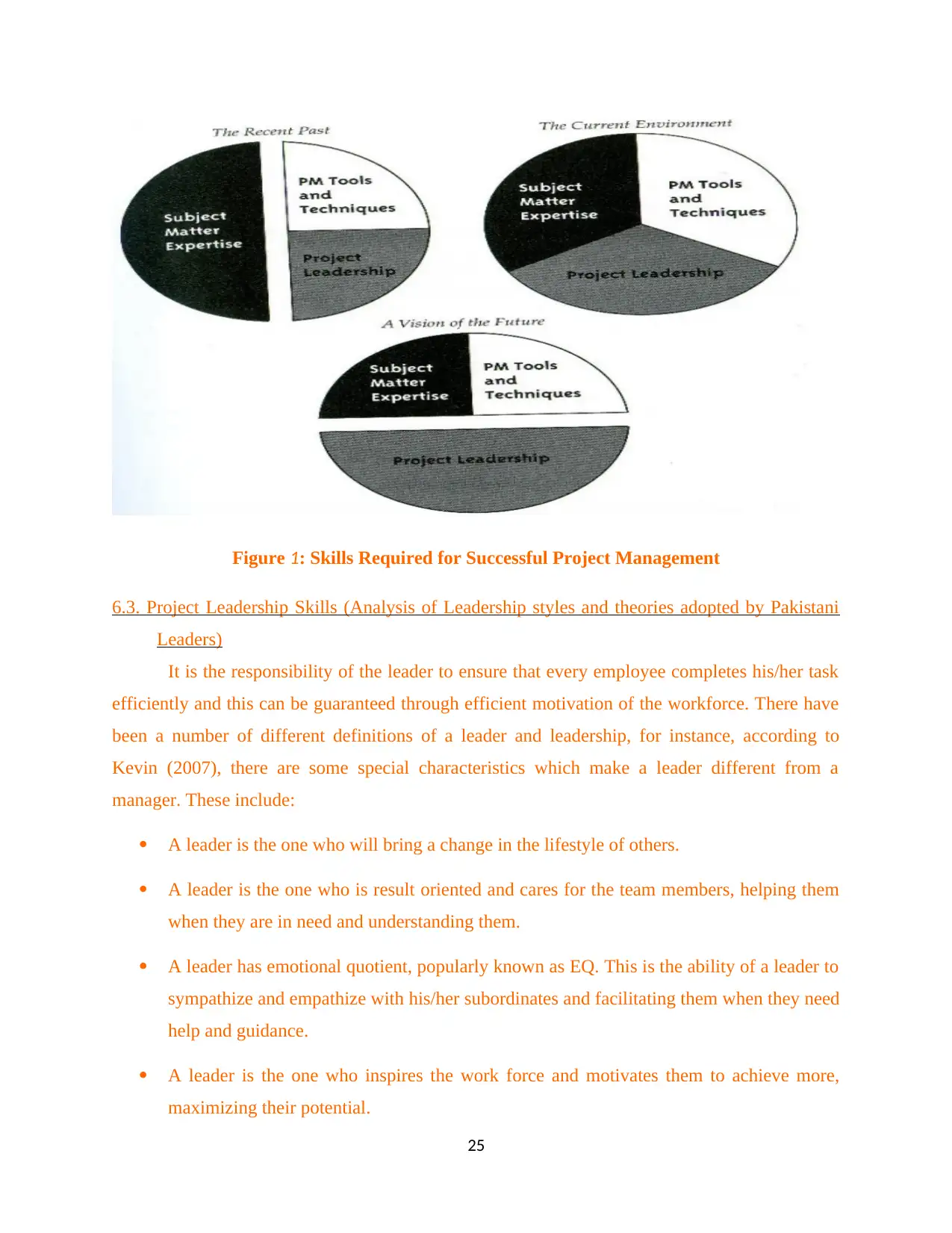
Figure 1: Skills Required for Successful Project Management
6.3. Project Leadership Skills (Analysis of Leadership styles and theories adopted by Pakistani
Leaders)
It is the responsibility of the leader to ensure that every employee completes his/her task
efficiently and this can be guaranteed through efficient motivation of the workforce. There have
been a number of different definitions of a leader and leadership, for instance, according to
Kevin (2007), there are some special characteristics which make a leader different from a
manager. These include:
A leader is the one who will bring a change in the lifestyle of others.
A leader is the one who is result oriented and cares for the team members, helping them
when they are in need and understanding them.
A leader has emotional quotient, popularly known as EQ. This is the ability of a leader to
sympathize and empathize with his/her subordinates and facilitating them when they need
help and guidance.
A leader is the one who inspires the work force and motivates them to achieve more,
maximizing their potential.
25
6.3. Project Leadership Skills (Analysis of Leadership styles and theories adopted by Pakistani
Leaders)
It is the responsibility of the leader to ensure that every employee completes his/her task
efficiently and this can be guaranteed through efficient motivation of the workforce. There have
been a number of different definitions of a leader and leadership, for instance, according to
Kevin (2007), there are some special characteristics which make a leader different from a
manager. These include:
A leader is the one who will bring a change in the lifestyle of others.
A leader is the one who is result oriented and cares for the team members, helping them
when they are in need and understanding them.
A leader has emotional quotient, popularly known as EQ. This is the ability of a leader to
sympathize and empathize with his/her subordinates and facilitating them when they need
help and guidance.
A leader is the one who inspires the work force and motivates them to achieve more,
maximizing their potential.
25
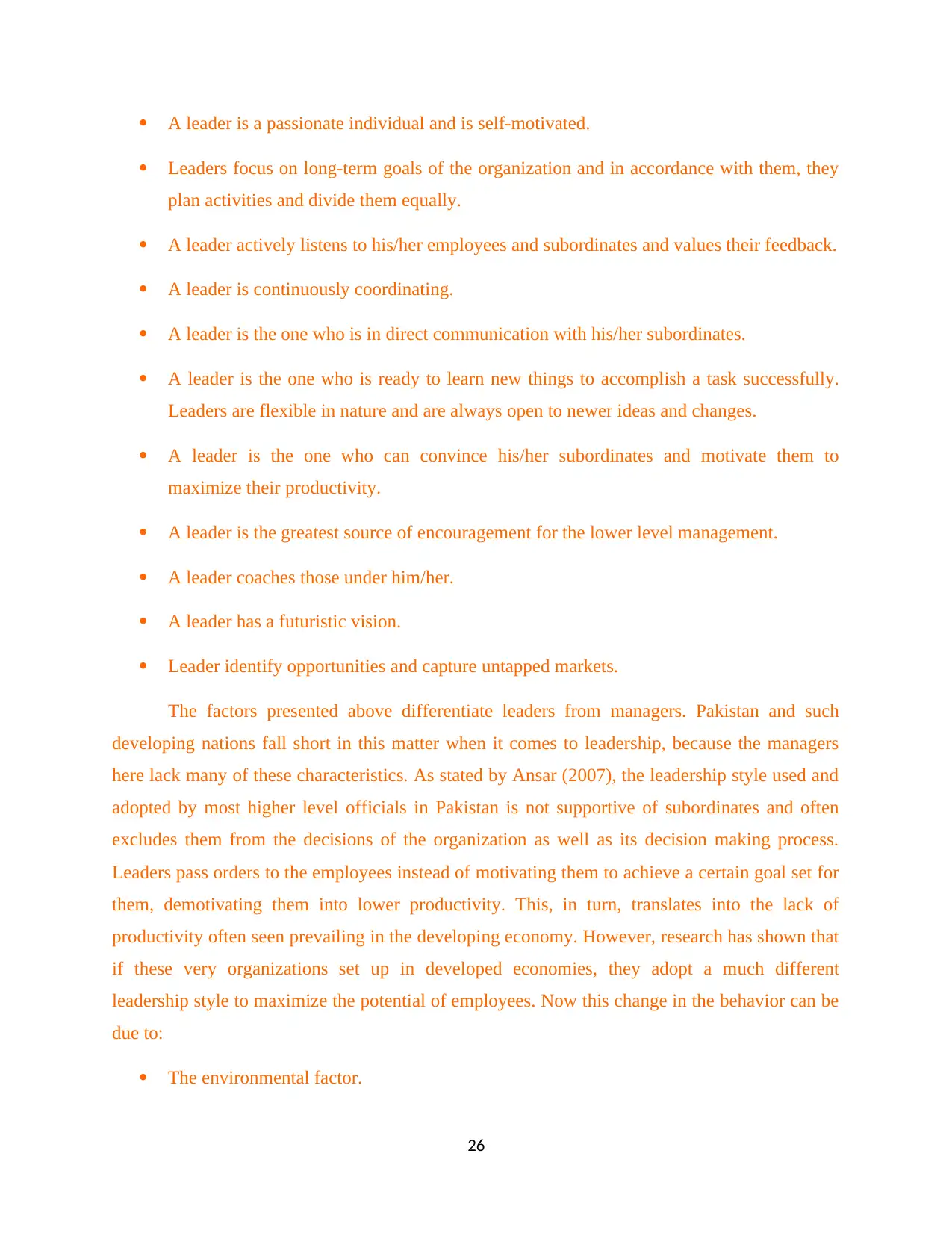
A leader is a passionate individual and is self-motivated.
Leaders focus on long-term goals of the organization and in accordance with them, they
plan activities and divide them equally.
A leader actively listens to his/her employees and subordinates and values their feedback.
A leader is continuously coordinating.
A leader is the one who is in direct communication with his/her subordinates.
A leader is the one who is ready to learn new things to accomplish a task successfully.
Leaders are flexible in nature and are always open to newer ideas and changes.
A leader is the one who can convince his/her subordinates and motivate them to
maximize their productivity.
A leader is the greatest source of encouragement for the lower level management.
A leader coaches those under him/her.
A leader has a futuristic vision.
Leader identify opportunities and capture untapped markets.
The factors presented above differentiate leaders from managers. Pakistan and such
developing nations fall short in this matter when it comes to leadership, because the managers
here lack many of these characteristics. As stated by Ansar (2007), the leadership style used and
adopted by most higher level officials in Pakistan is not supportive of subordinates and often
excludes them from the decisions of the organization as well as its decision making process.
Leaders pass orders to the employees instead of motivating them to achieve a certain goal set for
them, demotivating them into lower productivity. This, in turn, translates into the lack of
productivity often seen prevailing in the developing economy. However, research has shown that
if these very organizations set up in developed economies, they adopt a much different
leadership style to maximize the potential of employees. Now this change in the behavior can be
due to:
The environmental factor.
26
Leaders focus on long-term goals of the organization and in accordance with them, they
plan activities and divide them equally.
A leader actively listens to his/her employees and subordinates and values their feedback.
A leader is continuously coordinating.
A leader is the one who is in direct communication with his/her subordinates.
A leader is the one who is ready to learn new things to accomplish a task successfully.
Leaders are flexible in nature and are always open to newer ideas and changes.
A leader is the one who can convince his/her subordinates and motivate them to
maximize their productivity.
A leader is the greatest source of encouragement for the lower level management.
A leader coaches those under him/her.
A leader has a futuristic vision.
Leader identify opportunities and capture untapped markets.
The factors presented above differentiate leaders from managers. Pakistan and such
developing nations fall short in this matter when it comes to leadership, because the managers
here lack many of these characteristics. As stated by Ansar (2007), the leadership style used and
adopted by most higher level officials in Pakistan is not supportive of subordinates and often
excludes them from the decisions of the organization as well as its decision making process.
Leaders pass orders to the employees instead of motivating them to achieve a certain goal set for
them, demotivating them into lower productivity. This, in turn, translates into the lack of
productivity often seen prevailing in the developing economy. However, research has shown that
if these very organizations set up in developed economies, they adopt a much different
leadership style to maximize the potential of employees. Now this change in the behavior can be
due to:
The environmental factor.
26
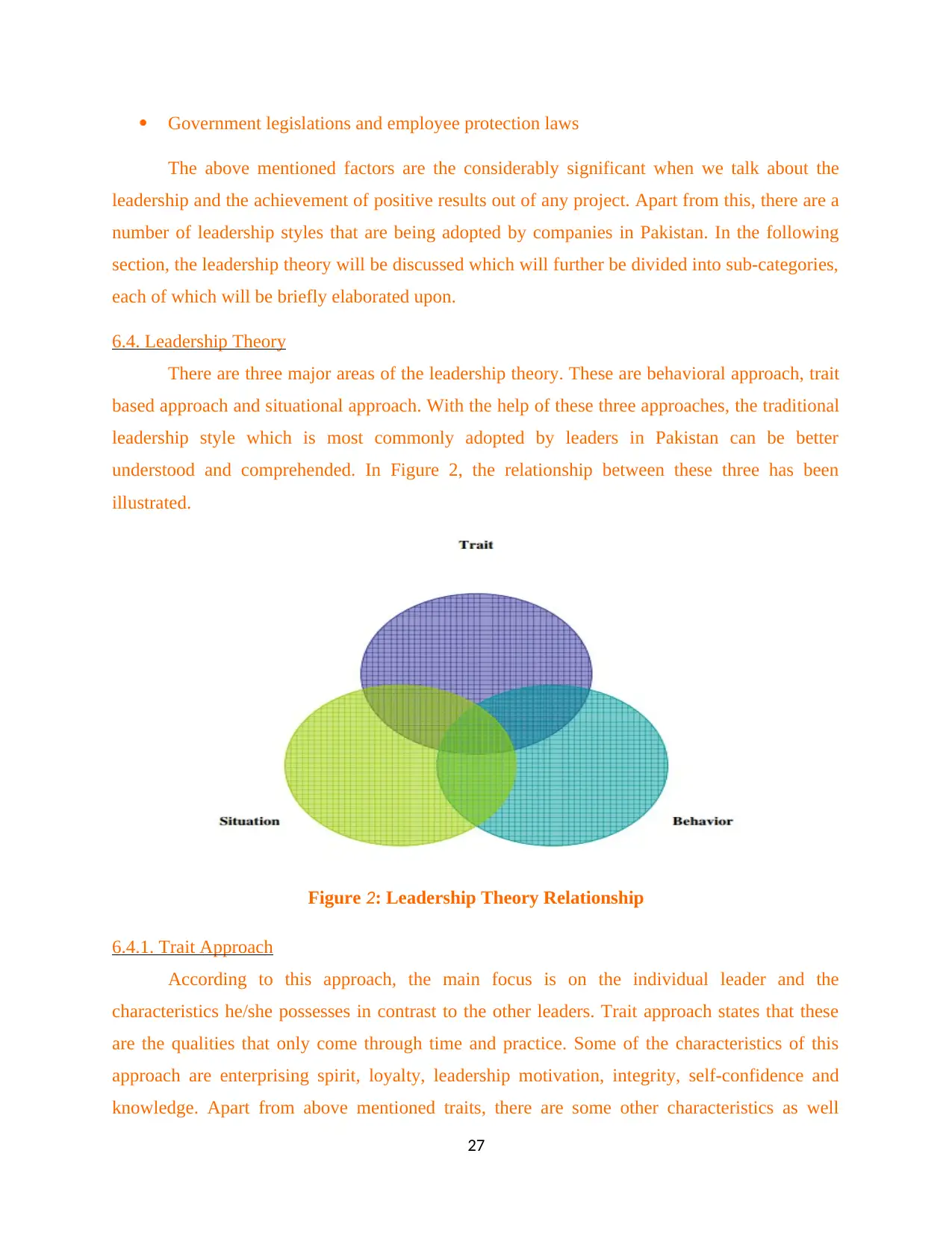
Government legislations and employee protection laws
The above mentioned factors are the considerably significant when we talk about the
leadership and the achievement of positive results out of any project. Apart from this, there are a
number of leadership styles that are being adopted by companies in Pakistan. In the following
section, the leadership theory will be discussed which will further be divided into sub-categories,
each of which will be briefly elaborated upon.
6.4. Leadership Theory
There are three major areas of the leadership theory. These are behavioral approach, trait
based approach and situational approach. With the help of these three approaches, the traditional
leadership style which is most commonly adopted by leaders in Pakistan can be better
understood and comprehended. In Figure 2, the relationship between these three has been
illustrated.
Figure 2: Leadership Theory Relationship
6.4.1. Trait Approach
According to this approach, the main focus is on the individual leader and the
characteristics he/she possesses in contrast to the other leaders. Trait approach states that these
are the qualities that only come through time and practice. Some of the characteristics of this
approach are enterprising spirit, loyalty, leadership motivation, integrity, self-confidence and
knowledge. Apart from above mentioned traits, there are some other characteristics as well
27
The above mentioned factors are the considerably significant when we talk about the
leadership and the achievement of positive results out of any project. Apart from this, there are a
number of leadership styles that are being adopted by companies in Pakistan. In the following
section, the leadership theory will be discussed which will further be divided into sub-categories,
each of which will be briefly elaborated upon.
6.4. Leadership Theory
There are three major areas of the leadership theory. These are behavioral approach, trait
based approach and situational approach. With the help of these three approaches, the traditional
leadership style which is most commonly adopted by leaders in Pakistan can be better
understood and comprehended. In Figure 2, the relationship between these three has been
illustrated.
Figure 2: Leadership Theory Relationship
6.4.1. Trait Approach
According to this approach, the main focus is on the individual leader and the
characteristics he/she possesses in contrast to the other leaders. Trait approach states that these
are the qualities that only come through time and practice. Some of the characteristics of this
approach are enterprising spirit, loyalty, leadership motivation, integrity, self-confidence and
knowledge. Apart from above mentioned traits, there are some other characteristics as well
27
Secure Best Marks with AI Grader
Need help grading? Try our AI Grader for instant feedback on your assignments.

which have a significant influence on the leadership and organizational behavior such as the
intelligence, inspiring personality, competence and forward looking approach of leaders.
6.4.2. Behavioral Approach
The focus of this approach is not based on qualities which come from within and cannot
be adopted, but this approach hones in on the actual working of the leader. There are three
categories into which the behavioral approach has been classified. These include behavior related
to employee participation in the process of decision making; behavior in relation to the
maintenance of group and behavior in relation to the performance in accomplishing a task.
6.4.3. Situational Approaches to Leadership
In this type of approach, the leaders are examined by their ability to handle a crisis
situation. In other words, how these individuals respond in an emergency is observed. The
leadership is determined by the extent to which they make successful and effective decisions in
real time and motivate others to perform in a manner that steers the organization out of crises.
The factors of this approach include the organizational structure, the influence of upper level
management, personal preferences, type of project and the characteristics of the subordinates.
28
intelligence, inspiring personality, competence and forward looking approach of leaders.
6.4.2. Behavioral Approach
The focus of this approach is not based on qualities which come from within and cannot
be adopted, but this approach hones in on the actual working of the leader. There are three
categories into which the behavioral approach has been classified. These include behavior related
to employee participation in the process of decision making; behavior in relation to the
maintenance of group and behavior in relation to the performance in accomplishing a task.
6.4.3. Situational Approaches to Leadership
In this type of approach, the leaders are examined by their ability to handle a crisis
situation. In other words, how these individuals respond in an emergency is observed. The
leadership is determined by the extent to which they make successful and effective decisions in
real time and motivate others to perform in a manner that steers the organization out of crises.
The factors of this approach include the organizational structure, the influence of upper level
management, personal preferences, type of project and the characteristics of the subordinates.
28
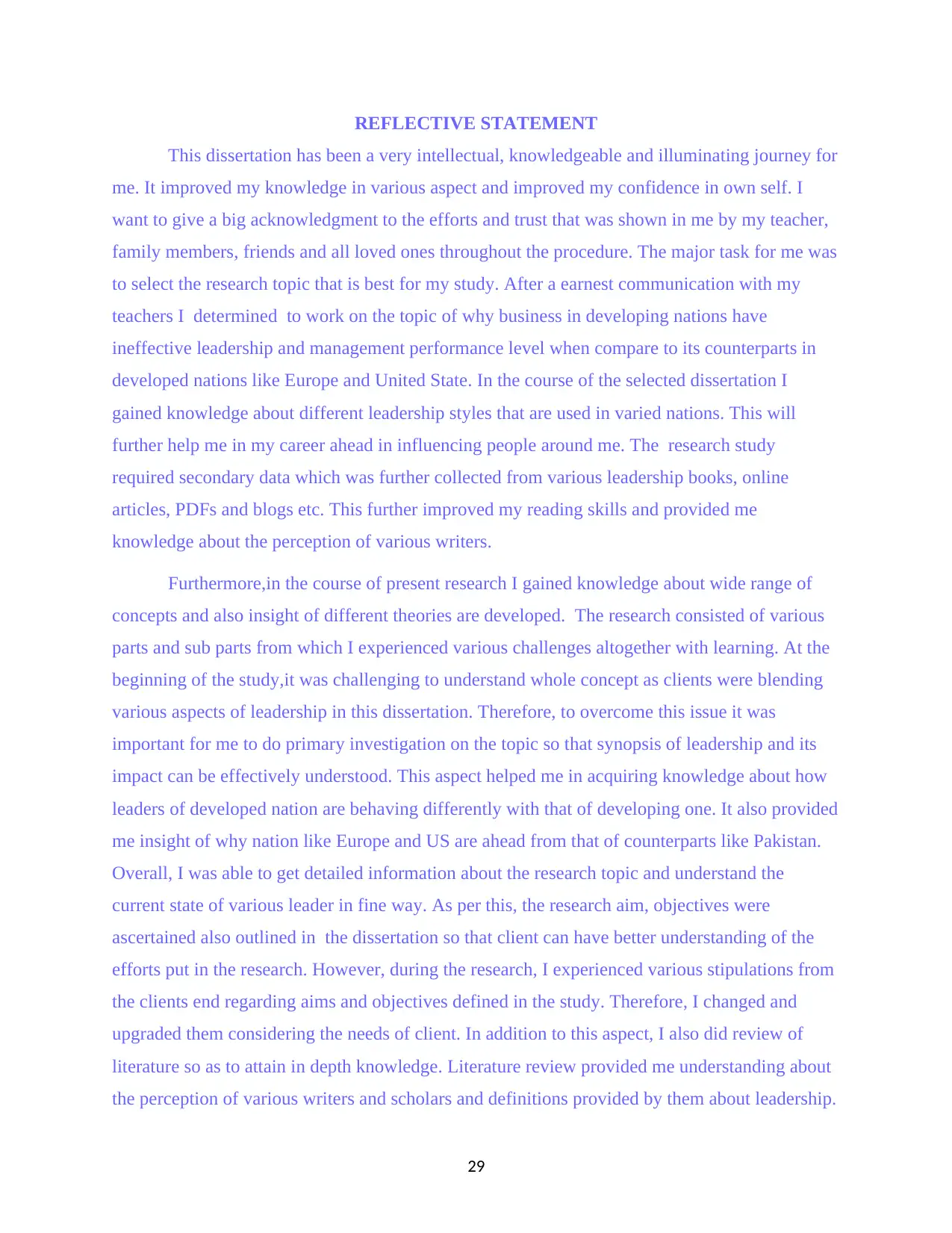
REFLECTIVE STATEMENT
This dissertation has been a very intellectual, knowledgeable and illuminating journey for
me. It improved my knowledge in various aspect and improved my confidence in own self. I
want to give a big acknowledgment to the efforts and trust that was shown in me by my teacher,
family members, friends and all loved ones throughout the procedure. The major task for me was
to select the research topic that is best for my study. After a earnest communication with my
teachers I determined to work on the topic of why business in developing nations have
ineffective leadership and management performance level when compare to its counterparts in
developed nations like Europe and United State. In the course of the selected dissertation I
gained knowledge about different leadership styles that are used in varied nations. This will
further help me in my career ahead in influencing people around me. The research study
required secondary data which was further collected from various leadership books, online
articles, PDFs and blogs etc. This further improved my reading skills and provided me
knowledge about the perception of various writers.
Furthermore,in the course of present research I gained knowledge about wide range of
concepts and also insight of different theories are developed. The research consisted of various
parts and sub parts from which I experienced various challenges altogether with learning. At the
beginning of the study,it was challenging to understand whole concept as clients were blending
various aspects of leadership in this dissertation. Therefore, to overcome this issue it was
important for me to do primary investigation on the topic so that synopsis of leadership and its
impact can be effectively understood. This aspect helped me in acquiring knowledge about how
leaders of developed nation are behaving differently with that of developing one. It also provided
me insight of why nation like Europe and US are ahead from that of counterparts like Pakistan.
Overall, I was able to get detailed information about the research topic and understand the
current state of various leader in fine way. As per this, the research aim, objectives were
ascertained also outlined in the dissertation so that client can have better understanding of the
efforts put in the research. However, during the research, I experienced various stipulations from
the clients end regarding aims and objectives defined in the study. Therefore, I changed and
upgraded them considering the needs of client. In addition to this aspect, I also did review of
literature so as to attain in depth knowledge. Literature review provided me understanding about
the perception of various writers and scholars and definitions provided by them about leadership.
29
This dissertation has been a very intellectual, knowledgeable and illuminating journey for
me. It improved my knowledge in various aspect and improved my confidence in own self. I
want to give a big acknowledgment to the efforts and trust that was shown in me by my teacher,
family members, friends and all loved ones throughout the procedure. The major task for me was
to select the research topic that is best for my study. After a earnest communication with my
teachers I determined to work on the topic of why business in developing nations have
ineffective leadership and management performance level when compare to its counterparts in
developed nations like Europe and United State. In the course of the selected dissertation I
gained knowledge about different leadership styles that are used in varied nations. This will
further help me in my career ahead in influencing people around me. The research study
required secondary data which was further collected from various leadership books, online
articles, PDFs and blogs etc. This further improved my reading skills and provided me
knowledge about the perception of various writers.
Furthermore,in the course of present research I gained knowledge about wide range of
concepts and also insight of different theories are developed. The research consisted of various
parts and sub parts from which I experienced various challenges altogether with learning. At the
beginning of the study,it was challenging to understand whole concept as clients were blending
various aspects of leadership in this dissertation. Therefore, to overcome this issue it was
important for me to do primary investigation on the topic so that synopsis of leadership and its
impact can be effectively understood. This aspect helped me in acquiring knowledge about how
leaders of developed nation are behaving differently with that of developing one. It also provided
me insight of why nation like Europe and US are ahead from that of counterparts like Pakistan.
Overall, I was able to get detailed information about the research topic and understand the
current state of various leader in fine way. As per this, the research aim, objectives were
ascertained also outlined in the dissertation so that client can have better understanding of the
efforts put in the research. However, during the research, I experienced various stipulations from
the clients end regarding aims and objectives defined in the study. Therefore, I changed and
upgraded them considering the needs of client. In addition to this aspect, I also did review of
literature so as to attain in depth knowledge. Literature review provided me understanding about
the perception of various writers and scholars and definitions provided by them about leadership.
29

However, still I was not able to find the specific content desired by me . So, I modified my
investigation criteria and emphasized more on the use of key words. I also discussed with my
mentor regarding the information that must be used by me in the research. He suggested me the
reliable and good sources of information that can be explored by me to facilitate the study. At
last I ascertained my research methods and continued with them. In this respect, various themes
were developed by me to facilitate thematic analysis. Thereafter, I evaluated the knowledge
gained from the research and on the basis of it I provide recommendations that will also help
other researchers.
It is apparent that investigation for dissertation is a time taking process. For determining
which data I must select for my research and gathering the various information a lot of time was
incurred by me. I have learned to employ various types of time management strategies so as to
complete the research within the stipulated time frame. I gained knowledge about the variation
between what is urgent and what is essential. I learn that I need to prioritize my work and
prepare work chart to ensure time management. Thereafter, I developed my analytical skills as I
was significant for me to understand the gathered data in quantitative manner. Thereafter,
reasoning skills are improved as I read the contrasting views of various researchers and writers.
Also, with the gained knowledge of leadership theories, I can use my contrasting influencing
skills to impact different individuals.
Summing up the entire experience of aforementioned research work, it can be said that I
have gained valuable knowledge and contrasting skills that will add towards my personal as well
as professional development. The whole dissertation work was a great and outstanding
experience for me. It is hoped-for that outcomes of the research will prove to be a source of
inspiration for other researchers. The research was a learning curve for me from which I can
imply higher level of professionalism in my working practices.
30
investigation criteria and emphasized more on the use of key words. I also discussed with my
mentor regarding the information that must be used by me in the research. He suggested me the
reliable and good sources of information that can be explored by me to facilitate the study. At
last I ascertained my research methods and continued with them. In this respect, various themes
were developed by me to facilitate thematic analysis. Thereafter, I evaluated the knowledge
gained from the research and on the basis of it I provide recommendations that will also help
other researchers.
It is apparent that investigation for dissertation is a time taking process. For determining
which data I must select for my research and gathering the various information a lot of time was
incurred by me. I have learned to employ various types of time management strategies so as to
complete the research within the stipulated time frame. I gained knowledge about the variation
between what is urgent and what is essential. I learn that I need to prioritize my work and
prepare work chart to ensure time management. Thereafter, I developed my analytical skills as I
was significant for me to understand the gathered data in quantitative manner. Thereafter,
reasoning skills are improved as I read the contrasting views of various researchers and writers.
Also, with the gained knowledge of leadership theories, I can use my contrasting influencing
skills to impact different individuals.
Summing up the entire experience of aforementioned research work, it can be said that I
have gained valuable knowledge and contrasting skills that will add towards my personal as well
as professional development. The whole dissertation work was a great and outstanding
experience for me. It is hoped-for that outcomes of the research will prove to be a source of
inspiration for other researchers. The research was a learning curve for me from which I can
imply higher level of professionalism in my working practices.
30
Paraphrase This Document
Need a fresh take? Get an instant paraphrase of this document with our AI Paraphraser
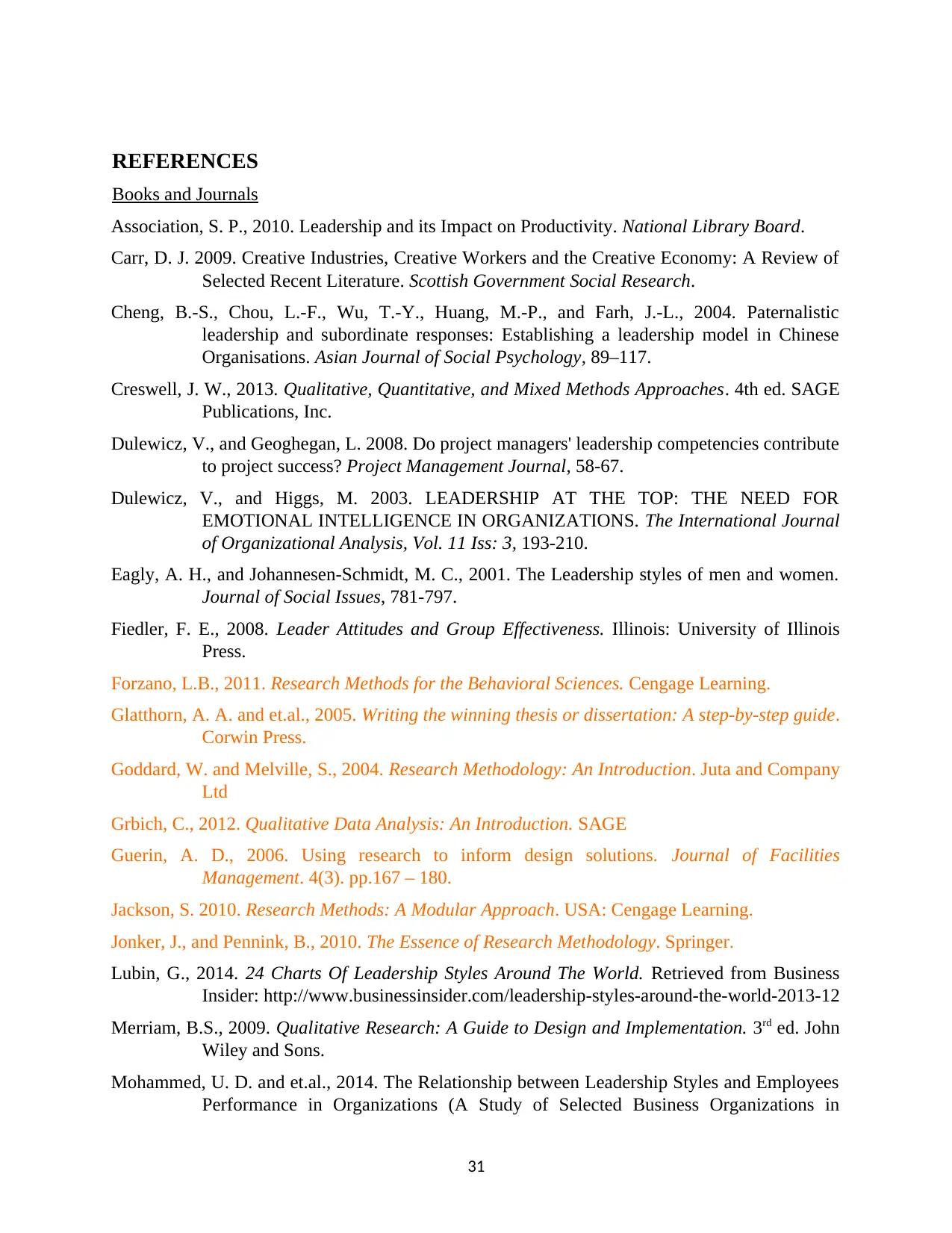
REFERENCES
Books and Journals
Association, S. P., 2010. Leadership and its Impact on Productivity. National Library Board.
Carr, D. J. 2009. Creative Industries, Creative Workers and the Creative Economy: A Review of
Selected Recent Literature. Scottish Government Social Research.
Cheng, B.-S., Chou, L.-F., Wu, T.-Y., Huang, M.-P., and Farh, J.-L., 2004. Paternalistic
leadership and subordinate responses: Establishing a leadership model in Chinese
Organisations. Asian Journal of Social Psychology, 89–117.
Creswell, J. W., 2013. Qualitative, Quantitative, and Mixed Methods Approaches. 4th ed. SAGE
Publications, Inc.
Dulewicz, V., and Geoghegan, L. 2008. Do project managers' leadership competencies contribute
to project success? Project Management Journal, 58-67.
Dulewicz, V., and Higgs, M. 2003. LEADERSHIP AT THE TOP: THE NEED FOR
EMOTIONAL INTELLIGENCE IN ORGANIZATIONS. The International Journal
of Organizational Analysis, Vol. 11 Iss: 3, 193-210.
Eagly, A. H., and Johannesen-Schmidt, M. C., 2001. The Leadership styles of men and women.
Journal of Social Issues, 781-797.
Fiedler, F. E., 2008. Leader Attitudes and Group Effectiveness. Illinois: University of Illinois
Press.
Forzano, L.B., 2011. Research Methods for the Behavioral Sciences. Cengage Learning.
Glatthorn, A. A. and et.al., 2005. Writing the winning thesis or dissertation: A step-by-step guide.
Corwin Press.
Goddard, W. and Melville, S., 2004. Research Methodology: An Introduction. Juta and Company
Ltd
Grbich, C., 2012. Qualitative Data Analysis: An Introduction. SAGE
Guerin, A. D., 2006. Using research to inform design solutions. Journal of Facilities
Management. 4(3). pp.167 – 180.
Jackson, S. 2010. Research Methods: A Modular Approach. USA: Cengage Learning.
Jonker, J., and Pennink, B., 2010. The Essence of Research Methodology. Springer.
Lubin, G., 2014. 24 Charts Of Leadership Styles Around The World. Retrieved from Business
Insider: http://www.businessinsider.com/leadership-styles-around-the-world-2013-12
Merriam, B.S., 2009. Qualitative Research: A Guide to Design and Implementation. 3rd ed. John
Wiley and Sons.
Mohammed, U. D. and et.al., 2014. The Relationship between Leadership Styles and Employees
Performance in Organizations (A Study of Selected Business Organizations in
31
Books and Journals
Association, S. P., 2010. Leadership and its Impact on Productivity. National Library Board.
Carr, D. J. 2009. Creative Industries, Creative Workers and the Creative Economy: A Review of
Selected Recent Literature. Scottish Government Social Research.
Cheng, B.-S., Chou, L.-F., Wu, T.-Y., Huang, M.-P., and Farh, J.-L., 2004. Paternalistic
leadership and subordinate responses: Establishing a leadership model in Chinese
Organisations. Asian Journal of Social Psychology, 89–117.
Creswell, J. W., 2013. Qualitative, Quantitative, and Mixed Methods Approaches. 4th ed. SAGE
Publications, Inc.
Dulewicz, V., and Geoghegan, L. 2008. Do project managers' leadership competencies contribute
to project success? Project Management Journal, 58-67.
Dulewicz, V., and Higgs, M. 2003. LEADERSHIP AT THE TOP: THE NEED FOR
EMOTIONAL INTELLIGENCE IN ORGANIZATIONS. The International Journal
of Organizational Analysis, Vol. 11 Iss: 3, 193-210.
Eagly, A. H., and Johannesen-Schmidt, M. C., 2001. The Leadership styles of men and women.
Journal of Social Issues, 781-797.
Fiedler, F. E., 2008. Leader Attitudes and Group Effectiveness. Illinois: University of Illinois
Press.
Forzano, L.B., 2011. Research Methods for the Behavioral Sciences. Cengage Learning.
Glatthorn, A. A. and et.al., 2005. Writing the winning thesis or dissertation: A step-by-step guide.
Corwin Press.
Goddard, W. and Melville, S., 2004. Research Methodology: An Introduction. Juta and Company
Ltd
Grbich, C., 2012. Qualitative Data Analysis: An Introduction. SAGE
Guerin, A. D., 2006. Using research to inform design solutions. Journal of Facilities
Management. 4(3). pp.167 – 180.
Jackson, S. 2010. Research Methods: A Modular Approach. USA: Cengage Learning.
Jonker, J., and Pennink, B., 2010. The Essence of Research Methodology. Springer.
Lubin, G., 2014. 24 Charts Of Leadership Styles Around The World. Retrieved from Business
Insider: http://www.businessinsider.com/leadership-styles-around-the-world-2013-12
Merriam, B.S., 2009. Qualitative Research: A Guide to Design and Implementation. 3rd ed. John
Wiley and Sons.
Mohammed, U. D. and et.al., 2014. The Relationship between Leadership Styles and Employees
Performance in Organizations (A Study of Selected Business Organizations in
31
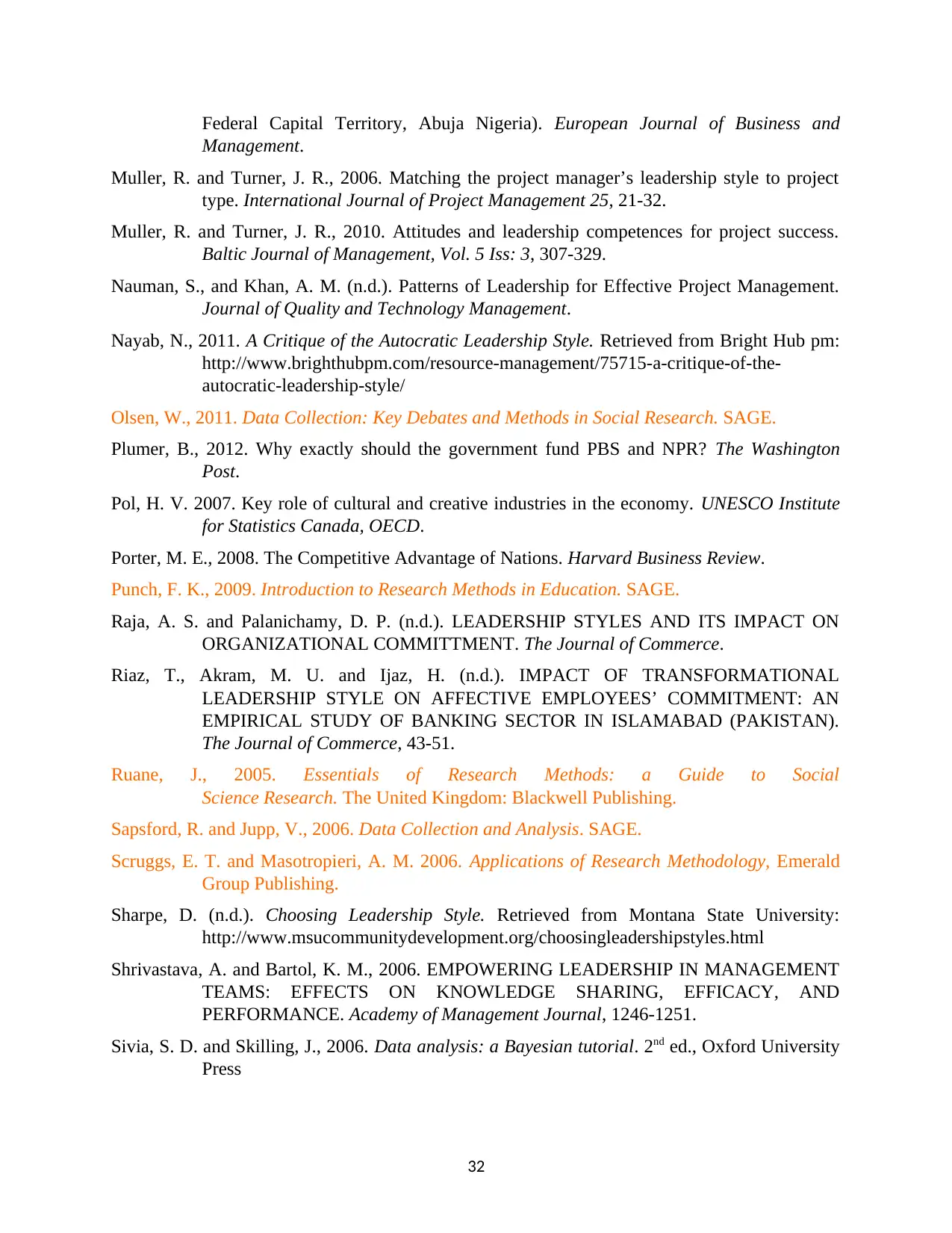
Federal Capital Territory, Abuja Nigeria). European Journal of Business and
Management.
Muller, R. and Turner, J. R., 2006. Matching the project manager’s leadership style to project
type. International Journal of Project Management 25, 21-32.
Muller, R. and Turner, J. R., 2010. Attitudes and leadership competences for project success.
Baltic Journal of Management, Vol. 5 Iss: 3, 307-329.
Nauman, S., and Khan, A. M. (n.d.). Patterns of Leadership for Effective Project Management.
Journal of Quality and Technology Management.
Nayab, N., 2011. A Critique of the Autocratic Leadership Style. Retrieved from Bright Hub pm:
http://www.brighthubpm.com/resource-management/75715-a-critique-of-the-
autocratic-leadership-style/
Olsen, W., 2011. Data Collection: Key Debates and Methods in Social Research. SAGE.
Plumer, B., 2012. Why exactly should the government fund PBS and NPR? The Washington
Post.
Pol, H. V. 2007. Key role of cultural and creative industries in the economy. UNESCO Institute
for Statistics Canada, OECD.
Porter, M. E., 2008. The Competitive Advantage of Nations. Harvard Business Review.
Punch, F. K., 2009. Introduction to Research Methods in Education. SAGE.
Raja, A. S. and Palanichamy, D. P. (n.d.). LEADERSHIP STYLES AND ITS IMPACT ON
ORGANIZATIONAL COMMITTMENT. The Journal of Commerce.
Riaz, T., Akram, M. U. and Ijaz, H. (n.d.). IMPACT OF TRANSFORMATIONAL
LEADERSHIP STYLE ON AFFECTIVE EMPLOYEES’ COMMITMENT: AN
EMPIRICAL STUDY OF BANKING SECTOR IN ISLAMABAD (PAKISTAN).
The Journal of Commerce, 43-51.
Ruane, J., 2005. Essentials of Research Methods: a Guide to Social
Science Research. The United Kingdom: Blackwell Publishing.
Sapsford, R. and Jupp, V., 2006. Data Collection and Analysis. SAGE.
Scruggs, E. T. and Masotropieri, A. M. 2006. Applications of Research Methodology, Emerald
Group Publishing.
Sharpe, D. (n.d.). Choosing Leadership Style. Retrieved from Montana State University:
http://www.msucommunitydevelopment.org/choosingleadershipstyles.html
Shrivastava, A. and Bartol, K. M., 2006. EMPOWERING LEADERSHIP IN MANAGEMENT
TEAMS: EFFECTS ON KNOWLEDGE SHARING, EFFICACY, AND
PERFORMANCE. Academy of Management Journal, 1246-1251.
Sivia, S. D. and Skilling, J., 2006. Data analysis: a Bayesian tutorial. 2nd ed., Oxford University
Press
32
Management.
Muller, R. and Turner, J. R., 2006. Matching the project manager’s leadership style to project
type. International Journal of Project Management 25, 21-32.
Muller, R. and Turner, J. R., 2010. Attitudes and leadership competences for project success.
Baltic Journal of Management, Vol. 5 Iss: 3, 307-329.
Nauman, S., and Khan, A. M. (n.d.). Patterns of Leadership for Effective Project Management.
Journal of Quality and Technology Management.
Nayab, N., 2011. A Critique of the Autocratic Leadership Style. Retrieved from Bright Hub pm:
http://www.brighthubpm.com/resource-management/75715-a-critique-of-the-
autocratic-leadership-style/
Olsen, W., 2011. Data Collection: Key Debates and Methods in Social Research. SAGE.
Plumer, B., 2012. Why exactly should the government fund PBS and NPR? The Washington
Post.
Pol, H. V. 2007. Key role of cultural and creative industries in the economy. UNESCO Institute
for Statistics Canada, OECD.
Porter, M. E., 2008. The Competitive Advantage of Nations. Harvard Business Review.
Punch, F. K., 2009. Introduction to Research Methods in Education. SAGE.
Raja, A. S. and Palanichamy, D. P. (n.d.). LEADERSHIP STYLES AND ITS IMPACT ON
ORGANIZATIONAL COMMITTMENT. The Journal of Commerce.
Riaz, T., Akram, M. U. and Ijaz, H. (n.d.). IMPACT OF TRANSFORMATIONAL
LEADERSHIP STYLE ON AFFECTIVE EMPLOYEES’ COMMITMENT: AN
EMPIRICAL STUDY OF BANKING SECTOR IN ISLAMABAD (PAKISTAN).
The Journal of Commerce, 43-51.
Ruane, J., 2005. Essentials of Research Methods: a Guide to Social
Science Research. The United Kingdom: Blackwell Publishing.
Sapsford, R. and Jupp, V., 2006. Data Collection and Analysis. SAGE.
Scruggs, E. T. and Masotropieri, A. M. 2006. Applications of Research Methodology, Emerald
Group Publishing.
Sharpe, D. (n.d.). Choosing Leadership Style. Retrieved from Montana State University:
http://www.msucommunitydevelopment.org/choosingleadershipstyles.html
Shrivastava, A. and Bartol, K. M., 2006. EMPOWERING LEADERSHIP IN MANAGEMENT
TEAMS: EFFECTS ON KNOWLEDGE SHARING, EFFICACY, AND
PERFORMANCE. Academy of Management Journal, 1246-1251.
Sivia, S. D. and Skilling, J., 2006. Data analysis: a Bayesian tutorial. 2nd ed., Oxford University
Press
32

Understanding Creative Industries. (n.d.). United Nations Educational, Scientific and Cultural
Organization.
33
Organization.
33
1 out of 61
Related Documents
Your All-in-One AI-Powered Toolkit for Academic Success.
+13062052269
info@desklib.com
Available 24*7 on WhatsApp / Email
![[object Object]](/_next/static/media/star-bottom.7253800d.svg)
Unlock your academic potential
© 2024 | Zucol Services PVT LTD | All rights reserved.





